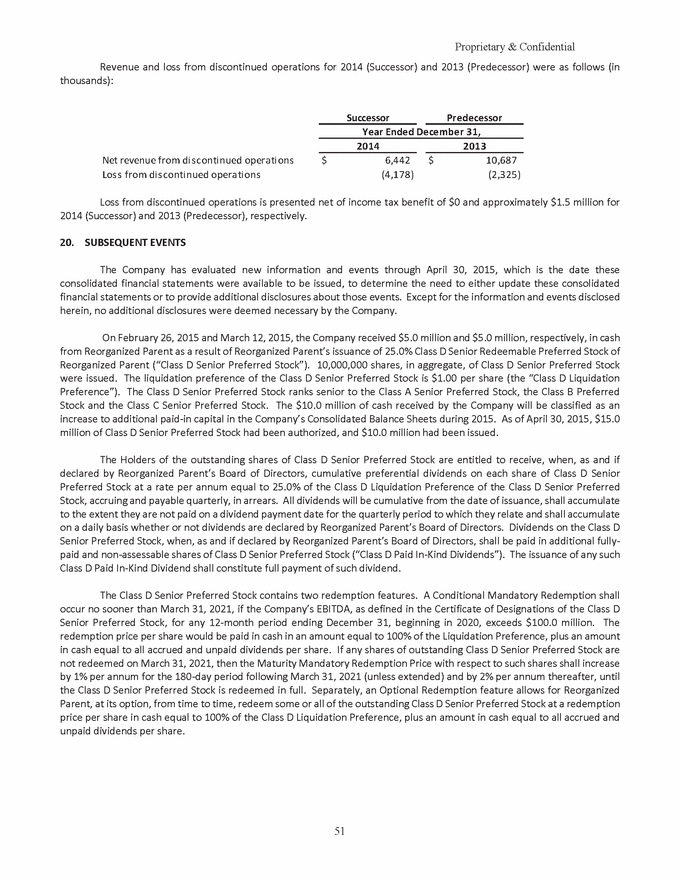Attached files
| file | filename |
|---|---|
| 8-K - 8-K - Envision Healthcare Holdings, Inc. | a15-22030_18k.htm |
Exhibit 99.1
Proprietary & Confidential RURAL/METRO CORPORATION (a wholly-owned subsidiary of WP Rocket Holdings Inc.) CONSOLIDATED FINANCIAL STATEMENTS WITH REPORT OF INDEPENDENT AUDITORS FOR THE YEARS ENDED DECEMBER 31, 2014 AND 2013
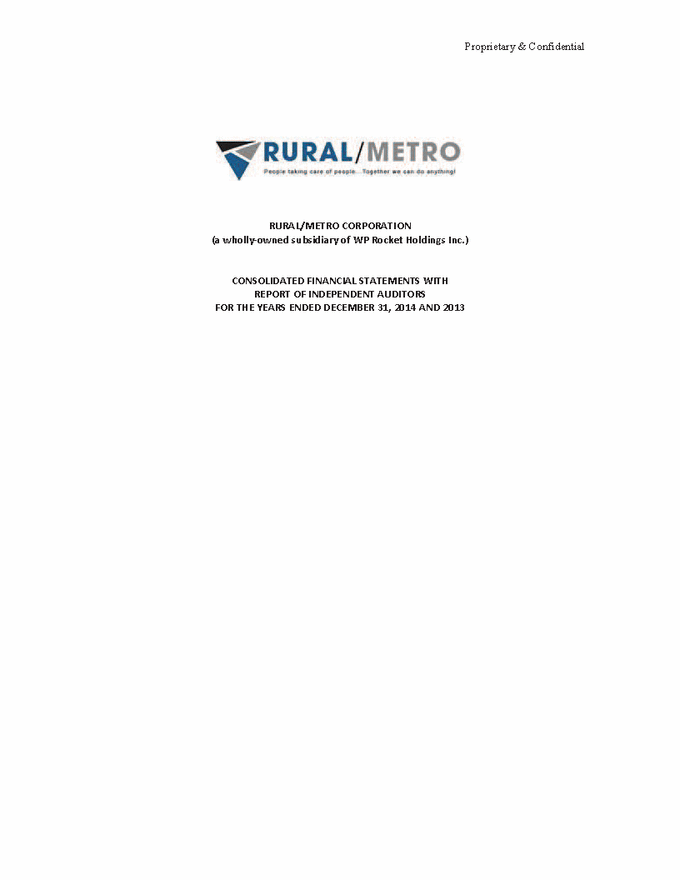
KPMG LLP Suite 800 60 East Rio Salado Parkway Tempe, AZ 85281-9125 Independent Auditors’ Report The Board of Directors Rural/Metro Corporation: We have audited the accompanying consolidated financial statements of Rural/Metro Corporation (a wholly owned subsidiary of WP Rocket Holdings, Inc), which comprise the consolidated balance sheets as of December 31, 2014 (Successor) and 2013 (Successor), and the related consolidated statements of operations and comprehensive loss, changes in stockholder’s equity, and cash flows for the years ended December 31, 2014 (Successor) and 2013 (Predecessor), respectively, and the related notes to the consolidated financial statements. Management’s Responsibility for the Financial Statements Management is responsible for the preparation and fair presentation of these consolidated financial statements in accordance with U.S. generally accepted accounting principles; this includes the design, implementation, and maintenance of internal control relevant to the preparation and fair presentation of consolidated financial statements that are free from material misstatement, whether due to fraud or error. Auditors’ Responsibility Our responsibility is to express an opinion on these consolidated financial statements based on our audits. We conducted our audits in accordance with auditing standards generally accepted in the United States of America. Those standards require that we plan and perform the audit to obtain reasonable assurance about whether the consolidated financial statements are free from material misstatement. An audit involves performing procedures to obtain audit evidence about the amounts and disclosures in the consolidated financial statements. The procedures selected depend on the auditors’ judgment, including the assessment of the risks of material misstatement of the consolidated financial statements, whether due to fraud or error. In making those risk assessments, the auditor considers internal control relevant to the entity’s preparation and fair presentation of the consolidated financial statements in order to design audit procedures that are appropriate in the circumstances, but not for the purpose of expressing an opinion on the effectiveness of the entity’s internal control. Accordingly, we express no such opinion. An audit also includes evaluating the appropriateness of accounting policies used and the reasonableness of significant accounting estimates made by management, as well as evaluating the overall presentation of the consolidated financial statements. We believe that the audit evidence we have obtained is sufficient and appropriate to provide a basis for our audit opinion. KPMG LLP is a Delaware limited liability partnership, the U.S. member firm of KPMG International Cooperative (“KPMG International”), a Swiss entity.
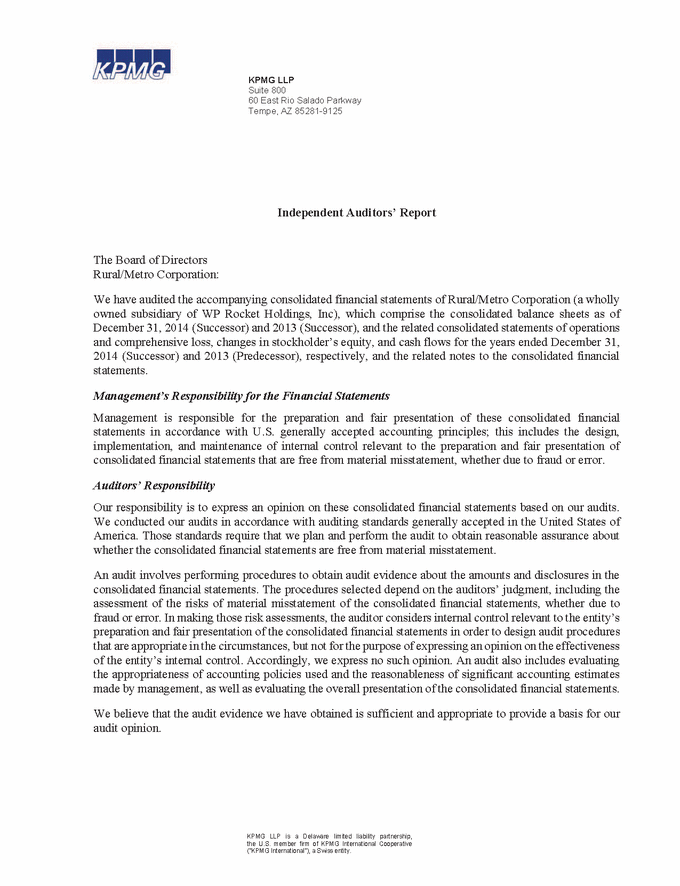
Opinion In our opinion, the consolidated financial statements referred to above present fairly, in all material respects, the financial position of Rural/Metro Corporation and its subsidiaries as of December 31, 2014 (Successor) and 2013 (Successor), and the results of their operations and their cash flows for the years ended December 31, 2014 (Successor) and 2013 (Predecessor), respectively, in accordance with U.S. generally accepted accounting principles. Emphasis of Matter As discussed in note 2 to the consolidated financial statements, the Company filed for reorganization under Chapter 11 of the United States Bankruptcy Code on August 4, 2013. The Company’s plan of reorganization became effective, and the Company emerged from bankruptcy protection on December 31, 2013. In connection with its emergence from bankruptcy, the Successor adopted fresh-start reporting as of December 31, 2013, as further described in note 2 to the consolidated financial statements. As a result, the consolidated financial statements of the Successor are presented on a different basis than those of the Predecessor and, therefore, are not comparable in all respect. Phoenix, Arizona April 30, 2015 2
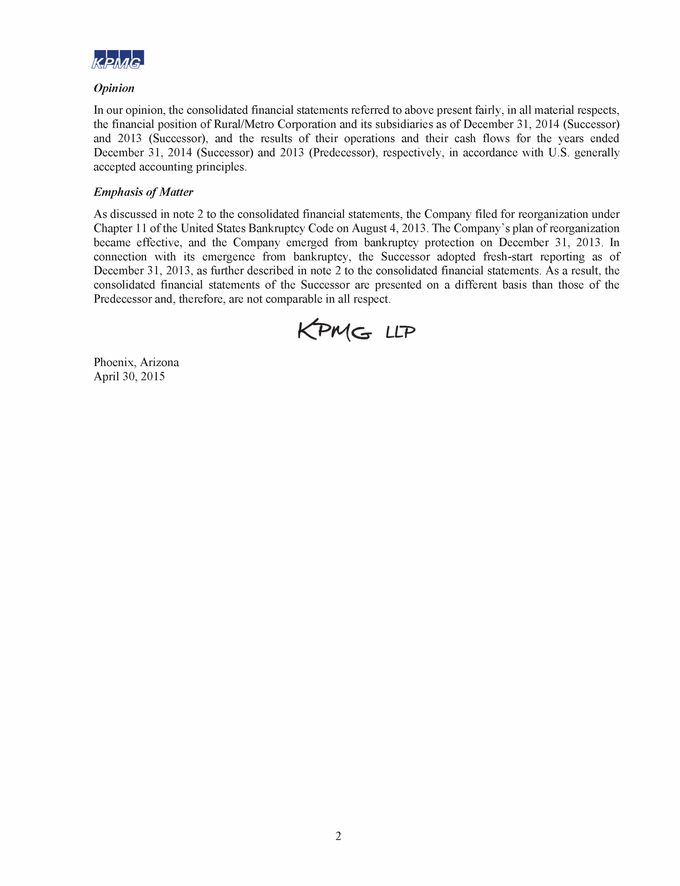
Proprietary & Confidential RURAL/METRO CORPORATION (a wholly-owned subsidiary of WP Rocket Holdings Inc.) CONSOLIDATED BALANCE SHEETS (in thousands, except share data) Successor December 31, 2014 2013 ASSETS Current assets: Cash and cash equivalents Restricted cash Accounts receivable, net Inventories Deferred tax assets, net Prepaid expenses and other current assets Total current assets Property and equipment, net Goodwill Intangible assets, net Deposits Other assets Total assets $ 26,094 1,655 156,575 7,334 33,566 $ 48,195 14,959 91,230 7,801 26,150 11,233 14,542 236,457 71,659 155,512 203,354 43,573 6,701 202,877 66,872 155,512 217,923 43,785 5,913 $ 717,256 $ 692,882 LIABILITIES AND STOCKHOLDER'S EQUITY Accounts payable Accrued and other current liabilities Deferred revenue Current portion of long-term debt Total current liabilities Long-term debt, net of current portion Deferred tax liabilities, net Other liabilities Total liabilities Commitments and contingencies (Note 17) Stockholder's equity: Common stock, $0.01 par value, 900 shares authorized, 100 shares issued and outstanding Preferred stock, $0.01 par value, 100 shares authorized, zero shares is sued and outstanding Additional paid-in capital Accumulated other comprehensive loss Accumulated deficit Total stockholder's equity Total liabilities and stockholder's equity $ 32,007 43,505 19,702 $ 35,692 35,405 20,159 25,805 754 121,019 382,817 108,866 41,092 92,010 381,307 101,450 31,972 653,794 606,739 - - - 111,370 (2,091) (45,817) - 86,143 - - 63,462 86,143 $ 717,256 $ 692,882 See accompanying notes to consolidated financial statements. 3
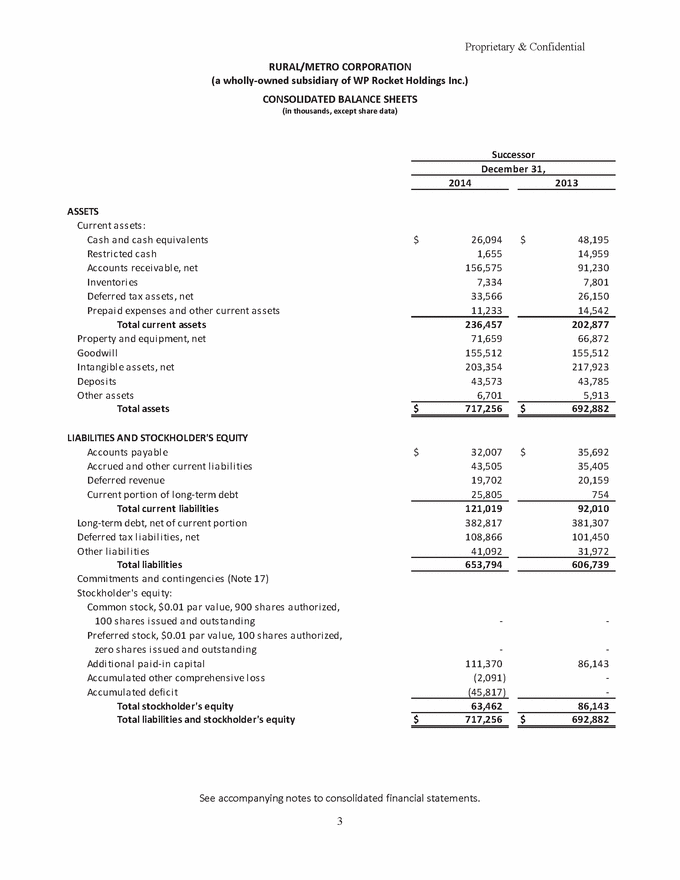
Proprietary & Confidential RURAL/METRO CORPORATION (a wholly-owned subsidiary of WP Rocket Holdings Inc.) CONSOLIDATED STATEMENTS OF OPERATIONS AND COMPREHENSIVE LOSS (in thousands) Successor Predecessor Year Ended December 31, 2014 2013 Net revenue: Ambulance services and other revenue, net of contractual discounts Provision for uncompensated care Net revenue, ambulance services and other Other EMS and fire revenue Total net revenue Operating expenses: Payroll and employee benefits Depreciation and amortization Other operating expenses General/auto liability insurance expense Impairment of property and equipment, goodwill and intangible assets Loss (gain) on sale of assets and property and equipment Total operating expenses Operating loss Reorganization items, net Interest expense Interest income Loss from continuing operations before income taxes Income tax expense Loss from continuing operations Loss from discontinued operations, net of income taxes Net loss Other comprehensive income, net of tax: Defined benefit pension plan: Net (loss) gain Total other comprehensive income, net of tax Comprehensive loss $ 781,011 $ 830,818 (264,925) (285,136) 516,086 93,124 545,682 96,270 609,210 641,952 390,108 30,660 179,218 7,541 410,936 37,610 194,299 10,676 2,346 83 397,079 (2,085) 609,956 1,048,515 (746) (1,613) (36,980) 69 (406,563) 293,821 (53,931) 208 (39,270) (2,369) (166,465) (35,792) (41,639) (202,257) (4,178) (2,325) (45,817) (204,582) (2,091) 3,698 (2,091) 3,698 $ (47,908) $ (200,884) See accompanying notes to consolidated financial statements. 4
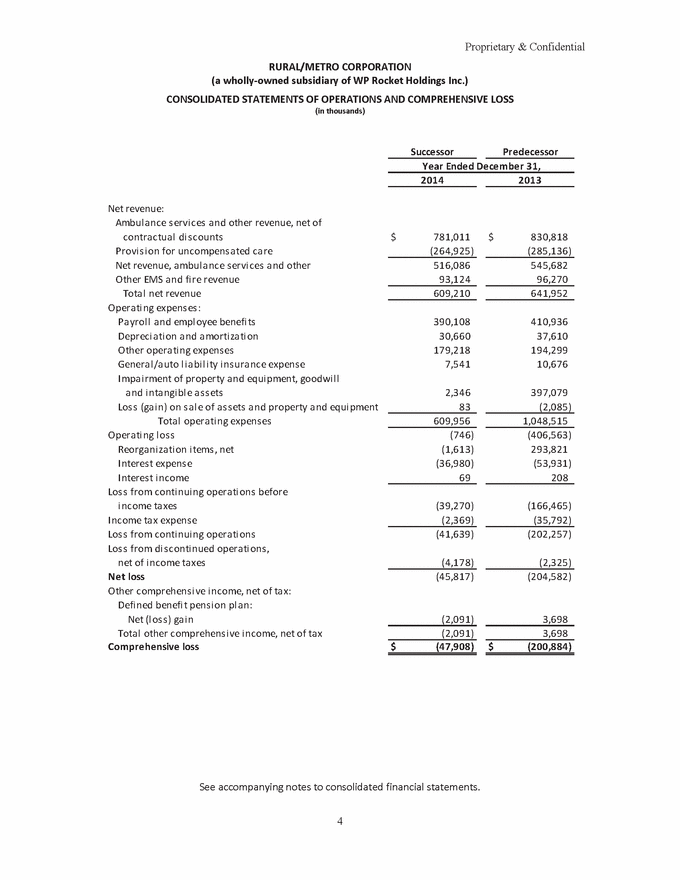
Proprietary & Confidential RURAL/METRO CORPORATION (a wholly-owned subsidiary of WP Rocket Holdings Inc.) CONSOLIDATED STATEMENTS OF CHANGES IN STOCKHOLDER’S EQUITY (in thousands, except share amounts) Common Stock Number of Shares Preferred Stock Number of Shares Accumulated Other Comprehensive (Loss) Income Additional Paid-in Capital Common Stock Preferred Stock Accumulated Deficit Total Balance at December 31, 2012 (Predecessor) Capital distribution to Parent Share-based compensation expense Net loss Other comprehensive income, net of tax Defined benefit pension plan: Net gain Effect of revaluation of Predecessor assets and liabilities Elimination of Predecessor equity Proceeds from Rights Offering of Reorganized Parent Adjustment of goodwill to the excess of reorganization value over the fair value of Company assets Balance at December 31, 2013 (Successor) Share-based compensation expense Net loss Other comprehensive income, net of tax Defined benefit pension plan: Net loss Net proceeds from Reorganized Parent's issuance of preferred stock Balance at December 31, 2014 (Successor) 100 - - - $ - - - - - - - - $ - - - - $ 243,466 (197) 101 - $ (1,576) - - - $ (80,808) - - (204,582) $ 161,082 (197) 101 (204,582) - - - - - 3,698 - 3,698 - - - - - - - - - - - - (164,471) (283,268) 135,000 - (2,122) - - 285,390 - (164,471) - 135,000 - - - - 155,512 - - 155,512 100 - - - - - 86,143 240 - - - 86,143 240 (45,817) - - - - - - - - - (45,817) - - - - - (2,091) - (2,091) - - - - 24,987 - - 24,987 100 $ - - $ - $ 111,370 $ (2,091) $ (45,817) $ 63,462 See accompanying notes to consolidated financial statements. 5
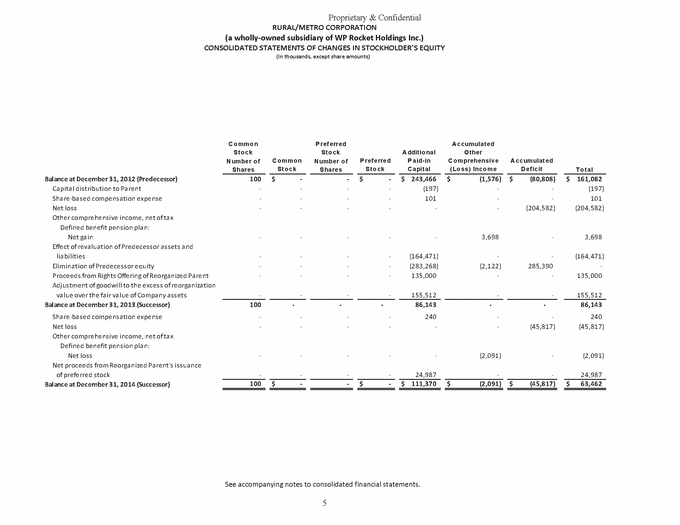
Proprietary & Confidential RURAL/METRO CORPORATION (a wholly-owned subsidiary of WP Rocket Holdings Inc.) CONSOLIDATED STATEMENTS OF CASH FLOWS (in thousands) Successor Predecessor Year Ended December 31, 2014 2013 Cash flows from operating activities: Net loss Adjustments to reconcile net loss to net cash used in operating activities: Depreciation and amortization Accretion of debt Amortization of debt issuance costs Accretion of interest on debt Deferred income taxes Share-based compensation expense Loss (gain) on sale of assets and property and equipment Impairment of property and equipment, goodwill and intangible assets Non-cash debt-related reorganization items, net Other non-cash adjustments Change in assets and liabilities: Accounts receivable, net Inventories Prepaid expenses and other current assets Deposits Other assets Accounts payable Accrued and other current liabilities Deferred revenue Other liabilities Net cash used in operating activities Cash flows from investing activities: Purchase of property and equipment Cash paid for acquisitions Proceeds from the sale/disposal of property and equipment Decrease (increase) in restricted cash Net cash used in investing activities Cash flows from financing activities: Borrowings on Working Capital Loan Borrowings on revolving credit facility Payments on revolving credit facility Borrowings on DIP Financing Payments on DIP Financing Payments on Term loan Payments on capital leases Reduction of Deposits related to Backs top Loan Payments on Backs top Loan Debt issuance costs Proceeds received from Reorganized Parent's issuance of equity Capital distribution to Parent Net cash provided by financing activities (Decrease) increase in cash and cash equivalents Cash and cash equivalents, beginning of period Cash and cash equivalents, end of period Supplemental disclosure of non-cash investing and financing activities: Property and equipment funded by liabilities Capital lease as sets funded by liabilities Supplemental cash flow information: Cash paid for interest Cash paid for income taxes, net of refunds $ (45,817) $ (204,582) 31,091 - 1,024 4,243 - 240 444 2,346 - - 38,068 1,643 5,957 248 35,508 101 (1,969) 397,079 (282,357) 7 (65,061) 467 3,309 (224) 1,518 (4,452) 8,100 (457) 7,029 7,886 355 (7,068) (170) 3,908 11,272 (29,104) (384) (8,948) (56,200) (32,550) (23,734) - 431 13,304 (24,453) (67) 5,673 (14,959) (9,999) (33,806) 23,211 - - - - - (813) 436 (436) (3,287) 24,987 - - 54,000 (28,804) 75,000 (75,238) (42,828) (695) - - (6,340) 135,000 (197) 44,098 109,898 (22,101) 48,195 43,542 4,653 $ 26,094 $ 48,195 $ 976 313 $ 209 3,613 $ 25,863 36 $ 42,342 467 See accompanying notes to consolidated financial statements. 6
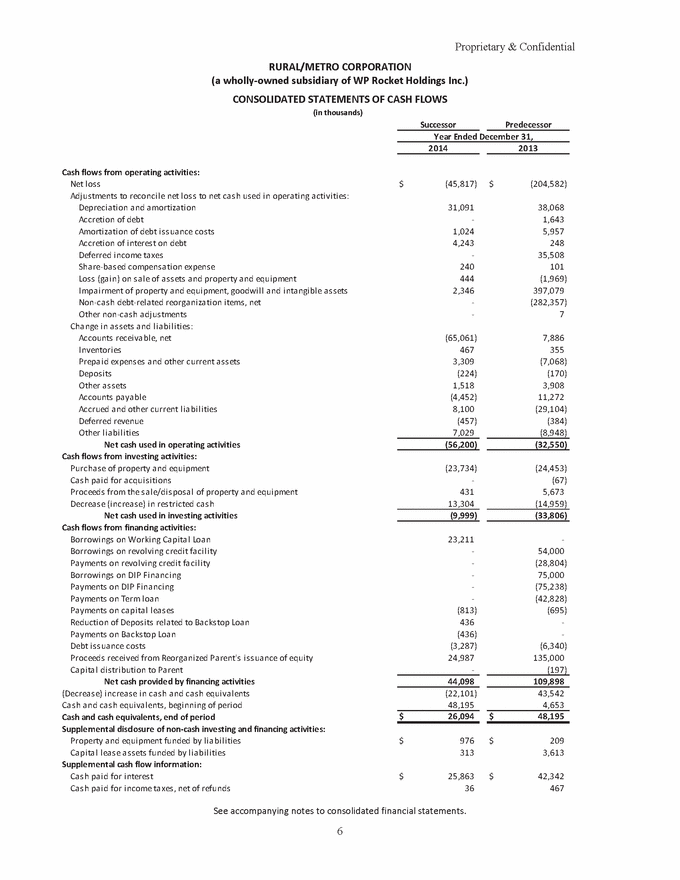
Proprietary & Confidential RURAL/METRO CORPORATION (a wholly-owned subsidiary of WP Rocket Holdings Inc.) NOTES TO CONSOLIDATED FINANCIAL STATEMENTS 1. ORGANIZATION AND BASIS OF PRESENTATION Nature of Business and Operations Rural/Metro Corporation, a Delaware corporation, along with its subsidiaries (collectively, the “Company” or “Rural/Metro”) is a leading provider of both emergency and non-emergency ambulance services. These services are provided under contracts with governmental entities, hospitals, nursing homes and other healthcare facilities and organizations. The Company also provides fire protection and related services on a subscription fee basis to residential and commercial property owners and under long-term contracts with fire districts, industrial sites and airports. These services consist primarily of fire suppression, fire prevention and first responder medical care. Since June 30, 2011, the Company has been a wholly-owned subsidiary of WP Rocket Holdings Inc., a Delaware corporation (“Parent”), which was an affiliate of Warburg Pincus LLC (“Warburg”) formed by Warburg in order to acquire the Company on that date. On August 4, 2013, the Company, Parent and substantially all of the Company’s subsidiaries filed voluntary petitions for reorganization under Chapter 11 of the United States Bankruptcy Code, in the United States Bankruptcy Court for the District of Delaware (the “Bankruptcy Court”). The reorganization cases have been jointly administered under the caption “In re Rural/Metro Corporation et al., Case No. 13-11952 (KJC)”. On December 17, 2013, the Bankruptcy Court confirmed the Company’s Plan of Reorganization. On December 31, 2013, the Company formally emerged from Chapter 11, upon which Warburg no longer has any ownership interests in Parent or the Company. See Note 2 for further details regarding the Bankruptcy events and the post-emergence structure of the Company. Principles of Consolidation The accompanying consolidated financial statements include the accounts of the Company and its wholly-owned subsidiaries. All significant intercompany accounts and transactions have been eliminated. Change in Fiscal Year Upon its emergence from Chapter 11 on December 31, 2013, the Company changed its fiscal year end date from June 30 to December 31. As used herein, the term “Predecessor” refers to the Company prior to its emergence from bankruptcy, while “Successor” refers to the Company subsequent to its emergence from bankruptcy. 2. 2013 FILING FOR CHAPTER 11 BANKRUPTCY REORGANIZATION AND SUBSEQUENT EMERGENCE On August 4, 2013 (the “Petition Date”), the Company, Parent and substantially all of the Company’s subsidiaries (collectively, the “Debtors,” and subsequent to the emergence from bankruptcy protection, the “Reorganized Debtors”) filed voluntary petitions for reorganization under Chapter 11 of the United States Bankruptcy Code (the “Bankruptcy Code”), in the United States Bankruptcy Court for the District of Delaware (the “Bankruptcy Court”). The reorganization cases have been jointly administered under the caption “In re Rural/Metro Corporation et al., Case No. 13-11952 (KJC).” On the Petition Date and during the pendency of the case, the Debtors began operating as “debtors-in-possession” under the jurisdiction of the Bankruptcy Court and in accordance with the applicable provisions of the Bankruptcy Code. In general, as debtors-in-possession, the Debtors were authorized under the Bankruptcy Code to continue to operate as an ongoing business, but could not engage in transactions outside the ordinary course of business without the prior approval of the Bankruptcy Court. The Bankruptcy Code enabled the Company to continue to operate its business without interruption. Concurrently with the filing for reorganization under Chapter 11, the Company and Parent reached an agreement-in-principal on a comprehensive financial restructuring plan intended to strengthen the Company’s balance sheet and reduce future interest expense by reducing its funded indebtedness by approximately 50 percent via a conversion of certain debt to 7

Proprietary & Confidential equity. The Company reached the agreement-in-principal on the terms of the prearranged financial restructuring plan with the majority of its senior lenders and greater than two-thirds of its bondholders. The Company also received a commitment for $75 million in debtor-in-possession financing (“DIP Financing”) from certain of the Company’s secured lenders. The DIP Financing, combined with cash generated by the Company’s ongoing operations, was intended to provide the Company with sufficient liquidity to meet its operational and restructuring needs during the Chapter 11 process. On August 6, 2013, the Bankruptcy Court granted interim approval for the Company to utilize up to $40 million of the DIP Financing, and on September 10, 2013, the Bankruptcy Court granted final approval for the Company to utilize the remaining $35 million of the DIP Financing. The Predecessor Company’s bondholders committed to invest $135 million of additional new equity in WP Rocket Holdings Inc. upon emergence (“Reorganized Parent”) upon the successful completion of the Chapter 11 financial restructuring, pursuant to a commitment agreement dated October 31, 2013. Magnitude of Potential Claims The Plan of Reorganization created a specific pool to satisfy the claims of unsecured creditors. Accordingly, all unsecured creditors were provided the option to elect to receive either a pro-rata share of a pool of funds set aside to pay unsecured creditors or common stock in the Reorganized Parent. The pool of funds set aside to pay unsecured creditors pursuant to the Plan of Reorganization was a minimum amount of $4.0 million and a maximum amount of $5.0 million. On August 26, 2013, the Bankruptcy Court entered an order that established October 23, 2013 at 5:00 p.m. (Eastern Time) as the deadline to file proofs of claim against any Debtor, and established January 31, 2014 at 5:00 p.m. (Eastern Time) as the deadline for governmental units, as defined in section 101(27) of the Bankruptcy Code, to file proofs of claim against any Debtor. As of March 31, 2015, over 3,000 claims have been filed against the Debtors. Many of the claims are unliquidated and do not specify damages. In addition, there is the potential for amended claims to continue to be filed. The Company has identified, and expects to continue reconciling, claims that it believes should be disallowed by the Bankruptcy Court because they are satisfied, duplicative, are without merit, are overstated or for other reasons. As of March 31, 2015, as a result of twelve omnibus objections filed by the Debtors, the Bankruptcy Court has disallowed a majority of these claims. The Company expects to continue to file objections in the future. Differences between amounts scheduled by the Debtors and claims by creditors were and will continue to be investigated and resolved in connection with the claims resolution process. In light of the expected number of creditor claims and the status of unliquidated litigation claims, the claims resolution process may take additional considerable time to complete. Accordingly, the ultimate number and amount of allowed claims is not presently known, nor can the ultimate recovery with respect to allowed claims be presently ascertained. Plan of Reorganization and Equity Instruments of Reorganized Parent On September 15, 2013, the Debtors filed the Joint Chapter 11 Plan of Reorganization for Rural/Metro Corporation and Its Affiliated Debtors (the “Plan of Reorganization”) and the Disclosure Statement with Respect to Joint Chapter 11 Plan of Reorganization for Rural/Metro Corporation and Its Affiliated Debtors (the “Disclosure Statement”) with the Bankruptcy Court. Each of these documents were amended on October 31, 2013. On November 5, 2013, the Bankruptcy Court approved the Disclosure Statement. On December 2, 2013, the Debtors filed the Plan Supplement, and on December 13, 2013 and December 16, 2013, the Debtors filed amendments to the Plan Supplement. On December 17, 2013, the Bankruptcy Court confirmed the Company’s Plan of Reorganization, as amended. The Plan of Reorganization was effective December 31, 2013. The Plan of Reorganization set forth a restructuring transaction to substantially reduce debt obligations by (i) providing for a $50.0 million payment of the pre-petition Credit Facility and (ii) converting claims arising under the $200.0 million Senior Notes and the $108.0 million Senior Notes (the “Noteholder Claims”) and any unsecured claim against the Debtors other than a Noteholder Claim (the “Other Unsecured Claims”) into 100% of the common stock of Reorganized Parent. 8
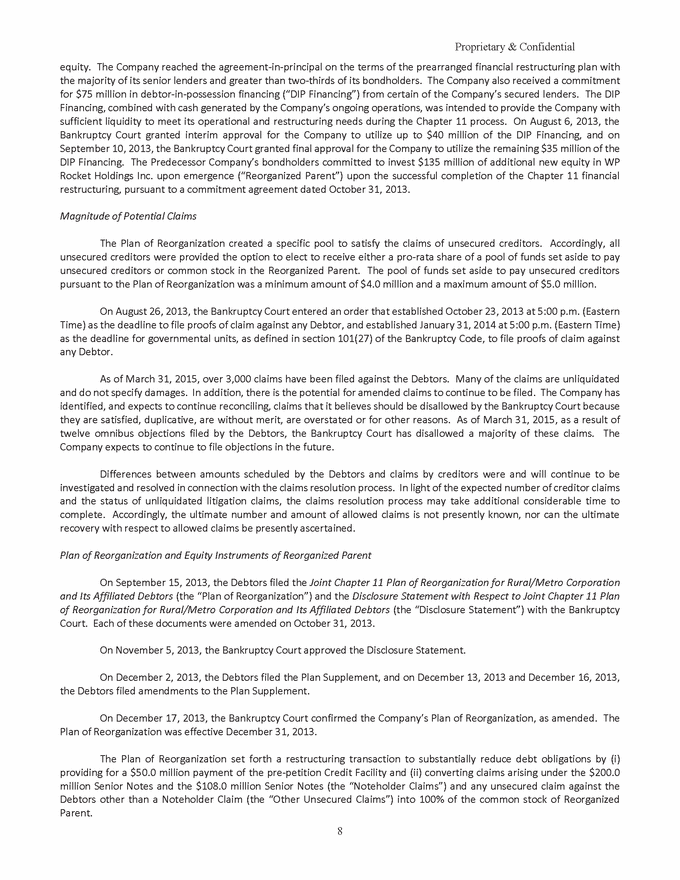
Proprietary & Confidential The common stock of Reorganized Parent was subject to dilution by: (A) options to purchase the common stock of Reorganized Parent that may be issued to the Reorganized Debtors’ post-emergence directors, officers and employees subsequent to emergence and (B) the shares of common stock of Reorganized Parent issued pursuant to the $135.0 million rights offering to be offered to the holders of Noteholder Claims (the “Rights Offering”), including any shares of common stock of Reorganized Parent issued pursuant to the Rights Offering Backup Commitment Agreement. Reorganized Parent’s pre-petition equity holders’ interests were cancelled upon emergence, and all of Reorganized Parent’s common stock is owned by the holders of Noteholder Claims (including those participating in the Rights Offering) and the holders of the Other Unsecured Claims (to the extent such holders of Other Unsecured Claims elected to receive common stock of Reorganized Parent in lieu of cash). Creditors holding other secured claims were to receive cash, their collateral, or retain their liens, as applicable, in satisfaction of their claims. The pre-emergence board of directors of the Debtors were deemed to have resigned on and as of the date of emergence, and were replaced by new board members as specified in the Plan of Reorganization. The Plan of Reorganization was primarily funded by the Rights Offering. Each holder of a Noteholder Claim received Subscription Rights to subscribe for its Pro Rata Share of the Rights Offering Stock (representing common stock of Reorganized Parent (which shall comprise 70% of the fully diluted common stock of Reorganized Parent) and preferred stock of Reorganized Parent) for an aggregate purchase price equal to the applicable Subscription Payment Amount. In accordance with the Rights Offering Backstop Commitment Agreement, the Rights Offering Backstop Investors purchased all Remaining Rights Offering Stock. The Rights Offering provided $135.0 million in capital to the Reorganized Debtors, which was used to pay the outstanding amounts under the $75.0 million DIP Financing as of the date of emergence, fund other payments required under the Plan of Reorganization, including the $50.0 million payment on the pre-petition Credit Facility, and for ordinary course operations and general corporate purposes of the Reorganized Debtors upon emergence. In addition, the Reorganized Debtors’ post-emergence operations were supported by a $41.2 million Exit Letter of Credit Facility. Pursuant to the Certificate of Designation (“COD”) creating the preferred stock, the preferred stock of Reorganized Parent provides for the issuance of up to 500,000,000 shares (amended to 1,000,000,000 shares in 2014) of Senior Redeemable Preferred Stock of Reorganized Parent (as subsequently amended by the COD the “Senior Preferred Stock”). 136,450,000 shares of Class A Senior Preferred Stock of Reorganized Parent were issued as part of the Rights Offering upon the implementation of the Plan of Reorganization on December 31, 2013. The liquidation preference of the Class A Senior Preferred Stock is $1.00 per share (the “Class A Liquidation Preference”). The COD provides that the Holders of the outstanding shares of Class A Senior Preferred Stock are entitled to receive, when, as and if declared by Reorganized Parent’s Board of Directors, cumulative preferential dividends on each share of Class A Senior Preferred Stock at a rate per annum equal to 15% of the Class A Liquidation Preference of the Class A Senior Preferred Stock, accruing quarterly, in arrears. All dividends will be cumulative from the date of issuance, shall accumulate to the extent they are not paid on a dividend payment date for the quarterly period to which they relate and shall accumulate on a daily basis whether or not dividends are declared by Reorganized Parent’s Board of Directors. Dividends on the Class A Senior Preferred Stock, when, as and if declared by Reorganized Parent’s Board of Directors, shall be paid in additional fully-paid and non-assessable shares of Class A Senior Preferred Stock (“Class A Paid In-Kind Dividends”). The issuance of any such Class A Paid In-Kind Dividend shall constitute full payment of such dividend. The Class A Senior Preferred Stock contains two redemption features. A Conditional Mandatory Redemption shall occur no sooner than March 31, 2021, if the Company’s EBITDA, as defined in the Certificate of Designations of the Class A Senior Preferred Stock, for any 12-month period ending December 31, beginning in 2020, exceeds $100.0 million. The redemption price per share would be paid in cash in an amount equal to 100% of the Liquidation Preference, plus an amount in cash equal to all accrued and unpaid dividends per share. If any shares of outstanding Class A Senior Preferred Stock are not redeemed on March 31, 2021, then the Maturity Mandatory Redemption Price with respect to such shares shall increase by 1% per annum for the 180-day period following March 31, 2021 (unless extended) and by 2% per annum thereafter, until the Class A Senior Preferred Stock is redeemed in full. Separately, an Optional Redemption feature allows for Reorganized Parent, at its option, from time to time, redeem some or all of the outstanding Class A Senior Preferred Stock at a redemption 9
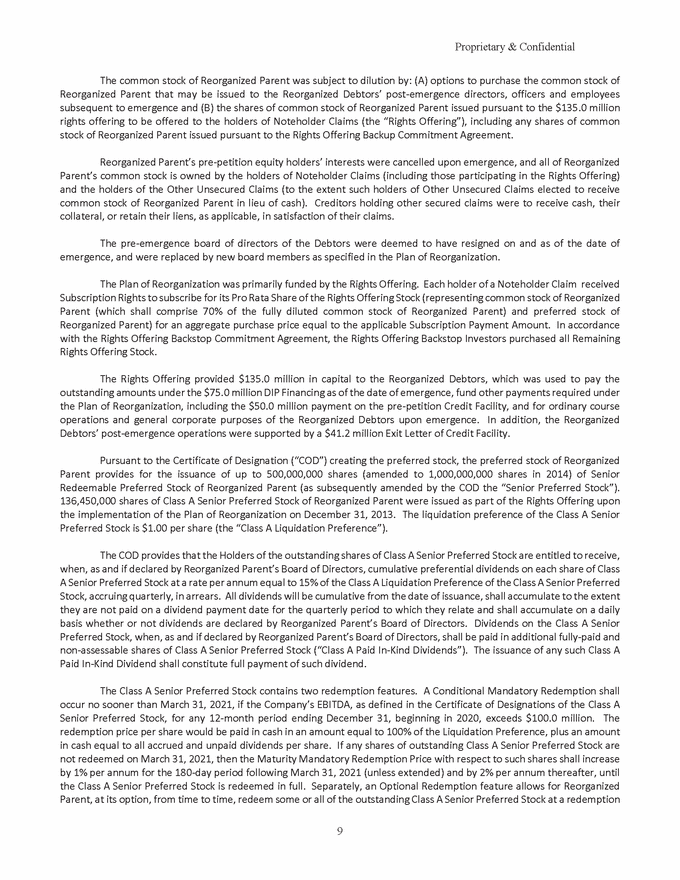
Proprietary & Confidential price per share in cash equal to 100% of the Class A Liquidation Preference, plus an amount in cash equal to all accrued and unpaid dividends per share. Reporting Requirements In connection with the Chapter 11 cases, regardless of the Emergence Date having occurred, the Company is required to continue to file quarterly Trustee operating reports with the Bankruptcy Court until the Chapter 11 Cases have closed. Such reports have been and will be prepared according to requirements of federal bankruptcy law and related rules. While these reports accurately provide then-current information required under the Bankruptcy Code, they are nonetheless unaudited, are prepared in a different format from that used in the Company's consolidated financial statements, and certain of this financial information may be prepared on an unconsolidated basis. Therefore, the Company believes that the substance and format of these reports do not allow for a meaningful comparison to the Company's consolidated financial statements. Emergence, Reorganization and Fresh Start Accounting On December 31, 2013 (the “Emergence Date”), the Company emerged from Chapter 11 bankruptcy protection as the effective date of the confirmed Plan of Reorganization. As of the Emergence Date, the Company adopted fresh start accounting in accordance with FASB Accounting Standards Codification (“ASC”) 852 Reorganizations. The adoption of fresh start accounting resulted in the Company becoming a new entity for financial reporting purposes. Accordingly, the Company’s Consolidated Financial Statements on or after the Emergence Date are not comparable to the Company’s Consolidated Financial Statements prior to that date. Fresh start accounting requires resetting the historical net book values of assets and liabilities of the Company as of the Emergence Date to their fair values by allocating the Company’s reorganization value to its assets and liabilities pursuant to accounting guidance related to ASC 805 Business Combinations and ASC 852-10. Reorganization value is the fair value of the entity before considering liabilities and approximates the amount a willing buyer would pay for the assets of the entity immediately after the reorganization. The excess reorganization value over the fair value of the tangible and identifiable intangible assets was recorded as goodwill on the Company’s Consolidated Balance Sheet as of the Emergence Date. The Company’s reorganization value was principally based upon expected future cash flows of the business, discounted at rates reflecting perceived business and financial risks. The discounted cash flow analysis was based on the Company’s projected financial information which included a variety of estimates and assumptions. While the Company considered such estimates and assumptions reasonable, they were inherently subject to uncertainties and a variety of significant business, economic and competitive risks, many of which are beyond the Company’s control and may not materialize. The discounted cash flow analysis was based upon projections and internal forecasts and assumptions. The discounted cash flow analysis is the sum of (i) the present value of the projected unlevered cash flows; and (ii) the present value of a terminal value, which represents the estimate of value attributable to periods beyond the projected cash flows. All cash flows were discounted using a weighted average cost of capital percentage of 9.4%. To calculate the terminal value, a perpetuity growth rate approach was used. Other significant assumptions included future capital expenditures, future effective tax rates, and changes in working capital requirements. As part of the bankruptcy process, the Company engaged an independent financial advisor to assist in the determination of the Company’s reorganized enterprise value. The independent financial advisor estimated the Company’s reorganized enterprise value to be $376.9 million, which was within the range approved by the Bankruptcy Court. The Company’s net debt was then subtracted to determine the Successor equity value of $86.1 million, which was also within the range approved by the Bankruptcy Court. In addition, cash, deposits, and non-interest bearing liabilities were added to the Company’s reorganized enterprise value to determine the Company’s reorganization value of $692.9 million. 10
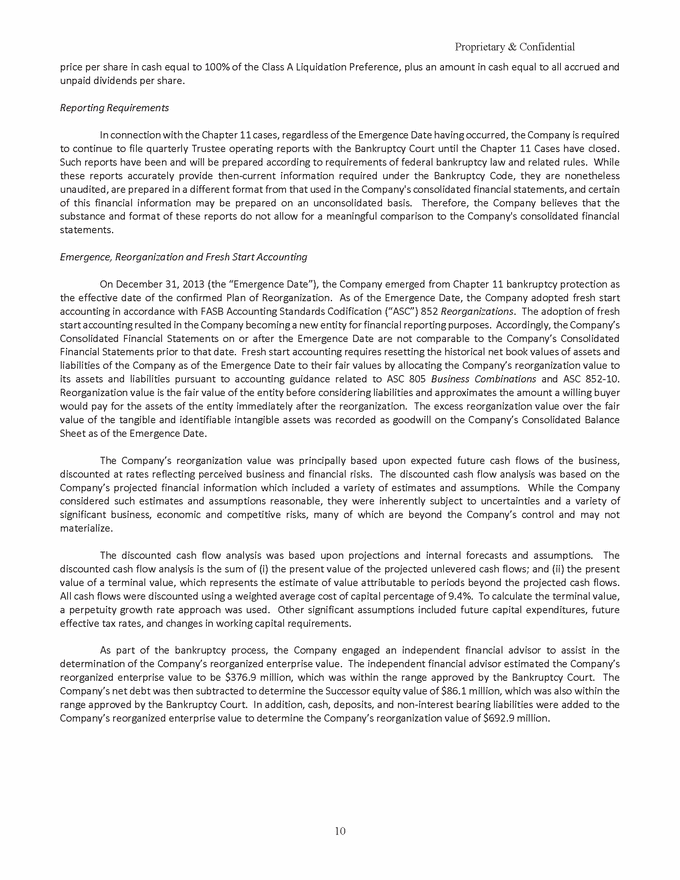
Proprietary & Confidential Reorganization items represent expense or income amounts that have been recognized as a direct result of the Chapter 11 cases and are presented separately in the Company’s Consolidated Statements of Operations and Comprehensive Loss. Such items consist of the following (in thousands): Successor Predecessor Year Ended December 31, 2014 2013 Cancellation of $200 million Seni or Notes Cancellation of $108 million Seni or Notes Cancellation of unsecured liabilities subject to compromise, net of amount expected to be paid (continuing operations ) Cancellation of interest payable related to $200 million Seni or Notes Cancellation of interest payable related to $108 million Seni or Notes Write-off of unamortized di s count related to $108 million Seni or Notes Write-off of unamortized debt issuance costs related to $200 million Seni or Notes Write-off of unamortized debt issuance costs related to $108 million Seni or Notes Write-off of unamortized di s count related to pre-petition Term Loan Write-off of unamortized debt issuance costs related to pre-petition Credit Facility Professional fees Leas e agreement terminations Other Total reorganization items, net (continuing operations) $ - - $ 200,000 108,000 552 - - - - - - - (1,995) - (170) 29,967 11,250 6,045 (12,108) (3,426) (1,630) (2,059) (6,420) (29,005) (3,617) (3,176) $ (1,613) $ 293,821 11
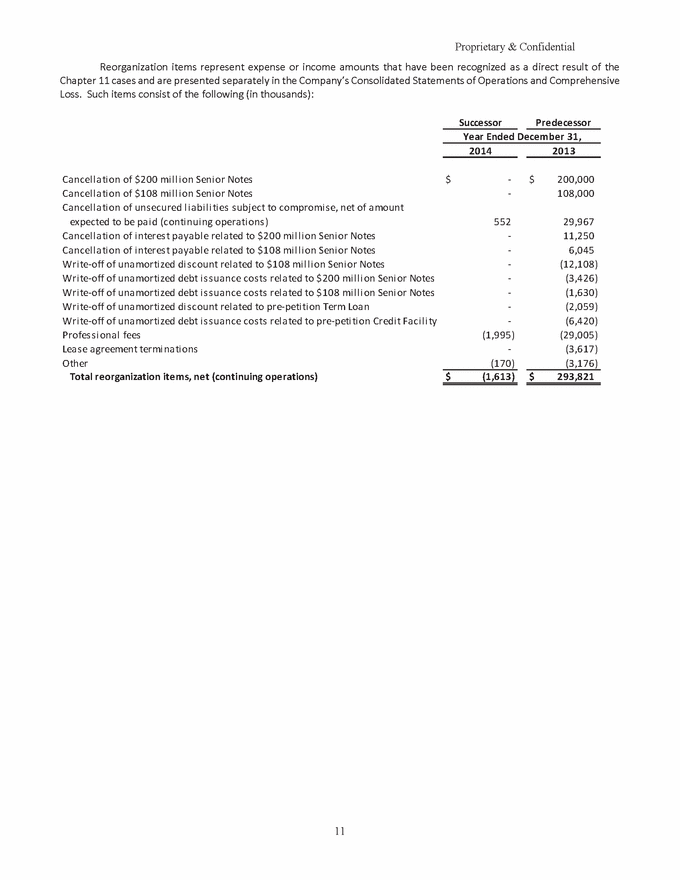
Proprietary & Confidential The following balance sheet illustrates the impact of the implementation of the Plan of Reorganization and the application of fresh start accounting, resulting in the opening balance sheet of the Successor (in thousands): As of December 31, 2013 Reorganization Adjustments (a) Fresh Start Adjustments (b) Predecessor Successor ASSETS Current assets: Cash and cash equivalents Restricted cash Accounts receivable, net Inventories Deferred income taxes, net Prepaid expenses and other current assets Total current assets Property and equipment, net Goodwill Intangibles assets, net Deposits Deferred income taxes, net Other assets Total assets $ 58,819 900 91,230 7,801 28,465 $ (10,624) (c) $ - - - - 23 $ 48,195 14,959 91,230 7,801 26,150 14,059 - - (d) (2,338) (e) 94 (n) 13,931 517 (o) 14,542 201,146 67,081 166,740 214,479 3,633 22,993 13,625 1,191 - - - 40,152 540 (209) (p) (11,228) (q) 202,877 66,872 155,512 217,923 43,785 - 5,913 3,444 - - (r) (f) (22,993) (e) (8,742) (g) 1,030 (o) $ 689,697 $ 9,608 $ (6,423) $ 692,882 LIABILITIES AND STOCKHOLDER'S (DEFICIT) EQUITY Accounts payable Accrued and other current liabilities Deferred revenue Current portion of long-term debt Total current liabilities Long-term debt, net of current portion Deferred income taxes, net Other liabilities Total long-term liabilities Li abilities subject to compromise Total liabilities Stockholder's (deficit) equity: Common s tock Preferred s tock Additional paid-in capital - Predecessor Additional paid-in capital - Success or Accumulated other comprehensive income Accumulated deficit Total stockholder's (deficit) equity Total liabilities and stockholder's (deficit) equity $ 35,692 37,624 20,159 $ - (2,796) (h) - $ - 577 - $ 35,692 35,405 20,159 (s ) 73,792 (73,038) (i ) - 754 167,267 389,052 - 28,867 (75,834) (7,745) (j ) 102,596 (e) - 577 - (1,146) (n) 3,105 (t) 92,010 381,307 101,450 31,972 417,919 94,851 1,959 514,729 346,644 (346,644) (k) - - 931,830 (327,627) 2,536 606,739 - - 243,370 - 2,111 (487,614) - - - 135,000 11 - - (243,370) (u) (48,857) (v) (2,122) (w) 285,390 (x) - - - 86,143 - - (l ) 202,224 (m) (242,133) 337,235 (8,959) 86,143 $ 689,697 $ 9,608 $ (6,423) $ 692,882 (a) Represents amounts recorded for the implementation of the Plan of Reorganization on the Emergence Date. This includes the settlement of liabilities subject to compromise, the receipt of cash upon the issuance of new equity instruments, paydowns of existing debt and accrued interest, establishment of new debt, payments of debt issuance costs and the designation of restricted cash to satisfy allowed claims and outstanding professional fees. (b) Represents the adjustments of assets and liabilities to fair value or other measurement with adoption of fresh start accounting. 12
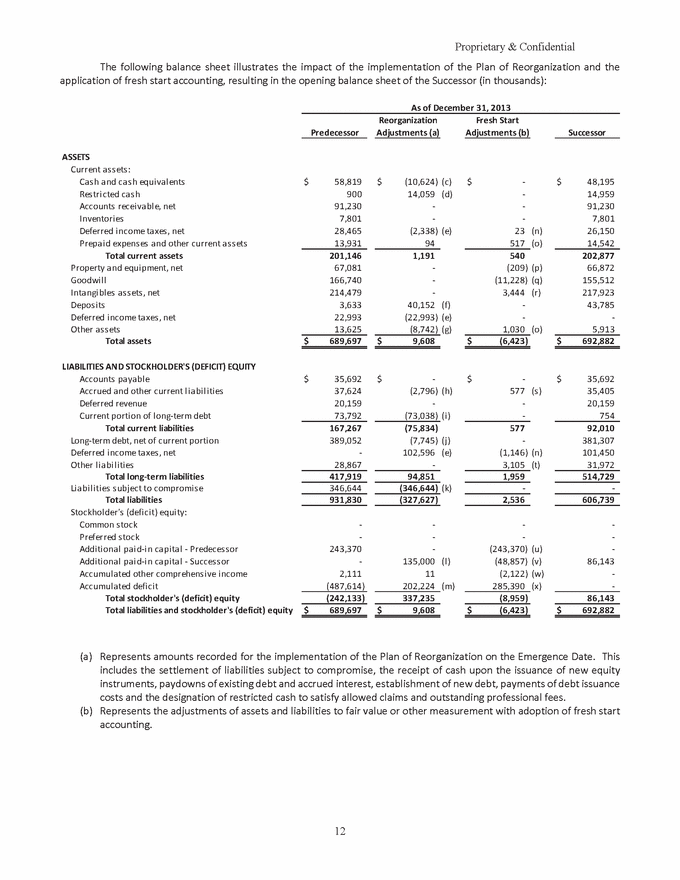
Proprietary & Confidential (c) Records the following cash activity (in thousands): Proceeds received from Rights Offering of Reorganized Parent Repayment of DIP Financing, including accreted interest Partial repayment of pre-petition Credit Facility Payment of accrued interest on DIP Financing and the pre-petition Credit Facility Payment of debt issuance and other costs Depos i t returned for collaterized Letters of Credit Designation of restricted cash for the payment of professional fees related to bankruptcy Designation of restricted cash to satisfy allowed claims $ 135,000 (73,038) (50,000) (2,796) (2,834) 2,103 (14,059) (5,000) $ (10,624) (d) Records the designation of $14.1 million of restricted cash for the payment of professional fees related to the bankruptcy. Records the impact on net deferred income tax assets and liabilities related to the net gain recorded as a result of the implementation of the Plan of Reorganization. Records the $42.3 million capitalization of the Backstop Loan for collateralized letters of credit, net of the return of $2.1 million of cash deposits held by Credit Suisse AG. Records the write-off of $11.5 million of unamortized debt issuance costs related to pre-petition debt, partially offset by the payment of $2.7 million of debt issuance costs related to new and converted debt. Records the payment of outstanding interest payable on the DIP Financing and the pre-petition Credit Facility. Records the payoff of the DIP Financing, including $0.2 million of accreted interest. Records the $50.0 million payment on the pre-petition Credit Facility, partially offset by the establishment of the $42.3 million Backstop Loan for collateralized letters of credit. Records the cancellation of liabilities subject to compromise. The $346.6 million net gain recognized as a result of the cancellation of liabilities subject to compromise was comprised of the following (in thousands): (e) (f) (g) (h) (i) (j) (k) Cancellation of $200 million Seni or Notes Cancellation of $108 million Seni or Notes Write-off unamortized di s count on $108 million Seni or Notes Write-off unamortized di s count on pre-petition Term Loan Cancellation of other unsecured liabilities Cancellation of interest payable on $200 million Seni or Notes and $108 million Seni or Notes $ (200,000) (108,000) 12,108 2,059 (35,516) (17,295) $ (346,644) (l) Records the proceeds received from the Rights Offering of Reorganized Parent. 13
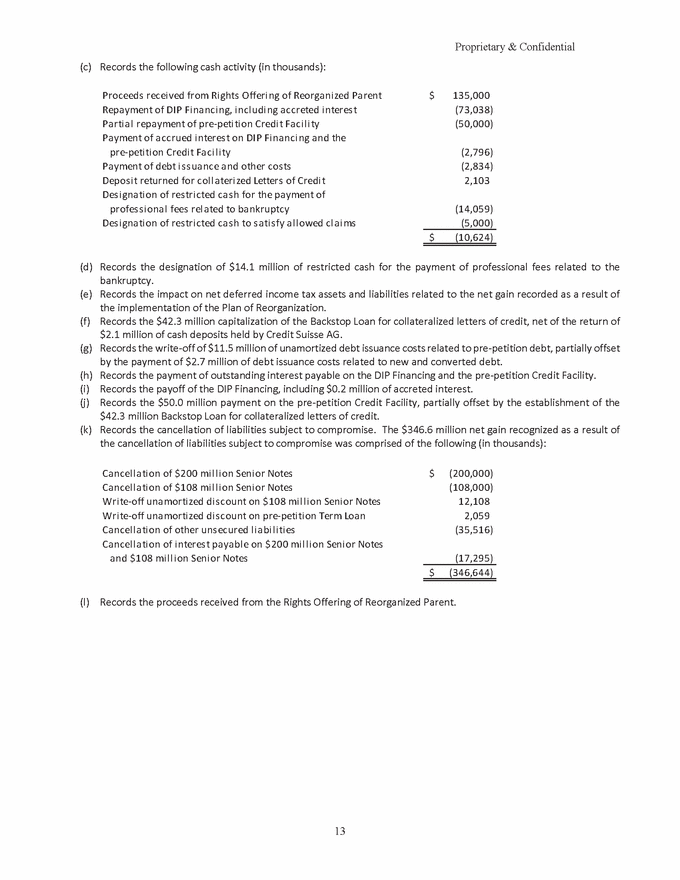
Proprietary & Confidential (m) The amount recorded as a net gain as a result of the implementation of the Plan of Reorganization was as follows (in thousands): Cancellation of $200 million Seni or Notes Cancellation of $108 million Seni or Notes Write-off unamortized di s count on $108 million Seni or Notes Write-off unamortized discount on pre-petition Term Loan Cancellation of other unsecured liabilities Cancellation of interest payable on $200 million Seni or Notes and $108 million Seni or Notes Designation of restricted cash to satisfy al l owed claims Write-off of unamortized debt issuance costs related to $200 million Seni or Notes Write-off of unamortized debt issuance costs related to $108 million Seni or Notes Write-off of unamortized debt issuance costs related to pre-petition Credit Facility Income tax impact of above items $ (200,000) (108,000) 12,108 2,059 (35,516) (17,295) 5,000 3,426 1,630 6,420 127,944 $ (202,224) (n) Represents the tax effect of certain fresh start accounting adjustments to financial reporting values which resulted in a corresponding adjustment to deferred tax assets and liabilities. Records the fair value of favorable lease agreements. Records the adjustment of property and equipment to fair value. Records the $166.7 million elimination of predecessor goodwill, partially offset by the $155.5 million adjustment of goodwill to the excess of reorganization value over the fair value of the Company’s assets, determined as follows (in millions): (o) (p) (q) Reorganization value $ 692.9 Current assets Property and equipment Intangible assets Other long-term assets (202.9) ( 66.9) (217.9) ( 49.7) Equals: Goodwill $ 155.5 (r) Records the net impact of the $214.5 million elimination of predecessor intangible assets and the $217.9 million establishment of successor intangible assets, at fair value. Records the $0.1 million elimination of the short-term portion of predecessor deferred rent, offset by the establishment of the $0.7 million short-term portion of successor unfavorable lease liabilities. Records the $1.1 million elimination of the long-term portion of predecessor deferred rent, offset by the establishment of the $4.2 million long-term portion of successor unfavorable lease liabilities. Records the elimination of predecessor additional paid-in capital. (s) (t) (u) 14
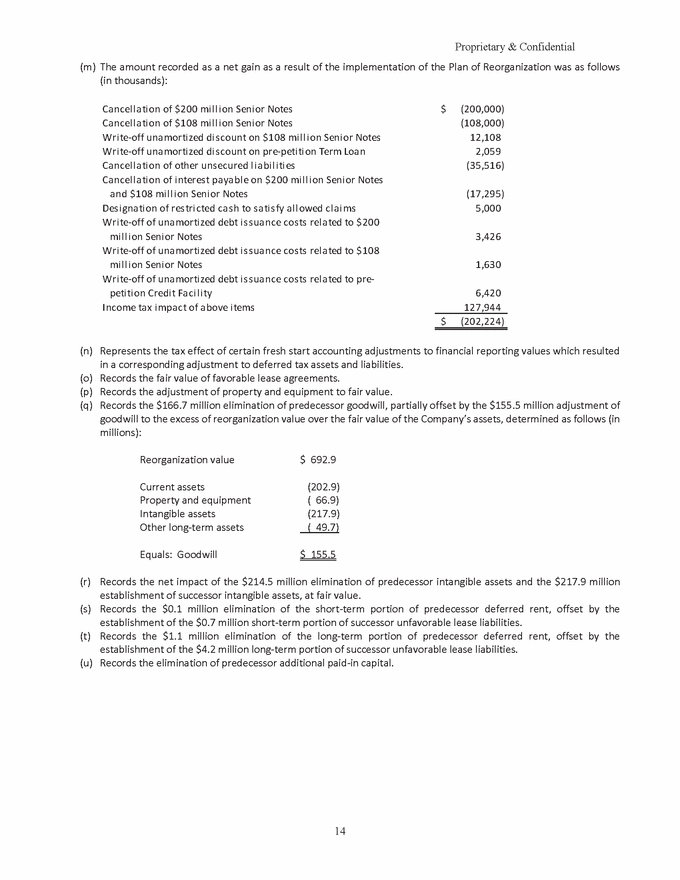
Proprietary & Confidential (v) Records the following activity (in thousands): Establishment of favorable lease assets Adjustment of property and equipment to fair value Elimination of predecessor goodwill Elimination of predecessor intangible as sets Establishment of success or intangible as sets at fair value Elimination of deferred rent Establishment of unfavorable lease liabilities Adjustment of deferred taxes Elimination of predecessor additional paid-in capital Elimination of predecessor accumulated other comprehensive income Elimination of predecessor accumulated deficit Adjustment of goodwill to the excess of reorganization value over the fair value of Company as sets $ 1,547 (209) (166,740) (214,479) 217,923 1,241 (4,923) 1,169 243,370 2,122 (285,390) 155,512 $ (48,857) (w) Records the elimination of predecessor accumulated other comprehensive income. (x) Records the elimination of predecessor accumulated deficit. 3. SIGNIFICANT ACCOUNTING POLICIES Basis of Presentation These consolidated financial statements have been prepared on a going concern basis. As of December 31, 2014, the Company experienced significant growth in accounts receivable as a result of the Company’s billing system conversion and transition of the billing and collections function. As a result, the Company obtained a working capital loan in November 2014 in the amount of $25.0 million. The Company has $25.8 million and $79.7 million of debt maturing in 2015 and 2016, respectively. The Company’s ability to meet the future required debt obligations is contingent on its ability to generate cash from operations, raise additional capital investments or refinance its debt obligations. Cash and Cash Equivalents The Company considers all highly liquid financial instruments with original maturities of three months or less when purchased to be cash equivalents. If there is no legally enforceable right of offset against cash balances and a form of overdraft protection does not exist, outstanding checks are classified as accounts payable within the Consolidated Balance Sheet and the change in the related balances is reflected in operating activities on the Consolidated Statement of Cash Flows. There were no overdraft balances at December 31, 2014 (Successor) or December 31, 2013 (Successor). Restricted Cash The Company classifies cash and cash equivalents which are restricted for use by contractual obligations or the Company’s intentions as restricted cash. Accounts Receivable, net Accounts receivable represent amounts due from customers and are recorded at the time that the Company’s services are provided. Accounts receivable balances are recorded net of both estimated contractual allowances applicable to Medicare, Medicaid and other third-party payers and estimates for uncompensated care, which relates primarily to receivables recorded for self-pay customers. Estimates for allowances are based on payer reimbursement schedules, collections history and other relevant information. As these allowances are estimates, and because they are subject to the long collection periods inherent in the healthcare service industry, they can be subject to change in subsequent periods as new information is obtained. Accounts receivable are written-off against the contractual allowance when payment is received, and are written-off against the uncompensated care allowance when it is determined that it is probable that the 15
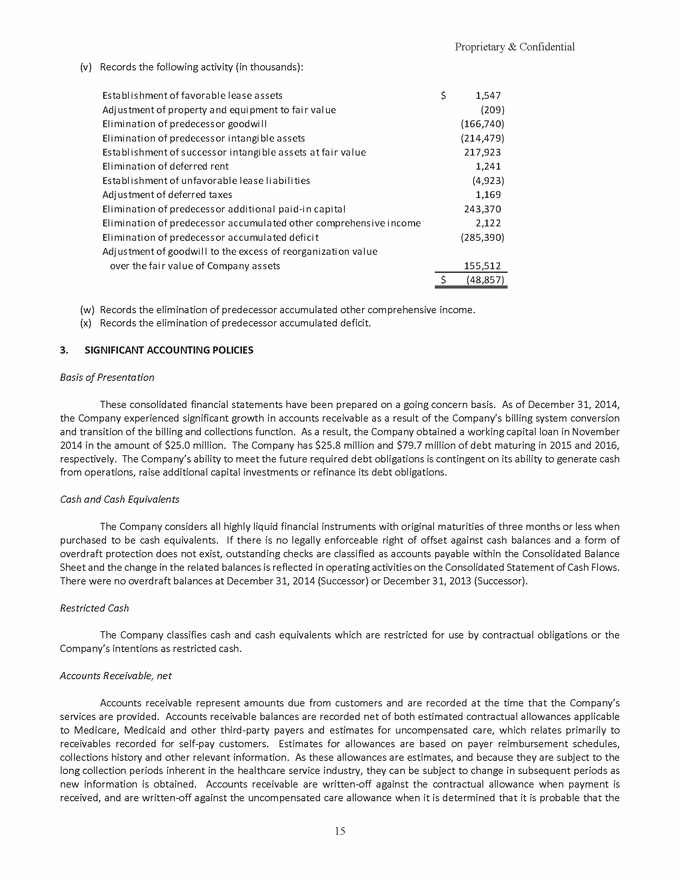
Proprietary & Confidential receivable will not be collected. A summary of the components of the Company’s net accounts receivable as of December 31, 2014 (Successor) and December 31, 2013 (Successor) is as follows (in thousands): December 31, 2014 (Successor) Allowance for contractual discounts Allowance for uncompensated care Accounts receivable, gross Accounts receivable, net Other allowances Total allowances Ambulance services accounts receivable Al l other accounts receivable Total accounts receivable $ 726,183 8,220 $ (321,147) (459) $ (255,602) $ 1,098 $ (575,651) (2,177) $ 150,532 6,043 (5) (1,713) $ 734,403 $ (321,606) $ (255,607) $ (615) $ (577,828) $ 156,575 December 31, 2013 (Successor) Allowance for contractual discounts Allowance for uncompensated care Accounts receivable, gross Accounts receivable, net Other allowances Total allowances Ambulance services accounts receivable Al l other accounts receivable Total accounts receivable $ 489,507 19,736 $ (211,957) (482) $ (204,022) $ - $ (415,979) (2,034) $ 73,528 (464) (1,088) 17,702 $ 509,243 $ (212,439) $ (204,486) $ (1,088) $ (418,013) $ 91,230 In connection with the application of fresh start accounting, accounts receivable at December 31, 2013 reflected their estimated fair value on the Emergence Date. As of August 1, 2014, the Company fully implemented a new billing system and transitioned its billing and collections function from being conducted in-house by its own employees, to being outsourced to two third-party companies. During the billing system conversion, the backlog of transport services provided but not yet billed to payers increased beginning in August 2014. This delay in billing delayed the cash collection process and increased the Company’s net accounts receivable during the period from August 2014 to December 2014. Due to difficulties the Company encountered in implementing its new billing system, outsourcing to third parties and consolidating billing offices, the Company’s accounts receivable continues to experience delays in cash collection. Cash collections have been impacted by several process delays including invoicing payers, following up with payers on denial claims, correspondence, and following up on other normal course accounts receivable activities. As a result, during 2014, the Company reduced net revenue by $4.3 million for timely filing issues and established specific reserves of approximately $11.8 million related to an increase in aged receivables, increased denial rates and related matters. Inventories Inventories, which consist of medical and fleet supplies, are stated at the lower of cost or market value. Cost is determined on a first in, first-out basis. In connection with the application of fresh start accounting, inventories at December 31, 2013 reflected their estimated fair value on the Emergence Date. Property and Equipment Prior to the Emergence Date, property and equipment were carried at cost less accumulated depreciation. Depreciation was recognized over the estimated useful lives using the straight-line method. In connection with the Company’s adoption of fresh start accounting as of the Emergence Date, property and equipment at December 31, 2013 were revalued to their fair value, generally their appraised value after considering economic obsolescence, and new useful lives were established. Accumulated depreciation was reset to zero. The appraisals assigned remaining useful lives to each asset ranging from one to 20 years, with approximately 91% of the assets being assigned remaining useful lives ranging from two to 6.5 years. Property and equipment acquired subsequent to December 31, 2013 is recorded at cost. Equipment and vehicles are depreciated over three to twelve years and buildings are depreciated over ten to thirty years. Leasehold improvements are capitalized and depreciated using the straight-line method over the shorter of the contractual lease terms or the 16
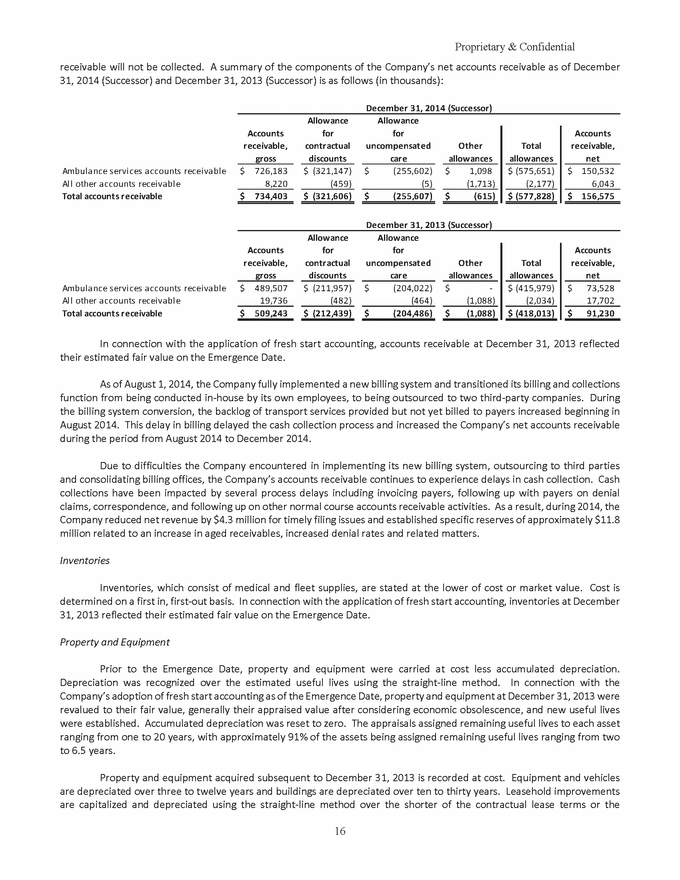
Proprietary & Confidential estimated useful lives. Maintenance and repairs that do not improve or extend the useful life of assets are expensed as incurred. The cost and accumulated depreciation applicable to assets retired are removed from the accounts and the gain or loss, if any, is recognized in income as realized. Goodwill and Intangible Assets with Indefinite Lives As part of fresh start accounting as of December 31, 2013, the Company recorded goodwill, which represented the excess of the Company’s reorganization value over the fair value of the Company’s assets at the Emergence Date. Intangible assets with indefinite lives primarily consist of certificates of need and certain trade names acquired. The Company tests for impairment at least annually. Additional impairment tests may be performed between annual tests if circumstances indicate that a potential impairment exists. The Company performs its annual goodwill two-step impairment test as of the end of its fiscal year. In the first step, the fair value of each reporting unit is compared to the carrying value of its net assets including goodwill. The fair value of a reporting unit is determined by a market approach based on each reporting unit’s estimated discount rate and long-term growth rate or by (or in combination with) an income approach based on discounted estimated future cash flows from each reporting unit. If the fair value of the reporting unit exceeds the carrying value of the net assets of the reporting unit, goodwill is not impaired and no further testing is required. If the carrying value of the net assets of the reporting unit exceeds the fair value of the reporting unit, then a second step must be performed in order to determine the implied fair value of the goodwill and to compare it to the carrying value of goodwill. If the carrying value of goodwill exceeds its implied fair value, then an impairment loss equal to the difference is recorded. The determination of fair value requires the Company to make significant judgments and estimates about future events. The estimated fair value of the Company’s reporting units could change if there were future changes in its capital structure, cost of debt, interest rates, capital expenditure levels or its ability to perform at levels that were forecasted. Due to the inherent uncertainty involved in making these estimates, actual results could differ materially from the estimates. The Company evaluated the significant assumptions used to estimate the fair value of each reporting unit, both individually and in the aggregate, and concluded they are reasonable. During 2014 (Successor), as part of the Company’s reorganization upon emergence from bankruptcy, the Company determined that there are four reporting units for purposes of the impairment test (three Ambulance Operating Divisions – one in the East and two in the West, and Fire Operations). During 2013 (Predecessor), the Company utilized four reporting units for purposes of the impairment test (four Operating Regions – East, South, Southwest and West). During 2014 (Successor), no impairment related to the Company’s Goodwill was recognized. The Company’s evaluation of its intangible assets with indefinite lives during 2014 (Successor) indicated impairment of the Company’s indefinite-lived trade name assets. As a result, the Company estimated the fair value of the intangible assets with indefinite lives compared to carrying amounts, and recorded an impairment charge of $1.6 million to impair indefinite-lived trade name assets, based on the fair value of the discounted estimated future cash flows related to the assets. During 2013 (Predecessor), the Company experienced a reduction in the estimated collectability of its accounts receivable, which materially changed the estimated revenue forecast, leading to lower estimated future cash flows. As a result, the Company re-evaluated its liquidity position relative to its outstanding obligations. These factors were the triggering events that resulted in the Company’s decline in value of tangible and intangible assets, including goodwill. The Company’s evaluation of its goodwill during 2013 (Predecessor) indicated potential impairment of the goodwill in each of the Company’s four reporting units. As a result, the Company estimated the fair value of the goodwill in those reporting units compared to carrying amounts, and recorded an impairment charge of $260.1 million to impair goodwill. Of this amount, $64.2 million was recorded in the South operating region, which represented all of the goodwill in that operating region, $43.8 million was recorded in the West operating region, which represented all of the goodwill in that operating region, $86.4 million was recorded in the East operating region and $65.7 million was recorded in the Southwest operating region. The Company’s evaluation of its intangible assets with indefinite lives during 2013 (Predecessor) indicated potential impairment of the indefinite-lived trade name assets in the Company’s South, West and Southwest operating regions. As a result, the Company estimated the fair value of the intangible assets with indefinite lives in those reporting units compared to carrying amounts, and recorded an impairment charge of $36.4 million to impair intangible assets with indefinite lives. Of 17
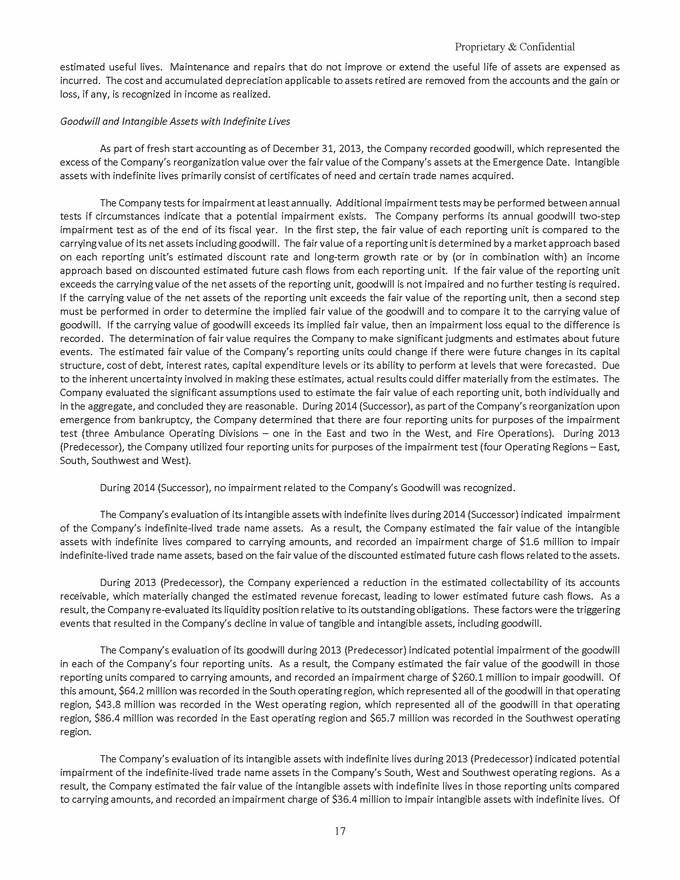
Proprietary & Confidential this amount, $7.9 million was recorded in the South operating region, $19.1 million was recorded in the West operating region and $9.4 million was recorded in the Southwest operating region. Annual evaluations of goodwill and intangible assets with indefinite lives were not conducted as of December 31, 2013, as goodwill was adjusted to equal the excess of reorganization value over the fair value of the Company’s assets as of the Emergence Date, and intangible assets and related accumulated amortization of the Predecessor Company were eliminated as of the Emergence Date, with intangible assets of the Successor Company being identified and valued at their fair value as part of fresh start accounting as of December 31, 2013. Impairment of Intangible and Other Long-Lived Assets The Company reviews its long-lived assets for impairment whenever events or changes in circumstances indicate that the related carrying amounts may not be recoverable, by comparing the carrying amount of such assets to the undiscounted future cash flows expected to result from the use and eventual disposition of the asset or asset group. During 2014 (Successor), as part of the Company’s reorganization upon emergence from bankruptcy, the Company determined that there are three asset groups for purposes of the impairment test of intangible assets (two Ambulance Operating Divisions – East and West, and Fire Operations) and 27 operating market asset groups for purposes of the impairment test of property and equipment. During 2013 (Predecessor), the Company utilized six asset groups for purposes of the impairment test of intangible assets and property and equipment. In cases where the undiscounted estimated future cash flows are less than the related carrying amount, an impairment loss is recognized for an amount by which the carrying amount exceeds the fair value. The fair value is based on quoted market prices or, in instances where quoted market prices are not available, the present value of estimated future cash flows using a discount rate commensurate with the risks involved. During 2014 (Successor), no impairment related to the Company’s intangible assets was recognized. During 2014 (Successor), based on the Company’s assessment of the recoverability of its property and equipment based upon an analysis of the carrying value of the Company’s property and equipment and projected future cash flows of each of the 27 operating market asset groups, the Company recorded an impairment charge of approximately $0.7 million, in aggregate, related to property and equipment in four of its operating markets. During 2013 (Predecessor), the Company experienced a reduction in the estimated collectability of its accounts receivable, which materially changed the estimated revenue forecast, leading to lower estimated future cash flows. As a result, the Company re-evaluated its liquidity position relative to its outstanding obligations. These factors were the triggering events that resulted in the Company’s decline in value of tangible and intangible assets, including goodwill. The Company’s evaluation of its intangible assets during 2013 (Predecessor) indicated potential impairment of intangible assets in the Company’s West and South operating regions. The Company recorded an impairment charge of $82.1 million to impair intangible assets, with $44.3 million recorded in the West operating region and $37.8 million recorded in the South operating region. The $44.3 million impairment charge recorded in the West operating region consisted of $30.1 million for ambulance customer relationships, $13.9 million for non-compete agreements and $0.3 million for service area contracts. The $37.8 million impairment charge recorded in the South operating region consisted of $37.4 million for ambulance customer relationships and $0.4 million for service area contracts. The Company also assessed the recoverability of its property and equipment based upon an analysis of the carrying value of the Company's property and equipment and projected future cash flows of each of the six asset groups. Based on this assessment, the Company recorded an impairment charge of approximately $18.5 million during 2013 (Predecessor). Of this amount, $10.2 million was recorded in the West operating region, $7.2 million was recorded in the South operating region, and $1.1 million was recorded in the Pacific and Bowers operating region. An annual evaluation of intangible assets was not conducted as of December 31, 2013 as intangible assets and related accumulated amortization of the Predecessor Company were eliminated as of the Emergence Date, with intangible assets of the Successor Company being identified and valued at their fair value as part of fresh start accounting as of December 31, 2013. 18
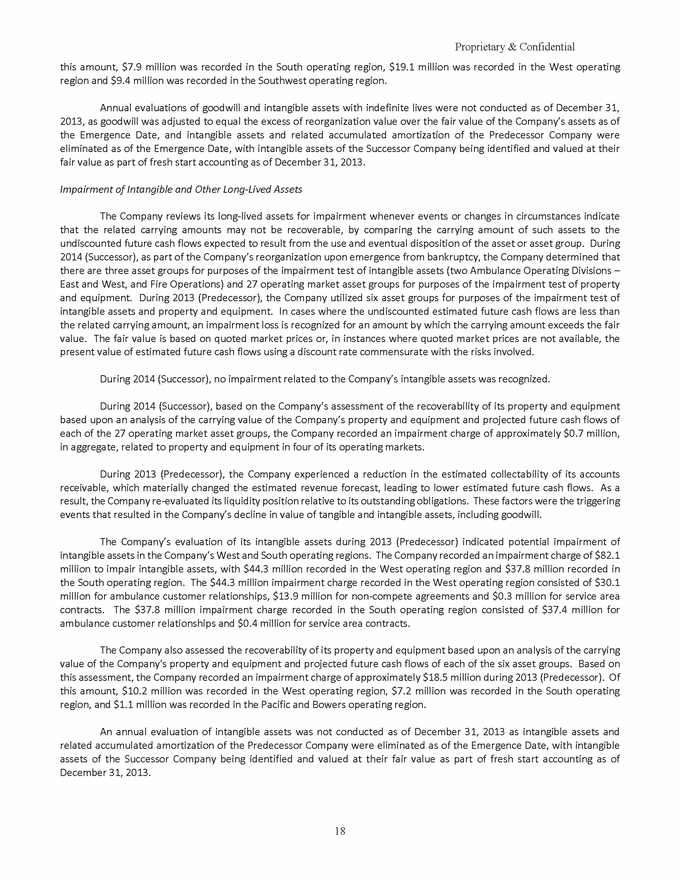
Proprietary & Confidential Deposits Included in Deposits in the Company’s Consolidated Balance Sheet as of December 31, 2014 (Successor) and December 31, 2013 (Successor) is $41.8 million and $42.3 million, respectively, of cash collateral for letters of credit related to the Exit Letter of Credit Facility that became effective upon the Company’s December 31, 2013 emergence from Chapter 11 bankruptcy protection. The amount represents 102.5% of the $40.8 million and $41.2 million, respectively, of value of total letters of credit included in the Exit Letter of Credit Facility, which was collateralized by the Backstop Loan (see Note 12). Net Revenue Reimbursement from third-party payors in the healthcare industry is complex and may involve lengthy delays. Third-party payors may disallow, in whole or in part, claims for payment based on determinations that certain amounts are not reimbursable under plan coverage, determinations of medical necessity, or that additional information is required for the processing of the claim. In addition, laws and regulations governing the Medicare and Medicaid programs are complex and subject to interpretation. Ambulance services revenue is recognized when services are provided and is recorded net of estimated contractual allowances applicable to Medicare, Medicaid and other third-party payers and net of estimates for uncompensated care. Such allowances applicable to continuing operations are reflected as reductions to revenue in the accompanying Consolidated Statement of Operations. Revenue generated under fire protection service contracts is recognized over the life of the contract. Subscription fees, which are generally received in advance, are deferred and recognized on a straight-line basis over the term of the subscription agreement, which is generally one year. Other revenue primarily consists of non-ambulance non-emergency transport services, dispatch, training and home health care service fees, which are recognized when the services are provided. Non-ambulance non-emergency transport services are recorded net of estimated contractual allowances applicable to Medicare, Medicaid and other third-party payers and net of estimates for uncompensated care. 19
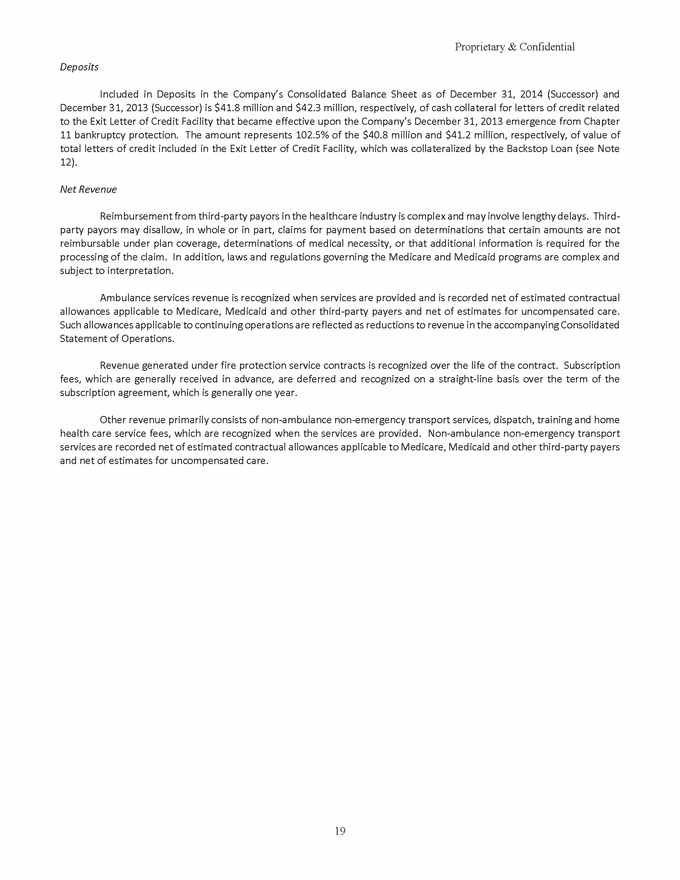
Proprietary & Confidential Components of the Company’s total net revenue from continuing operations recognized during 2014 (Successor) and 2013 (Predecessor) are summarized below (in thousands): Successor Predecessor Year Ended December 31, 2014 2013 EMS revenue: Gross ambulance services revenue Allowance for contractual di s counts Allowance for uncompensated care Net ambulance services revenue Other EMS revenue Total net EMS revenue Fi re revenue Other revenue: Gross other revenue Allowance for contractual di s counts Allowance for uncompensated care Net other revenue Total net revenue $ 1,679,291 (902,645) $ 1,747,386 (923,837) (264,426) (282,557) 512,220 540,992 20,177 23,889 532,397 564,881 72,947 72,381 6,088 (1,723) (499) 8,924 (1,655) (2,579) 3,866 4,690 $ 609,210 $ 641,952 Total allowances for contractual di s counts Total allowances for uncompensated care Total allowances $ (904,368) $ (925,492) (264,925) (285,136) $ (1,169,293) $ (1,210,628) Share-based Compensation Share-based compensation expense is based on the grant-date fair value of the share-based award and the estimated number of awards that are expected to vest. Expense is recognized over the period during which an employee is required to provide service in exchange for the award, which is usually the vesting period. A contribution from Reorganized Parent is recognized for share-based compensation expense associated with share-based awards of Reorganized Parent issued to employees and members of the Board of Directors of the Company. Advertising Expense Costs associated with advertising are generally expensed as incurred and are included in other operating expenses in the Consolidated Statement of Operations. Advertising expense for continuing operations during 2014 (Successor) and 2013 (Predecessor) was $0.1 million and $0.2 million, respectively. Income Taxes Income taxes are accounted for using the asset and liability method. Under this method, deferred income tax assets and liabilities are recognized for the expected future tax consequences attributable to temporary differences between the financial statement carrying amounts of existing assets and liabilities and their respective tax bases. Deferred tax assets are also recognized for net operating loss, capital loss and tax credit carryforwards. Deferred income tax assets and liabilities are measured using enacted tax rates expected to apply to taxable income in the years in which the related temporary differences are expected to be recovered or settled. The effect on deferred tax assets and liabilities of a change in tax rates is recognized in income in the period that includes the enactment date. A valuation allowance is provided for those deferred tax assets for which it is more likely than not that the realization of the related benefits will not be achieved. 20
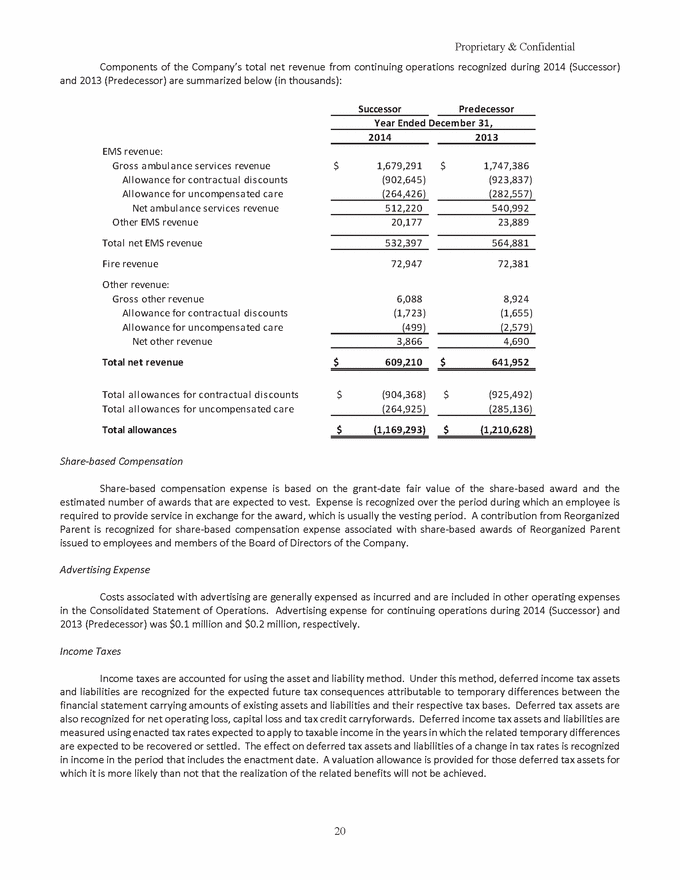
Proprietary & Confidential The Company measures and records tax contingency accruals in accordance with accounting principles generally accepted in the United States (“GAAP”) which prescribes a threshold for the financial statement recognition and measurement of a tax position taken or expected to be taken in a return. Only positions meeting the “more likely than not” recognition threshold may be recognized or continue to be recognized. Use of Estimates The preparation of financial statements in accordance with GAAP requires management to make estimates and assumptions that affect the reported amounts of assets and liabilities at the date of the financial statements and the reported amounts of revenues and expenses recognized during the reporting period. Significant estimates have been made by management in connection with the measurement of contractual allowances applicable to Medicare, Medicaid and other third-party payers, the estimate for uncompensated care, the valuation allowance for deferred tax assets, workers’ compensation and general liability self-insured claim reserves, fair values of reporting units for purposes of goodwill impairment testing and fresh start accounting and future cash flows associated with long-lived assets. Actual results could differ from these estimates. Recent Accounting Pronouncements In January 2014, the Financial Accounting Standards Board (“FASB”) issued Accounting Standards Update (“ASU”) No. 2014-02, Intangibles – Goodwill and Other (Topic 350): Accounting for Goodwill (“ASU 2014-02”). ASU 2014-02 allows private companies to elect to amortize goodwill on a straight-line basis over 10 years and perform a simpler one-step impairment test at either the entity level or the reporting unit level. The alternative is effective for reporting periods beginning after December 15, 2014. The Company has evaluated the new alternative and has elected to not amortize its goodwill. Therefore the adoption of ASU 2014-02 is not expected to impact the Company’s consolidated financial statements. In April 2014, the FASB issued ASU 2014-08, Presentation of Financial Statements and Property, Plant, and Equipment: Reporting Discontinued Operations and Disclosures of Disposals of Components of an Entity (“ASU 2014-08”), which is intended to change the criteria for reporting discontinued operations and enhance disclosures. Under this new guidance, only disposals representing a strategic shift in operations having a major effect on the entity’s operations and financial results should be presented as discontinued operations. If the disposal does qualify as a discontinued operation, the entity will be required to provide expanded disclosures, as well as disclosure of the pretax income attributable to the disposal of a significant part of an entity that does not qualify as a discontinued operation. ASU 2014-08 will be effective for reporting periods beginning after December 15, 2014, and is to be applied prospectively. While the adoption of ASU 2014-08 is not expected to have a material effect on the Company’s consolidated financial statements, it may alter whether or not an operation that is discontinued in 2015 and afterward meets the criteria for classification as a discontinued operation in the Company’s financial statements, as compared to previous accounting guidance. In August 2014, the FASB issued ASU No. 2014-15, Presentation of Financial Statements—Going Concern (Subtopic 205-40), Disclosure of Uncertainties about an Entity's Ability to Continue as a Going Concern (“ASU 2014-15”) which requires management to evaluate, in connection with preparing financial statements for each reporting period, whether there are conditions or events, considered in the aggregate, that raise substantial doubt about an entity's ability to continue as a going concern within one year after the date that the financial statements are issued (or within one year after the date that the financial statements are available to be issued when applicable) and provide related disclosures. ASU 2014-15 is effective for reporting periods ending after December 15, 2016, and for periods thereafter. The adoption of ASU 2014-15 is not expected to impact the Company’s consolidated financial statements. 4. CHANGES TO THE COMPANY’S CONTRACT WITH SANTA CLARA COUNTY On December 10, 2013, the Board of Supervisors of Santa Clara County in Northern California approved recommended changes to the contractual relationship Santa Clara County has with the Company and the Advanced Life Support (ALS)/911 ambulance services contract (as previously amended) that has been effective since July 1, 2011. Included in these changes are retroactive and prospective modifications impacting the Company’s net revenues and expenses related to the Company’s operations in Santa Clara County. 21
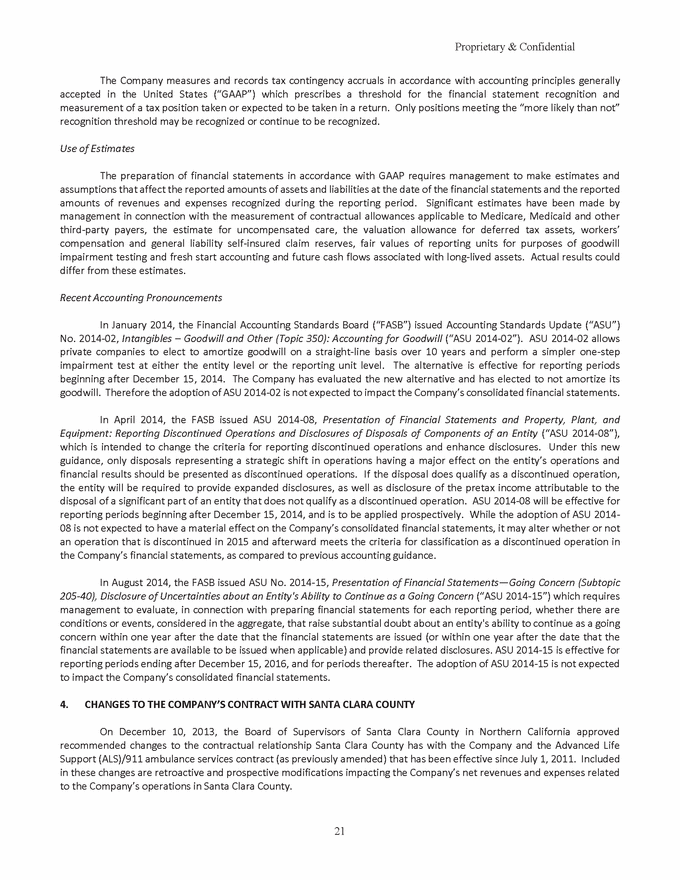
Proprietary & Confidential Santa Clara County agreed to retroactively compensate the Company for transports provided by the Company related to correctional facilities, beginning July 1, 2011. The cumulative billing value of these transports, for the period July 1, 2011 through December 31, 2013, was approximately $1.6 million. This amount was recognized as net revenue by the Company during the year ending December 31, 2013 (Predecessor). Santa Clara County also agreed to compensate the Company going forward for correctional facility transports in normal course, beginning January 1, 2014. Santa Clara County also agreed to waive certain fees it charged the Company for the period April 2013 through August 4, 2013. The cumulative amount of these waived fees, which were originally accrued for and expensed by the Company during the April 2013 through July 2013 period, was approximately $2.6 million. The $2.6 million of waived fees was recognized as a reduction of operating expenses by the Company during the year ended December 31, 2013 (Predecessor). In addition to the changes to the Company’s contract with Santa Clara County described above, on December 4, 2013 the Company executed a new Collective Bargaining agreement with the union that supports the Santa Clara operating area. This agreement adjusted pay and other items for union workers. The contract is effective retroactively to July 1, 2013 and extends to June 30, 2015. The amount of retroactive pay for the period July 1, 2013 through December 4, 2013 that the union employees are entitled to based on the new agreement is approximately $0.3 million in aggregate, and was paid to the union employees in December 2013. This $0.3 million of retroactive compensation was recognized in operating expenses by the Company during the year ended December 31, 2013 (Predecessor). 5. FAIR VALUE MEASUREMENTS Fair value measurements are classified under the following hierarchy: • Level 1: Observable inputs such as quoted prices for identical assets or liabilities in active markets. • Level 2: Observable inputs other than quoted prices substantiated by market data and observable, either directly or indirectly for the asset or liability. This includes quoted prices for similar assets or liabilities in active markets. • Level 3: Unobservable inputs that are supported by little or no market activity and that are significant to the fair value of the assets and liabilities. In connection with the Company’s adoption of fresh start accounting as of the Emergence Date, all assets and liabilities were remeasured at fair value as of December 31, 2013 (Successor). The following are the fair values of the Company’s assets and liabilities recorded at fair value as of December 31, 2014 (Successor) (in thousands): Quoted Prices in Active Markets for Identical Assets (Level 1) Significant Other Observable Inputs (Level 2) Significant Unobservable Inputs (Level 3) Total Recorded at Fair Value December 31, 2014 Assets: Cash and cash equivalents (1) Restricted cash (2) Total assets measured at fair value $ 26,094 $ 26,094 $ - $ - 1,655 1,655 - - $ 27,749 $ 27,749 $ - $ - (1) Cash and cash equivalents include bank deposits and money market accounts. (2) Restricted cash consisted of bank deposits. The carrying values of accounts receivable, accounts payable, accrued and other current liabilities and other long-term liabilities approximate the related fair values of these assets and liabilities. 22
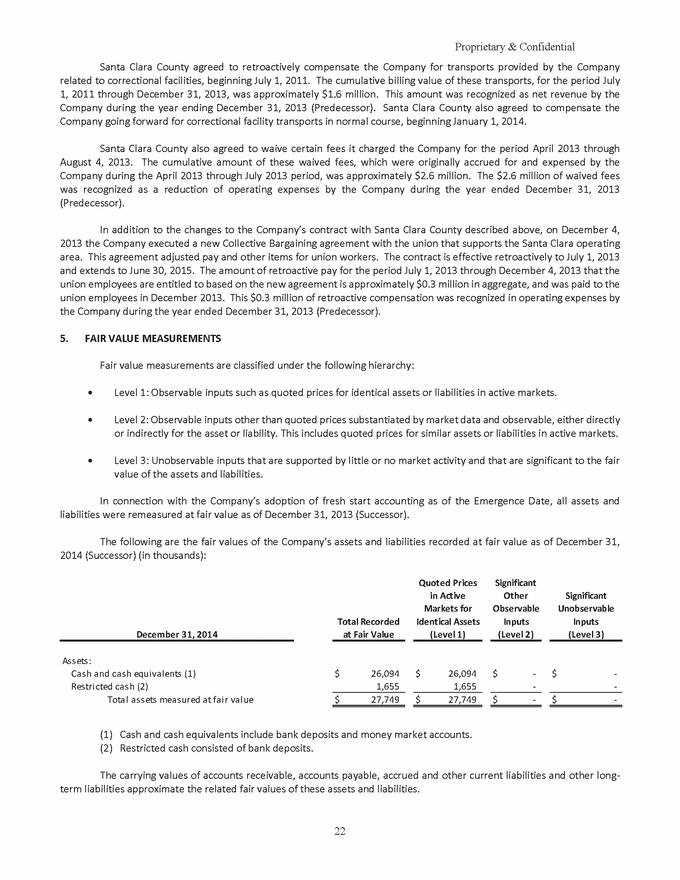
Proprietary & Confidential The following is a comparison of the fair value and recorded value of the Company’s long-term debt as of December 31, 2014 (in thousands): Successor December 31, 2014 Recorded Value Fair Value Existing Term Loan ……………………………………………………………… $ Converted Term Loan …………………………………………………………… Backs top Term Loan …………………………………………………………… Working Capital Loan ………………………………………….……………… 264,617 59,155 39,740 25,659 $ 280,127 59,807 42,249 23,636 The fair value of long-term debt instruments were estimated based on discounting the remaining principal and interest payments using current market rates for similar debt at December 31, 2014. 6. PROPERTY AND EQUIPMENT Property and equipment consists of the following (in thousands): Successor December 31, 2014 2013 Equipment Vehicles Land and buildings Leasehold improvements Assets not yet placed in service $ 24,734 44,414 4,096 2,450 $ 19,306 33,375 4,096 1,843 13,699 8,252 89,393 (17,734) 66,872 - Les s: Accumulated depreciation Total net property and equipment $ 71,659 $ 66,872 Depreciation expense from continuing operations was $17.7 million and $21.1 million during 2014 (Successor) and 2013 (Predecessor), respectively. During 2014 (Successor), based on the Company’s assessment of the recoverability of its property and equipment based upon an analysis of the carrying value of the Company’s property and equipment and projected future cash flows of each of the 27 operating market asset groups, the Company recorded an impairment charge of approximately $0.7 million, in aggregate, related to property and equipment in four of its operating markets. In connection with the Company’s adoption of fresh start accounting as of the Emergence Date, property and equipment were revalued to their fair value, generally their appraised value after considering economic obsolescence, and new useful lives were established. Accumulated depreciation was reset to zero. The amount of the adjustment to revalue the Company’s property and equipment to fair value was to decrease the carrying value by approximately $0.2 million. During 2013 (Predecessor), the Company assessed the recoverability of its property and equipment based upon an analysis of the carrying value of the Company's property and equipment and undiscounted estimated future cash flows of the Company by asset group. Based on this assessment, the Company recorded an impairment charge of approximately $18.5 million. As part of the impairment charges, the Company reduced the gross book value of the assets and eliminated the accumulated depreciation of the assets to a zero balance such that the reduction in the net book value of the assets equals the amount of the impairment charge. 23
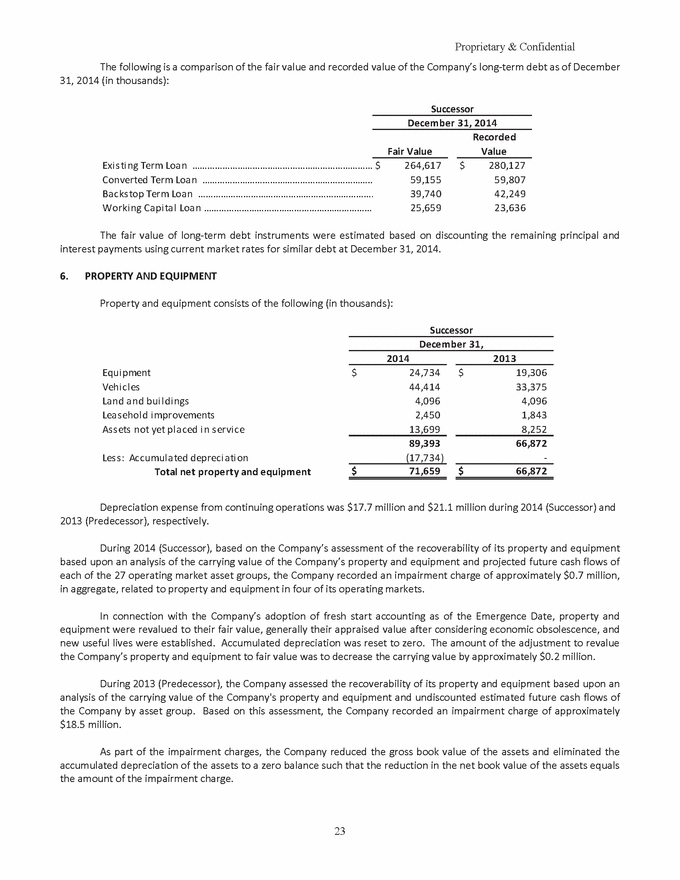
Proprietary & Confidential 7. GOODWILL The following table presents changes in the carrying amount of goodwill during 2014 (Successor) and 2013 (Predecessor) (in thousands): Successor Predecessor Year Ended December 31, 2014 2013 Beginning Balance Impairment recognized Adjustments related to acquisitions that occurred prior to 2013 Acquisition during 2013 Elimination of Predecessor goodwill Adjustment of goodwill to the excess of reorganization value over the fair value of Company assets Goodwill (Successor) $ 155,512 - $ 426,675 (260,080) - - - 104 41 (166,740) - 155,512 $ 155,512 $ 155,512 The Company’s evaluation of its goodwill during 2013 (Predecessor) indicated potential impairment of the goodwill in each of the Company’s four reporting units. As a result, the Company estimated the fair value of those reporting units compared to carrying amounts, and recorded an impairment charge of $260.1 million to goodwill. In connection with the Company’s adoption of fresh start accounting as of the Emergence Date, Predecessor goodwill was eliminated, and Successor goodwill was adjusted to equal the excess of reorganization value over the fair value of the Company’s assets as of December 31, 2013 (Successor). 8. INTANGIBLE ASSETS The changes in the net carrying amount of intangible assets during 2014 (Successor) and 2013 (Predecessor) are as follows (in thousands): Successor Predecessor Year Ended December 31, 2014 2013 Balance at beginning of period Impairment recognized Amortization Other Elimination of Predecessor intangible assets Fair value of identified intangible assets as of Emergence Date Balance at end of period (Successor) $ 217,923 (1,635) (12,934) - - $ 349,501 (118,477) (16,538) (7) (214,479) - 217,923 $ 203,354 $ 217,923 The Company’s evaluation of its intangible assets with indefinite lives during 2014 (Successor) indicated potential impairment of the Company’s indefinite-lived trade name assets. As a result, the Company estimated the fair value of the intangible assets with indefinite lives compared to carrying amounts, and recorded an impairment charge of $1.6 million to impair indefinite-lived trade name assets. In connection with the Company’s adoption of fresh start accounting on the Emergence Date, intangible assets and related accumulated amortization of the Predecessor Company were eliminated. Intangible assets of the Successor Company were identified and valued at their fair value. The fair value is based on quoted market prices or in instances where quoted 24

Proprietary & Confidential market prices are not available, the present value of estimated future cash flows using a discount rate commensurate with the risks involved. The Company’s evaluation of its intangible assets during 2013 (Predecessor) indicated potential impairment of intangible assets in the Company’s West and South operating regions. The Company recorded an impairment charge of $118.5 million to impair intangible assets, consisting of $67.5 million of impairment related to ambulance customer relationships, $36.4 million related to trade names, $13.9 million related to non-compete agreements and $0.7 million for service area contracts. The Company’s intangible assets as of December 31, 2014 (Successor) and December 31, 2013 (Successor) are as follows (in thousands): Successor Weighted Average Life (Years) December 31, 2014 Gross Carrying Amount Accumulated Amortization Net Carrying Amount Long-lived intangible assets: Ambulance customer relationships Other customer relationships Non-compete agreements Total long-lived intangible assets 10.0 10.0 6.0 $ 101,500 24,000 $ (10,150) (2,400) $ 91,350 21,600 2,300 (384) 1,916 127,800 (12,934) 114,866 Indefinite-lived intangible assets: Certificates of need Trade names and trademarks Total indefinite-lived intangible assets Total - - 20,623 67,865 - - 20,623 67,865 88,488 - 88,488 $ 216,288 $ (12,934) $ 203,354 Successor Weighted Average Life (Years) December 31, 2013 Gross Carrying Amount Accumulated Amortization Net Carrying Amount Long-lived intangible assets: Ambulance customer relationships Other customer relationships Non-compete agreements Total long-lived intangible assets 10.0 10.0 6.0 $ 101,500 24,000 $ - - $ 101,500 24,000 2,300 - 2,300 127,800 - 127,800 Indefinite-lived intangible assets: Certificates of need Trade names and trademarks Total indefinite-lived intangible as sets Total - - 20,623 69,500 - - 20,623 69,500 90,123 - 90,123 $ 217,923 $ - $ 217,923 25

Proprietary & Confidential No amortization of Successor intangible assets was recognized as of December 31, 2013 as the Emergence Date was at the end of the Company’s 2013 reporting period. The following table shows the expected amortization of long-lived intangible assets for each of the years ending December 31 (in thousands): 2015 2016 2017 2018 2019 Thereafter $ 12,933 12,933 12,933 12,933 12,933 50,201 $ 114,866 9. ACCRUED AND OTHER CURRENT LIABILITIES Accrued and other current liabilities consist of the following (in thousands): Successor December 31, 2014 2013 Accrued payroll and taxes Accrued employee benefits , including accrued vacation Workers ’ compensation related liabilities (see Note 11) Accrued interest General /auto liability related liabilities (see Note 11) Contingencies (see Note 17) Unfavorable lease liabilities Income taxes payable Other Total accrued and other current liabilities $ 7,438 12,236 8,288 5,258 4,468 - 952 375 $ 8,720 9,913 8,914 92 4,423 781 680 - 4,490 1,882 $ 43,505 $ 35,405 10. OTHER LIABILITIES Other long-term liabilities consist of the following (in thousands): Successor December 31, 2014 2013 General /auto liability related liabilities (see Note 11) Workers ’ compensation related liabilities (see Note 11) Net pension liability (see Note 16) Deferred rent Unfavorable lease liabilities Other Total other long-term liabilities $ 7,486 14,686 7,763 5,049 3,110 $ 8,060 15,348 3,624 - 4,242 2,998 698 $ 41,092 $ 31,972 11. GENERAL/AUTO LIABILITY AND WORKERS’ COMPENSATION INSURANCE PROGRAMS The Company carries various insurance policies, including workers’ compensation, general/auto liability, property, professional and other lines of coverage in order to minimize the risk of loss due to accident, injury, automobile and professional liability claims resulting from our operations, and to comply with certain legal and contractual requirements. 26
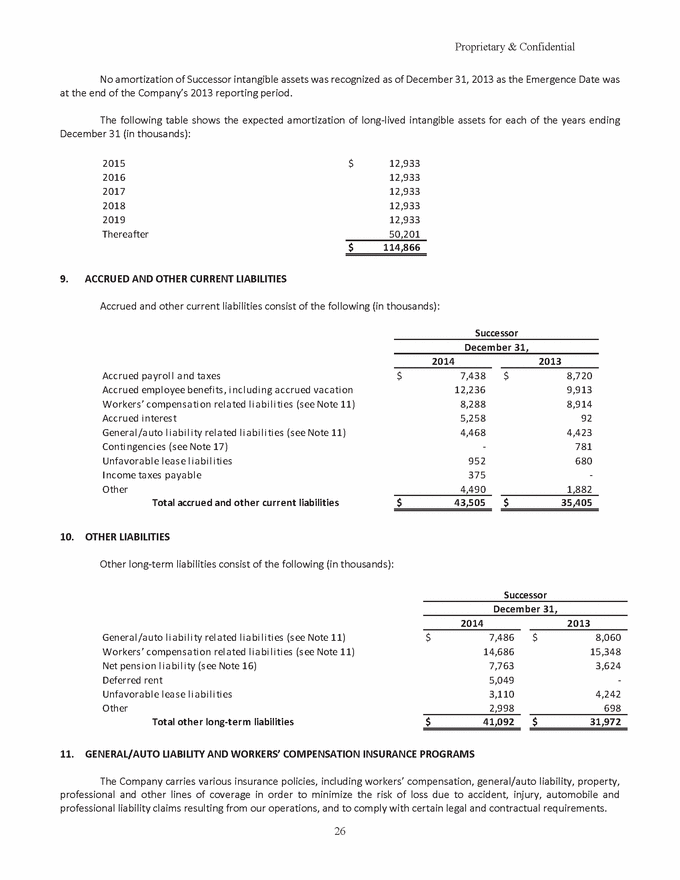
Proprietary & Confidential The Company retains certain levels of exposure in its general/auto liability and workers’ compensation programs and purchases coverage from third-party insurers for exposures in excess of those levels. In addition to expensing premiums and other costs relating to excess coverage, the Company establishes reserves for claims, both reported and incurred but not reported, on a gross basis. A receivable is recognized for amounts expected to be recovered from insurers in excess of the retention limits. The Company regularly evaluates the financial capacity of its insurers to assess the recoverability of the receivable. The Company engages third-party administrators (“TPAs”) to manage general/auto liability and workers’ compensation claims. The TPAs estimate a loss reserve at the time a claim is reported and then monitor the development of the claim over time to confirm that such estimates continue to be appropriate. Management periodically reviews its insurance claim reserves and engages its independent actuary at least semi-annually, or in interim periods if events or changes in circumstances indicate additional evaluation is necessary, to assist with estimating its claim reserves based on loss reserve estimates. The Company adjusts its claim reserves with an associated increase or decrease to expense as new information on the underlying claims is obtained. Additionally, the Company’s general/auto liability and workers’ compensation insurers require the Company to post collateral to support future expected claim payments. The Company has provided letters of credit as collateral to support retention limits. These letters of credit, issued under the Company’s Backstop Loan as discussed in Note 12, included $9.4 million for general/auto liability and $24.1 million for workers’ compensation at December 31, 2014 (Successor) and $10.6 million for general/auto liability and $24.2 million for workers’ compensation at December 31, 2013 (Successor). General/Auto Liability A summary of activity in the Company’s general/auto liability claim reserves and related receivable from insurers is as follows (in thousands): Predecessor Gross Claim Reserves Receivables From Insurers Net General/ Auto Related Liabilities Balance at December 31, 2012 Provision charged to general /auto liability insurance Claim payments Actuarial adjustment Increase in estimated recoverable claims Settlements received Reclassification to liabilities subject to compromise Balance at December 31, 2013 (Success or) $ 23,801 9,250 (2,642) (7,487) 8,491 (11,770) $ 3,827 - - 30 8,491 (11,770) $ 19,974 9,250 (2,642) (7,517) - - (7,160) - (7,160) $ 12,483 $ 578 $ 11,905 Successor Gross Claim Reserves Receivables From Insurers Net General/ Auto Related Liabilities Balance at December 31, 2013 (Successor) Provision charged to general /auto liability insurance Claim payments Actuarial adjustment Settlements received Balance at December 31, 2014 (Successor) $ 12,483 6,982 (1,432) (5,977) $ 578 - - - $ 11,905 6,982 (1,432) (5,977) (102) (102) - $ 11,954 $ 476 $ 11,478 27
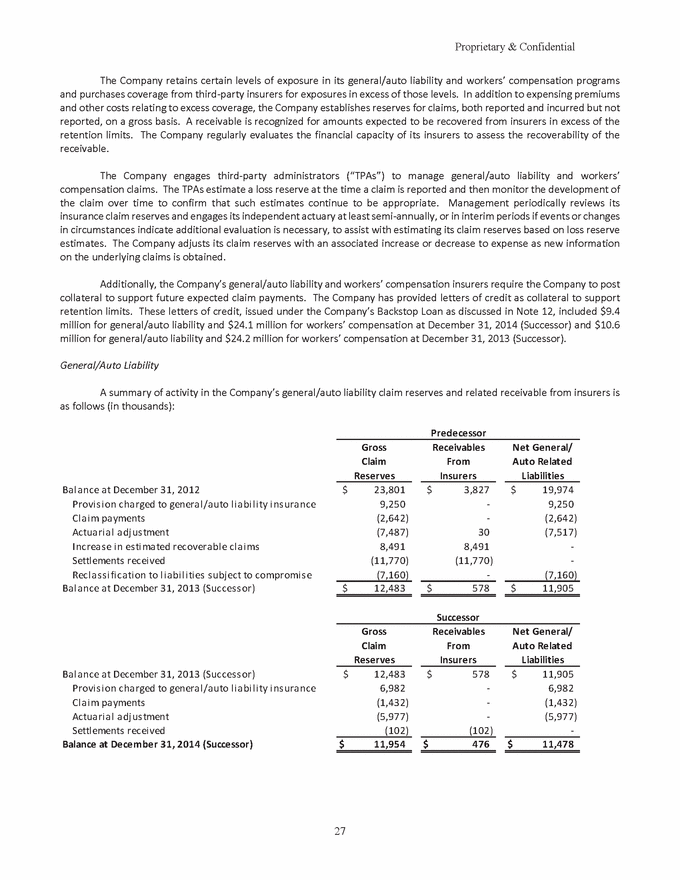
Proprietary & Confidential The classification of general/auto liability related amounts in the Consolidated Balance Sheet as of December 31, 2014 (Successor) and December 31, 2013 (Successor) is as follows (in thousands): Successor December 31, 2014 2013 Receivables from insurers included in prepaid expenses and other current as sets Receivables from insurers included in other assets Total general /auto liability related assets Claims reserves included in accrued and other current liabilities Claims reserves included in other long-term liabilities Total general /auto liability related liabilities Net general /auto liability related li abilities $ 19 $ 121 457 457 476 578 4,468 7,486 4,423 8,060 11,954 12,483 $ 11,478 $ 11,905 As of December 31, 2014 (Successor) and December 31, 2013 (Successor), the Company had liabilities and corresponding receivables of $0.5 million and $0.6 million, respectively, related to specific claims. Workers’ Compensation A summary of activity in the Company’s workers’ compensation claim related reserves, deposits and premium asset/liabilities is as follows (in thousands): Predecessor Gross Claims Reserves and Premium Liabilities Receivables From Insurers and Deposits Net Workers’ Compensation Related Liabilities Balance at December 31, 2012 Provision charged to payroll and employee benefits Claim payments Actuarial adjustment Balance at December 31, 2013 (Successor) $ 23,912 11,144 (8,361) $ 3,212 - - $ 20,700 11,144 (8,361) (2,433) (1,190) (1,243) $ 24,262 $ 2,022 $ 22,240 Successor Gross Claims Reserves and Premium Liabilities Receivables From Insurers and Deposits Net Workers’ Compensation Related Liabilities Balance at December 31, 2013 (Success or) Provision charged to payroll and employee benefits Claim payments Actuarial adjustment Balance at December 31, 2014 (Successor) $ 24,262 9,526 (7,683) $ 2,022 - - $ 22,240 9,526 (7,683) (3,131) (1,262) (1,869) $ 22,974 $ 760 $ 22,214 28

Proprietary & Confidential The classification of workers’ compensation related amounts in the Consolidated Balance Sheet as of December 31, 2014 (Successor) and December 31, 2013 (Successor) is as follows (in thousands): Successor December 31, 2014 2013 Insurance deposits included in prepaid expenses and other Insurance deposits included in other as sets Receivables from insurers included in other as sets Total workers ’ compensation related as sets Claims reserves and premium liabilities included in accrued and other current liabilities Claims reserves included in other long-term liabilities Total workers ’ compensation related liabilities Net workers ’ compensation related liabilities $ - - $ 395 867 760 760 760 2,022 8,288 14,686 8,914 15,348 22,974 24,262 $ 22,214 $ 22,240 As of December 31, 2014 (Successor) and December 31, 2013 (Successor), the Company had liabilities and offsetting receivables of $0.8 million related to specific claims. The Company has maintained a per-occurrence self-insured retention for the policy periods since May 2005. The Company’s aggregate retention limit for those periods is unlimited. For policy years prior to May 2002, policies also included a per-occurrence retention with no annual aggregate limit. For the policy periods May 2002 through May 2005, the Company purchased a first dollar coverage program with a retrospectively rated endorsement whereby the related premiums are subject to adjustment at certain intervals based on subsequent review of actual losses incurred as well as payroll amounts. 12. LONG-TERM DEBT The following is a comparative summary of the Company’s outstanding long-term debt as of December 31, 2014 (Successor), December 31, 2013 (Successor) and December 31, 2012 (Predecessor) (in thousands): Successor Predecessor December 31, 2014 2013 2012 Predecessor Credit Facility: Term Loan due June 2018, net of unamortized di s count of $2,530 as of December 31, 2012 Revolving Credit Facility Successor Credit Facility: Existing Term Loan due June 2018 Converted Term Loan due June 2016 Backs top Term Loan due June 2018 $200.0 million 10.125% Senior Notes due Jul y 2019 $108.0 million 10.125% Senior Notes due Jul y 2019, net of unamortized discount of $13,280 as of December 31, 2012 Working Capital Loan Capital leases Long-term debt Less: Current maturities Long-term debt, net of current maturities $ - - $ - - $ 317,595 34,000 280,127 59,807 42,249 - 277,305 59,197 42,256 - - - - 200,000 - 23,636 2,803 - - 3,303 94,720 - 385 408,622 (25,805) 382,061 (754) 646,700 (3,113) $ 382,817 $ 381,307 $ 643,587 Pre-Petition (Predecessor) Credit Facility As part of the acquisition of the Company by Parent on June 30, 2011 (see Note 1), the Company entered into a credit agreement, which included a seven-year $325.0 million term loan (the “Term Loan”) and a five-year $100.0 million revolving credit facility (the “Revolver”) with a $65.0 million letter of credit sub-line (collectively the “Predecessor Credit 29
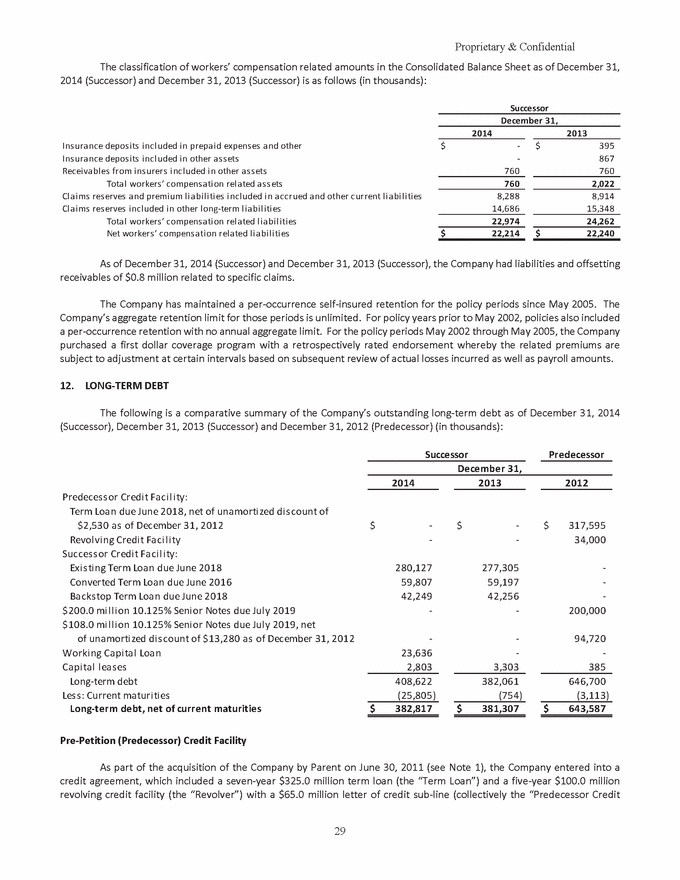
Proprietary & Confidential Facility”). The Revolver was amended on December 20, 2011 to increase the available amount from $100.0 million to $110.0 million. Term Loan The $325.0 million Term Loan, due June 2018, bore interest at LIBOR plus an applicable margin of 4.25% subject to a LIBOR floor of 1.50% or at the Company’s option, the Alternate Base Rate (ABR) as defined in the credit agreement plus 3.25% subject to an ABR floor of 2.50%. In the case of the LIBOR option, the Company contracted for periods that may be equal to one, two, three or six months from the date of initial borrowing and interest was payable on the last day of each contract period, subject to a maximum payment term of three months. Interest was payable at the end of each quarter for the ABR option. The Term Loan, which was collateralized by assets of the Company, required quarterly principal payments of 0.25% of the original principal balance, beginning September 30, 2011 through the maturity date. The Term Loan also required principal payments, as defined in the credit agreement, of: (1) 50% of fiscal year-end excess cash flow, which may decrease to 25% or 0% based on the total leverage ratio; (2) 100% of the net cash proceeds of all non-ordinary course asset sales or dispositions of property, subject to the Company’s right to reinvest or commit to reinvest 100% of such net proceeds in assets to be used in the business or to make certain other permitted investments within 12 months (as long as such reinvestment is completed within 180 days) in lieu of making such payment; and (3) 100% of the net cash proceeds of any incurrence of debt, other than proceeds from debt permitted under the Credit Facility. The Term Loan could be prepaid at any time at the option of the Company. On December 31, 2013 (Predecessor), prior to the implementation of the Plan of Reorganization, principal outstanding on the Term Loan was $318.5 million, and the unamortized original issue discount was $2.1 million. As part of the implementation of the Plan of Reorganization on December 31, 2013, a partial paydown of $41.2 million was made on the Term Loan from the $135.0 million of proceeds received by the Company as part of the issuance of new equity instruments of post-emergence Reorganized Parent. The remaining $277.3 million of principal outstanding after the partial paydown was converted into the Existing Term Loan as part of the Emergence (Successor) Credit Facility. The $2.1 million of unamortized original issuance discount as of December 31, 2013 (Predecessor) was written off and charged to Reorganization items in the Company’s Consolidated Statement of Operations. Debt issuance costs of $6.6 million related to the Term Loan were being amortized to interest expense over the term of the loan. The amount of unamortized debt issuance costs related to the Term Loan was $4.2 million at December 31, 2013 (Predecessor) prior to the implementation of the Plan of Reorganization. The $4.2 million of unamortized debt issuance costs as of December 31, 2013 (Predecessor) were written off and charged to Reorganization items in the Company’s Consolidated Statement of Operations. During 2013 (Predecessor) the effective interest rate of the Term Loan, inclusive of the accretion of the original issuance discount and the amortization of debt issuance costs, was 6.19%. Revolver The $110.0 million Revolver, which was scheduled to mature in June 2016, included a letter of credit sub-line that allowed $65.0 million of the facility to be utilized to issue letters of credit. Letters of credit issued under the facility reduced the borrowing capacity on the total facility dollar for dollar. When the Company requested a borrowing under the Revolver, the Company had to select whether the borrowing would be a Eurodollar loan or an ABR loan. Eurodollar loans bore interest at LIBOR plus an applicable margin of 4.25% subject to a LIBOR floor of 1.50%. ABR loans bore interest at the ABR as defined in the credit agreement plus an applicable margin of 3.25% subject to an ABR floor of 2.50%. In the case of a Eurodollar loan, the Company could request an initial interest period of one, two, three, or six months from the date of initial borrowing. Interest on Eurodollar loans was payable on the last day of each contract period, subject to a maximum payment term of three months. Interest was payable at the end of each quarter for an ABR loan. On either type of loan, interest accrued to the date of repayment was due with that repayment. 30

Proprietary & Confidential The Company was required to pay a quarterly commitment fee to the Revolver lenders equal to 0.50% on the undrawn revolving commitment. Additionally, the Company was required to pay an administrative fee of $125,000 per year in quarterly installments with the first installment due on the closing date. On December 31, 2013 (Predecessor), prior to the implementation of the Plan of Reorganization, $68.0 million was outstanding on the Revolver. As part of the implementation of the Plan of Reorganization on December 31, 2013, a partial paydown of $8.8 million was made on the Revolver from the $135.0 million of proceeds received by the Company as part of the issuance of new equity instruments of post-emergence Reorganized Parent. The remaining $59.2 million amount outstanding after the partial paydown was converted into the Converted Term Loan as part of the Emergence (Successor) Credit Facility. Debt issuance costs of $4.4 million related to the Revolver were being amortized to interest expense over the term of the facility. The amount of unamortized debt issuance costs related to the Revolver was $2.2 million at December 31, 2013 (Predecessor) prior to the implementation of the Plan of Reorganization. The $2.2 million of unamortized debt issuance costs as of December 31, 2013 (Predecessor) were written off and charged to Reorganization items in the Company’s Consolidated Statement of Operations. Letters of credit totaling $39.2 million were issued under the letter of credit sub-line as of December 31, 2013 (Predecessor) prior to the implementation of the Plan of Reorganization. Amounts related to outstanding letters of credit issued under the letter of credit sub-line to the Revolver bore a participation fee of 4.25% and a fronting fee of 0.125%, payable quarterly. These letters of credit primarily supported the Company’s future expected insurance claim payments or deductible arrangements. As part of the implementation of the Plan of Reorganization on December 31, 2013, the letters of credit were converted into the Exit Letter of Credit Facility collateralized by the Backstop Loan, as part of the Emergence (Successor) Credit Facility. Emergence (Successor) Credit Facility As part of the implementation of the Plan of Reorganization upon the Company’s emergence from Chapter 11 on December 31, 2013 (see Note 2), the Company entered into a credit agreement with Credit Suisse AG, as Administrative Agent, which included an Existing Term Loan due June 2018 (the “Existing Term Loan”), a Converted Term Loan due June 2016 (the “Converted Term Loan”), and an Exit Letter of Credit Facility supported by a Backstop Loan due June 2018 (the “Backstop Loan”). As part of the implementation of the Plan of Reorganization on December 31, 2013, the remaining portion of the Term Loan was converted into the Existing Term Loan, the remaining portion of the Revolver was converted into the Converted Term Loan, and the letters of credit that were part of the pre-petition (Predecessor) Credit Facility were converted into the Exit Letter of Credit Facility collateralized by the Backstop Loan. The Existing Term Loan and the Converted Term Loan are collateralized by substantially all of the assets of the Company, while the Backstop Loan is collateralized by the funds held on deposit that support the letters of credit. Existing Term Loan As part of the implementation of the Plan of Reorganization on December 31, 2013, the $277.3 million remaining portion of the Term Loan was converted into the Existing Term Loan. The Company can elect for the Existing Term Loan to be specified as either a Eurocurrency loan or an ABR loan. Eurocurrency loans bear interest at Adjusted LIBOR, as defined in the credit agreement, plus an applicable margin of 7.50%, provided that, prior to the second anniversary of the Effective Date, 6.50% shall be paid in cash and 1.00% shall be added to the principal balance (“Paid-in-Kind”), subject to an Adjusted LIBOR floor of 1.50%. ABR loans bear interest at the ABR as defined in the credit agreement plus an applicable margin of 6.50%, provided that, prior to the second anniversary of the Effective Date, 5.50% shall be paid in cash and 1.00% shall be Paid-in-Kind, subject to an ABR floor of 2.50%. In the case of a Eurocurrency loan, the Company may request an initial interest period of one, two, three, or six months from the date of initial borrowing. Interest on Eurocurrency loans is payable on the last day of each contract period, subject to a maximum payment term of three months. Interest is payable at the end of each quarter for an ABR loan. On either type of loan, interest accrued to the date of repayment is due with that repayment. Upon the Emergence Date, the Company elected that the Existing Term Loan be specified as a Eurocurrency loan. On December 31, 2015, the Company is required to repay approximately $20.6 million of principal on the Existing Term Loan. The Company has the right to prepay unpaid principal, in whole or in part, at any time prior to the maturity date without premium or penalty. If a voluntary payment is made prior to December 31, 2015, the payment will reduce the 31
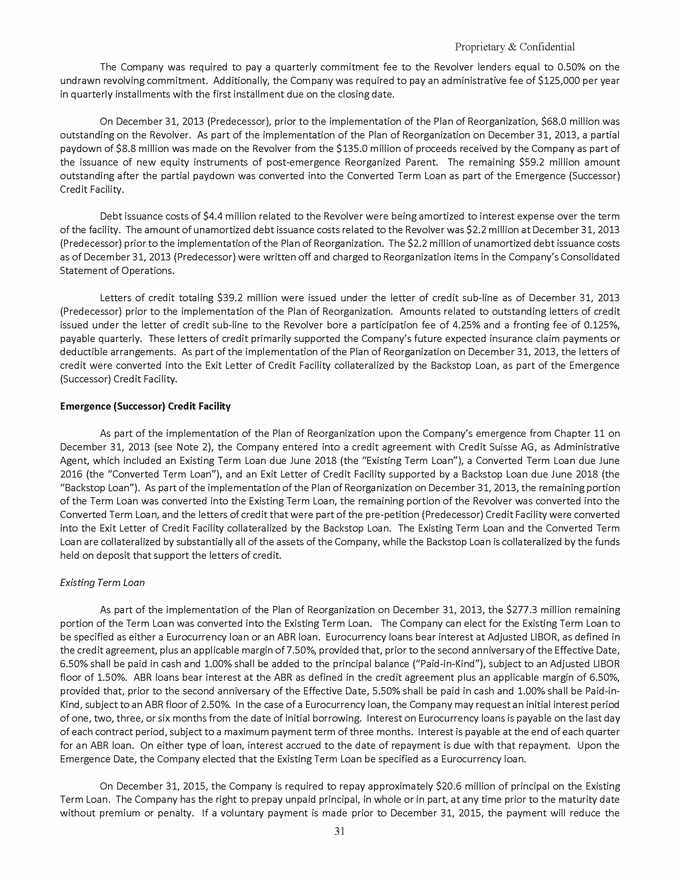
Proprietary & Confidential amount required to be paid on December 31, 2015 by the amount of the voluntary payment. The Company may be required to make prepayments upon the occurrence of certain events as specified in the credit agreement. The remaining unpaid principal is required to be repaid on the maturity date of June 30, 2018. Debt issuance costs of $1.4 million related to the Existing Term Loan are being amortized to interest expense over the term of the loan. During 2014 (Successor) the effective interest rate of the Existing Term Loan, inclusive of the amortization of debt issuance costs, was 9.11%. Converted Term Loan As part of the implementation of the Plan of Reorganization on December 31, 2013, the $59.2 million remaining portion of the Revolver was converted into the Converted Term Loan. The Company can elect for the Existing Term Loan to be specified as either a Eurocurrency loan or an ABR loan. Eurocurrency loans bear interest at Adjusted LIBOR, as defined in the credit agreement, plus an applicable margin of 7.50%, provided that, prior to the second anniversary of the Effective Date, 6.50% shall be paid in cash and 1.00% shall be Paid-in-Kind, subject to an Adjusted LIBOR floor of 1.50%. ABR loans bear interest at the ABR as defined in the credit agreement plus an applicable margin of 6.50%, provided that, prior to the second anniversary of the Effective Date, 5.50% shall be paid in cash and 1.00% shall be Paid-in-Kind, subject to an ABR floor of 2.50%. In the case of a Eurocurrency loan, the Company may request an initial interest period of one, two, three, or six months from the date of initial borrowing. Interest on Eurocurrency loans is payable on the last day of each contract period, subject to a maximum payment term of three months. Interest is payable at the end of each quarter for an ABR loan. On either type of loan, interest accrued to the date of repayment is due with that repayment. Upon the Emergence Date, the Company elected that the Converted Term Loan be specified as a Eurocurrency loan. On December 31, 2015, the Company is required to repay approximately $4.4 million of principal on the Converted Term Loan. The Company has the right to prepay unpaid principal, in whole or in part, at any time prior to the maturity date without premium or penalty. If a voluntary payment is made prior to December 31, 2015, the payment will reduce the amount required to be paid on December 31, 2015 by the amount of the voluntary payment. The Company may be required to make prepayments upon the occurrence of certain events as specified in the credit agreement. The remaining unpaid principal is required to be repaid on the maturity date of June 30, 2016. Debt issuance costs of $0.3 million related to the Converted Term Loan is being amortized to interest expense over the term of the loan. During 2014 (Successor) the effective interest rate of the Converted Term Loan, inclusive of the amortization of debt issuance costs, was 9.20%. Backstop Term Loan Letters of credit totaling $39.2 million were issued under the letter of credit sub-line of the Revolver as of December 31, 2013 (Predecessor) prior to the implementation of the Plan of Reorganization. Also prior to the implementation of the Plan of Reorganization on December 31, 2013, the Company had $2.0 million of letters of credit issued that were directly collateralized by the Company by $2.1 million of cash deposits held by Credit Suisse AG. As part of the implementation of the Plan of Reorganization on December 31, 2013, the issued letters of credit under the letter of credit subline of the Revolver was converted into the Exit Letter of Credit Facility supported by the Backstop Loan, as part of the Emergence (Successor) Credit Facility, and the $2.1 million of cash deposits that collateralized the $2.0 million of issued letters of credit were refunded to the Company by Credit Suisse AG. As part of the implementation of the Plan of Reorganization on December 31, 2013, the $39.2 million of issued letters of credit under the letter of credit subline of the Revolver was converted into the Exit Letter of Credit Facility and the $2.0 million of letters of credit previously collateralized by the Company was added to the Exit Letter of Credit Facility. The $41.2 million of total letters of credit included in the Exit Letter of Credit Facility was collateralized by the Backstop Loan, in an amount that was 102.5% of the value of the letters of credit, or $42.3 million. Collateral for the letters of credit of $41.8 million and $42.3 million is included in Deposits in the Company’s Consolidated Balance Sheets as of December 31, 2014 (Successor) and December 31, 2013 (Successor), respectively. 32
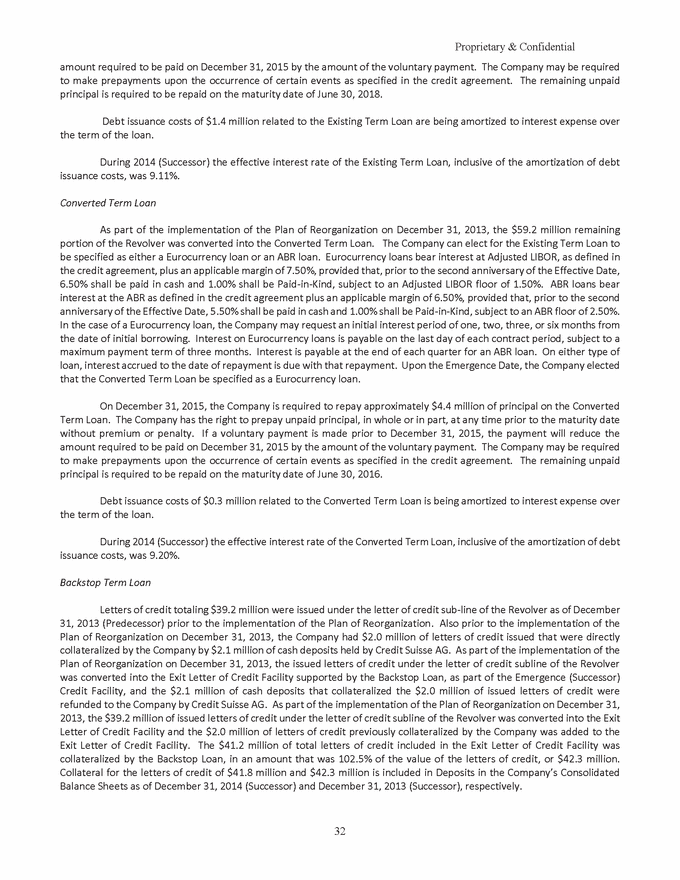
Proprietary & Confidential The Company can elect for the Existing Term Loan to be specified as either a Eurocurrency loan or an ABR loan. Eurocurrency loans bear interest at Adjusted LIBOR, as defined in the credit agreement, plus an applicable margin of 7.50%, provided that, prior to the second anniversary of the Effective Date, 6.50% shall be paid in cash and 1.00% shall be Paid-in-Kind, subject to an Adjusted LIBOR floor of 1.50%. ABR loans bear interest at the ABR as defined in the credit agreement plus an applicable margin of 6.50%, provided that, prior to the second anniversary of the Effective Date, 5.50% shall be paid in cash and 1.00% shall be Paid-in-Kind, subject to an ABR floor of 2.50%. In the case of a Eurocurrency loan, the Company may request an initial interest period of one, two, three, or six months from the date of initial borrowing. Interest on Eurocurrency loans is payable on the last day of each contract period, subject to a maximum payment term of three months. Interest is payable at the end of each quarter for an ABR loan. On either type of loan, interest accrued to the date of repayment is due with that repayment. Upon the Emergence Date, the Company elected that the Converted Term Loan be specified as a Eurocurrency loan. The Company has the right to prepay unpaid principal, in whole or in part, at any time prior to the maturity date without premium or penalty. The Company may be required to make prepayments upon the occurrence of certain events as specified in the credit agreement. The remaining unpaid principal is required to be repaid on the maturity date of June 30, 2018. During 2014, approximately $0.4 million of cash deposits collateralizing letters of credit was returned to the Company, and was used to paydown an equal amount of the Backstop Loan. Debt issuance costs of $1.1 million related to the Backstop Term Loan is being amortized to interest expense over the term of the loan. During 2014 (Successor) the effective interest rate of the Backstop Term Loan, inclusive of the amortization of debt issuance costs, was 9.51%. $200.0 million Senior Notes On June 30, 2011, the Company issued $200.0 million 10.125% Senior Notes that were scheduled to mature on July 15, 2019. Interest on the $200.0 million Senior Notes was payable semi-annually on January 15 and July 15, beginning January 15, 2012. The $200.0 million Senior Notes were senior unsecured obligations and ranked equally and ratably with all existing senior indebtedness. The $200.0 million Senior Notes were effectively subordinated to all existing secured indebtedness, including obligations under the Credit Facility, to the extent of the value of the assets securing such debt. The $200.0 million Senior Notes were unconditionally guaranteed jointly and severally on a senior unsecured basis by each of the Company’s subsidiaries that guaranteed the Credit Facility. The guarantees ranked equally in right of payment with all of the guarantors’ existing indebtedness and were effectively subordinated to their existing secured indebtedness to the extent of the value of the assets securing that indebtedness. Upon the Debtors’ filing for bankruptcy on August 4, 2013, the Company ceased accruing for interest payable related to the $200.0 million Senior Notes as the $200.0 million Senior Notes were reclassified to liabilities subject to compromise. The Company also ceased amortizing the remaining unamortized debt issuance costs related to the $200.0 million Senior Notes. As part of the implementation of the Plan of Reorganization on December 31, 2013, claims arising under the $200.0 million Senior Notes were converted into common stock of WP Rocket Holdings Inc. upon the Company’s emergence from Chapter 11. The cancellation of the $200.0 million Senior Notes that resulted from the implementation of the Plan of Reorganization on December 31, 2013 was recognized within Reorganization items in the Company’s Consolidated Statement of Operations. Cancellation of interest payable of $11.3 million related to the $200.0 million Senior Notes was also recognized within Reorganization items in the Company’s Consolidated Statement of Operations. Debt issuance costs of $4.6 million related to the $200.0 million Senior Notes were being amortized to interest expense over the term of the facility resulting in an effective interest rate of 10.41% during 2013 (Predecessor). The amount of unamortized debt issuance costs related to the $200.0 million Senior Notes was $3.4 million at December 31, 2013 (Predecessor) prior to the implementation of the Plan of Reorganization. The $3.4 million of unamortized debt issuance costs 33
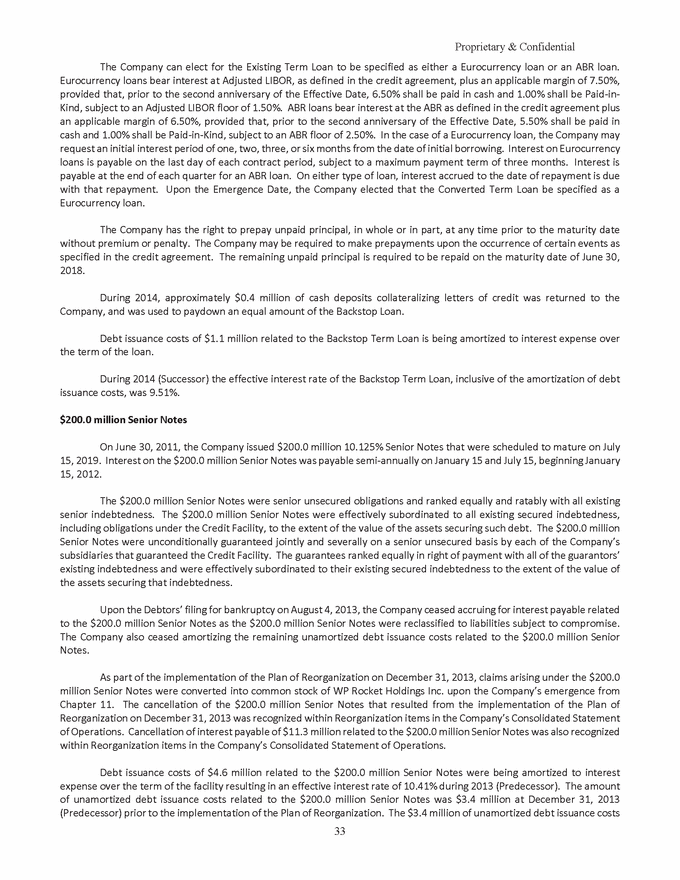
Proprietary & Confidential as of December 31, 2013 (Predecessor) were written off and charged to Reorganization items in the Company’s Consolidated Statement of Operations. $108.0 million Senior Discount Notes On February 3, 2012, the Company issued $108.0 million 10.125% Senior Discount Notes due 2019 (“$108.0 million Senior Notes”). The proceeds, net of the original issue discount, from the issuance of the notes were $92.9 million. The $108.0 million Senior Notes bore interest at a stated rate of 10.125% per annum and was scheduled to mature on July 15, 2019. Interest on the notes was payable semi-annually in arrears on January 15 and July 15 of each year. The $108.0 million Senior Notes were senior unsecured obligations and ranked equally and ratably with all existing senior indebtedness. The notes were effectively subordinated to all of the Company’s existing secured indebtedness, including obligations under its senior secured credit facilities, to the extent of the value of the assets securing such debt. The $108.0 million Senior Notes were unconditionally guaranteed jointly and severally on a senior unsecured basis by each of our subsidiaries that guaranteed the Company’s Credit Facility. The guarantees ranked equally in right of payment with all of the subsidiary guarantors’ existing indebtedness and were effectively subordinated to their existing secured indebtedness to the extent of the value of the assets securing that indebtedness. To the extent lenders under the senior secured credit facilities released any subsidiary guarantor from the Company’s obligations; such subsidiary guarantor would also be released from its obligations under the notes. The $108.0 million Senior Notes were structurally subordinated to all obligations of any of the Company’s subsidiaries that do not guarantee the notes. Upon the Debtors’ filing for bankruptcy on August 4, 2013, the Company ceased accruing for interest payable related to the $108.0 million Senior Notes as the $108.0 million Senior Notes were reclassified to liabilities subject to compromise. The Company also ceased amortizing the remaining unamortized original issuance discount and unamortized debt issuance costs related to the $108.0 million Senior Notes. As part of the implementation of the Plan of Reorganization on December 31, 2013, claims arising under the $108.0 million Senior Notes were converted into common stock of WP Rocket Holdings Inc. upon the Company’s emergence from Chapter 11. The cancellation of the $108.0 million Senior Notes that resulted from the implementation of the Plan of Reorganization on December 31, 2013 was recognized within Reorganization items in the Company’s Consolidated Statement of Operations. Cancellation of interest payable of $6.0 million related to the $108.0 million Senior Notes was also recognized within Reorganization items in the Company’s Consolidated Statement of Operations. On December 31, 2013 (Predecessor), prior to the implementation of the Plan of Reorganization, the unamortized original issue discount was $12.1 million. The $12.1 million of unamortized original issuance discount as of December 31, 2013 (Predecessor) was written off and charged to Reorganization items in the Company’s Consolidated Statement of Operations. Debt issuance costs of $2.0 million related to the $108.0 million Senior Notes were being amortized to interest expense over the term of the facility resulting in an effective interest rate of 12.22% during 2013 (Predecessor). The amount of unamortized debt issuance costs related to the Term Loan was $1.6 million at December 31, 2013 (Predecessor) prior to the implementation of the Plan of Reorganization. The $1.6 million of unamortized debt issuance costs as of December 31, 2013 (Predecessor) were written off and charged to Reorganization items in the Company’s Consolidated Statement of Operations. Working Capital Loan On November 4, 2014 (and subsequently amended on November 28, 2014), the Company entered into a credit agreement with certain shareholders of Reorganized Parent, whereby the Company is able to borrow up to $25.0 million of term loans through draws to be made at its request. The first $15.0 million of term loans are to be secured term loans, and the last $10.0 million of term loans are to be unsecured term loans. Secured term loans are collateralized by substantially all of the Company’s assets not already secured under the Company’s other credit facilities. The maturity date of the term loans is January 31, 2016, upon which all outstanding principal and interest is due and payable. The Company may prepay any borrowing amounts, in whole or in part, prior to the January 31, 2016 maturity date without premium or penalty. Effective April 30, 2015, the Company extended the maturity date for approximately 84% of the working capital term loans to June 1, 2016. Interest is payable on the last business day of each calendar month, at a rate of 12.5% per annum for secured term 34
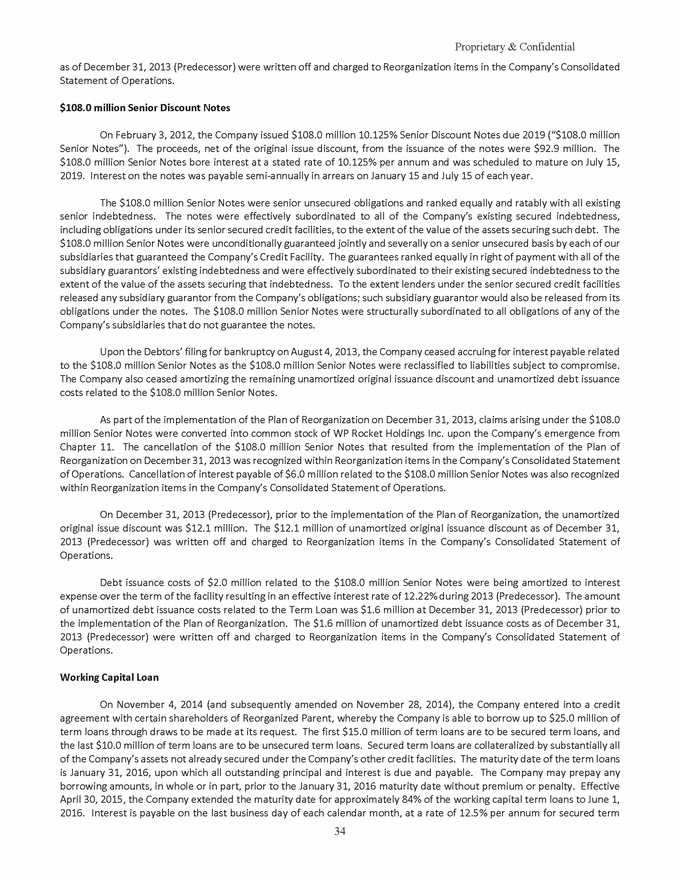
Proprietary & Confidential loans and 17.5% per annum for unsecured term loans. These rates may increase by 2.0% per annum if the Company’s aggregate cash receipts fall below certain specified levels. This did occur as of December 9, 2014, and the rates increased to 14.5% per annum for secured term loans and 19.5% per annum for unsecured term loans as of that date. The Company may elect to pay the interest in cash or have the interest be Paid-in-Kind. The Company made an initial draw on November 4, 2014 of approximately $11.1 million, consisting of $10.0 million of cash proceeds to the Company and the payment of $1.1 million of draw and transaction fees. On December 1, 2014, the Company made a subsequent draw of approximately $12.1 million, consisting of $10.8 million of cash proceeds to the Company and the payment of $1.3 million of draw and transaction fees. The Company also paid $0.8 million of other transaction fees outside of the draw transactions. The $3.2 million of total draw and transaction fees are being amortized to interest expense over the term of the loan. DIP Financing On August 4, 2013, the Company entered into a senior secured super priority debtor in possession credit agreement (the “DIP Financing”), with an effective date of August 7, 2013. The DIP Financing provided a term loan facility of $75.0 million in the aggregate which was intended to provide the Company with sufficient liquidity to meet its operational and restructuring needs during the Chapter 11 process. On August 6, 2013, the Bankruptcy Court granted interim approval for the Company to utilize up to $40 million of the DIP Financing, and on September 10, 2013, the Bankruptcy Court granted final approval for the Company to utilize the remaining $35 million of the DIP Financing. Upon the effective date of the DIP Financing, the Company could elect that the DIP Financing be specified as a Eurocurrency loan or an ABR loan. Eurocurrency loans bear interest at LIBOR plus an applicable margin of 9.50%. 8.50% shall be paid in cash and 1.00% shall be Paid-in-Kind, subject to a LIBOR floor of 1.50%. ABR loans bear interest at the ABR as defined in the credit agreement plus an applicable margin of 8.50%. 7.50% shall be paid in cash and 1.00% shall be Paid-in-Kind, subject to an ABR floor of 2.50%. In the case of a Eurocurrency loan, the Company may request an initial interest period of one, two, three, or six months from the date of initial borrowing. Interest is payable at the end of each month for a Eurocurrency loan and for an ABR loan. The DIP Financing was an ABR loan as of the effective date of the DIP Financing, and subsequently converted to a Eurocurrency loan. The DIP Financing was scheduled to mature the earliest of March 31, 2014 or the effective date of any Chapter 11 plan of the Debtors, or other specified events. On December 31, 2013, the Company emerged from Chapter 11 bankruptcy protection, and as part of the implementation of the Plan of Reorganization, all outstanding principal and interest was paid on December 31, 2013. Debt issuance costs of $3.6 million related to the DIP Financing were amortized to interest expense over the term of the facility through December 31, 2013, resulting in an effective interest rate of 26.7% during 2013 (Predecessor). Debt Maturities Aggregate annual maturities of long-term debt as of December 31, 2014 (Successor) for each of the years ending December 31 are as follows (in thousands): 2015 2016 2017 2018 2019 Thereafter $ 25,805 79,683 311 302,003 177 643 $ 408,622 35
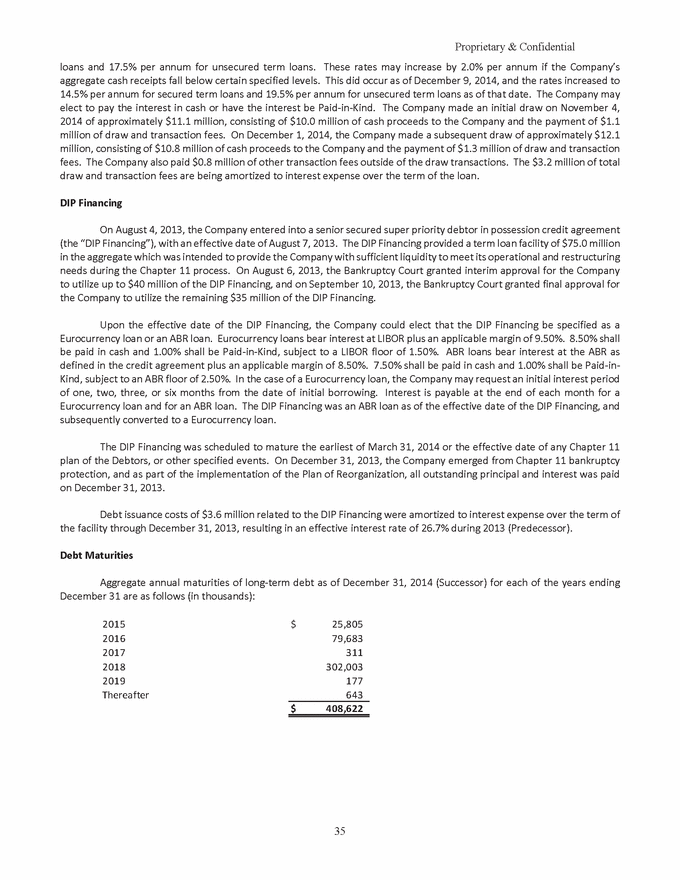
Proprietary & Confidential Debt Covenants Successor Debt Covenants The Successor Credit Facility includes various financial and non-financial covenants applicable to the Company as well as quarterly and annual financial reporting obligations. These covenants, among other things, restrict the Company’s ability to incur additional indebtedness; create liens; engage in mergers or consolidations; sell or transfer assets; engage in certain sale and leaseback transactions; pay dividends and distributions or repurchase capital stock; make investments, loans or advances; make certain acquisitions; engage in certain transactions with affiliates; and change its fiscal year other than the change to a December 31 fiscal year made upon emergence from Chapter 11 bankruptcy. Beginning with the quarter ended June 30, 2015, the Company will be subject to maximum Total Leverage Ratio of the following: Maximum Total Period Leverage Ratio Fiscal quarter ended June 30, 2015 Fiscal quarter ended September 30, 2015 Fiscal quarter ended December 31, 2015 Fiscal quarter ended March 31, 2016 Fiscal quarter ended June 30, 2016 Fiscal quarter ended September 30, 2016 Fiscal quarter ended December 31, 2016 Fiscal quarter ended March 31, 2017 Fiscal quarter ended June 30, 2017 Fiscal quarter ended September 30, 2017 Fiscal quarter ended December 31, 2017 Fiscal quarter ended March 31, 2018 Fiscal quarter ended June 30, 2018 8.90: 1.00 8.80: 1.00 8.10: 1.00 8.00: 1.00 7.80: 1.00 7.60: 1.00 7.50: 1.00 7.20: 1.00 7.10: 1.00 7.00: 1.00 6.80: 1.00 6.50: 1.00 6.40: 1.00 Total Leverage Ratio, as defined in the credit agreement, is the ratio of Consolidated Debt as of the test date to adjusted Consolidated EBITDA for the most recently ended Test Period. The Test Period is the period of four consecutive quarters through the test date. In addition, commencing with the calendar year ended December 31, 2015 and each calendar year thereafter, the Company will shall not make annual Capital Expenditures, as defined in the credit agreement, in an amount exceeding the Permitted Capital Expenditure amount, as defined in the credit agreement. 13. INCOME TAXES The Company operates solely within the United States. The following table shows the components of the income tax provision from operations (in thousands): Successor Predecessor Year Ended December 31, 2014 2013 Current income tax (provision) benefit Deferred income tax (provision) Total income tax (provision) Continuing operations (provision) Discontinued operations benefit Total income tax (provision) $ (2,369) $ 426 - (34,768) (2,369) (34,342) (2,369) - (35,792) 1,450 $ (2,369) $ (34,342) 36
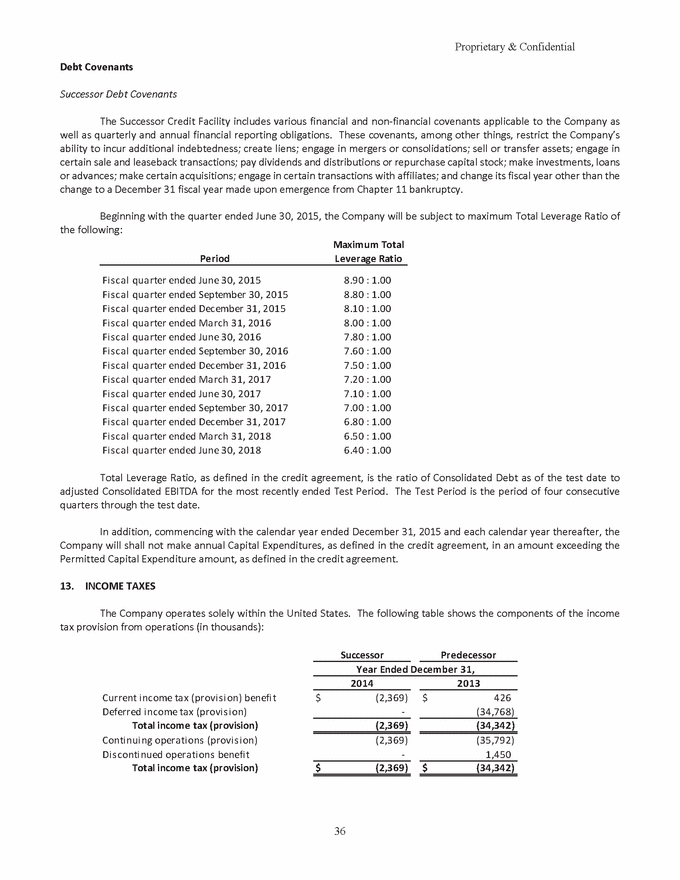
Proprietary & Confidential The following table shows the components of the income tax provision applicable to continuing operations (in thousands): Successor Predecessor Year Ended December 31, 2014 2013 Current: Federal State Total Deferred: Federal State Total Total income tax (provision) attributable to continuing operations $ - $ - (2,369) 418 (2,369) 418 - - (42,407) 6,197 - (36,210) $ (2,369) $ (35,792) The income tax provision differs from the amount computed by applying the statutory U.S. federal income tax rate of 35% to loss from continuing operations before income taxes as follows (in thousands): Successor Predecessor Year Ended December 31, 2014 2013 Federal income tax benefit at statutory rate State taxes, net of federal tax benefit Change in valuation allowance Disallowed interest on Senior Discount Notes Goodwill impairment Change in reserve estimates Non-deductible bankruptcy expenses Penalties Change in state blended tax rate Other, net Total income tax (provision) attributable to continuing operations $ 13,745 1,626 (13,953) - - (2,109) (633) - (951) $ 58,139 (1,191) 5,561 (706) (89,635) - (9,070) (1,008) 2,303 (94) (185) $ (2,369) $ (35,792) 37
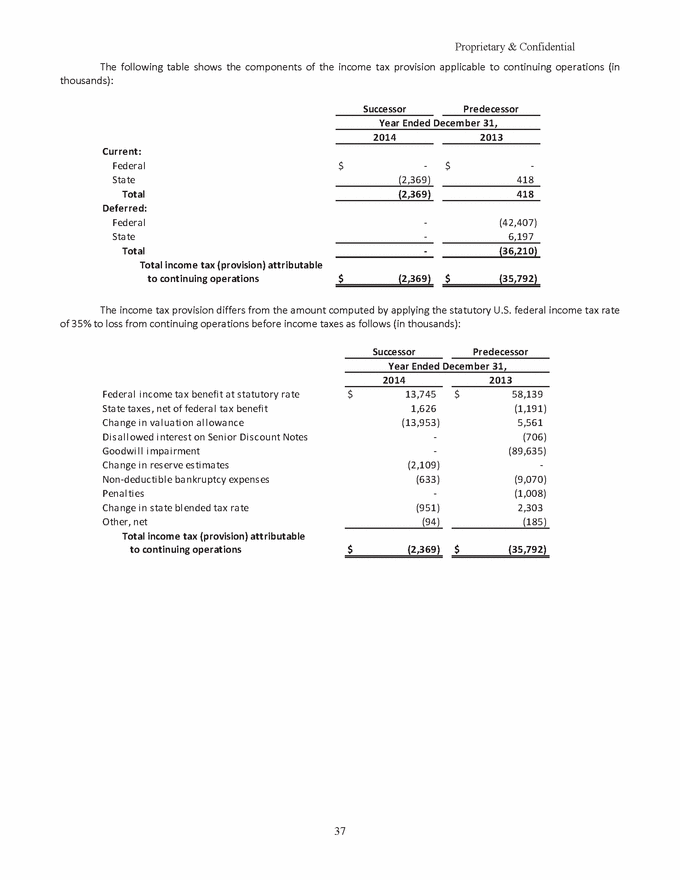
Proprietary & Confidential The following table summarizes the components of the Company’s deferred tax assets and liabilities (in thousands): Successor December 31, 2014 2013 Deferred tax assets: Net operating loss carryforwards Tax credit carryforwards Insurance claim reserves Estimate for uncompensated care Compensation and benefits Other Deferred tax assets Deferred tax liabilities: Attribute reduction Accelerated depreciation and amortization Tax accounting method change Deferred tax liabilities Net deferred tax liabilities before valuation allowance Less: valuation allowance Net deferred tax liability $ 84,400 3,061 14,751 31,817 5,911 $ 88,129 2,880 14,560 20,438 4,010 5,119 4,408 145,059 134,425 (124,926) (77,487) - (124,093) (81,400) (3,876) (202,413) (209,369) (57,354) (17,946) (74,944) (356) $ (75,300) $ (75,300) The restructuring transactions in the Plan of Reorganization substantially reduced debt obligations by (i) providing for a $50.0 million payment of the pre-petition Credit Facility and (ii) converting claims arising under the $200.0 million Senior Notes and the $108.0 million Senior Notes and any unsecured claim against the Debtors other than a Noteholder Claim into 100% of the common stock of Reorganized Parent. Pursuant to various provisions contained in Internal Revenue Code (“IRC”) Section 108(e), these transactions resulted in Cancellation of Debt (COD) income for income tax purposes of approximately $319 million. IRC Section 108(a)(1)(A) provides that COD income is excluded from gross income when the discharge occurs in a Chapter 11 case under the jurisdiction of the bankruptcy court. However, pursuant to IRC Section 108(b)(1), if COD income is excluded due to the application of the bankruptcy exception, the amount of excluded COD income must generally be applied to reduce certain tax attributes of the debtor. In general, such attributes would normally be reduced in the following order: (1) net operating losses (current and carry forward); (2) general business tax credits; (3) minimum tax credits; (4) capital loss carryovers; (5) tax basis of the taxpayer’s assets; (6) passive activity losses and credit carryovers; and (7) foreign tax credit carryovers. Under IRC Section 108(b)(4)(a), the tax attribute reduction generally occurs after determining the taxpayer’s income tax liability for the year of the debt discharge. Currently, the Company anticipates its tax attributes will be reduced in connection with the exclusion of the COD income. A deferred tax liability of approximately $124 million was recorded at December 31, 2013 (Successor) in anticipation of this tax attribute reduction in 2014. However, the attribute reduction study was not finalized as of December 31, 2014, and consequently the deferred tax liability of $124 million remains pending completion of such study. The attribute reduction study is necessary for purposes of determining which deferred tax assets will ultimately be reduced and for preparing and filing the 2014 federal income tax return and thus must be completed during 2015. In connection with the Company’s emergence from the Chapter 11 bankruptcy proceedings, it experienced an "ownership change" as defined in Section 382 of the Internal Revenue Code on December 31, 2013. Section 382 of the Internal Revenue Code contains rules that limit the ability of a company that undergoes an "ownership change" to utilize its net operating loss carryforwards and certain tax credits. The Company may be able to retain a portion of its U.S. federal and state net operating loss and tax credit carry forwards in connection with the ownership change. However, Internal Revenue Code, or the IRC, Sections 382 and 383 provide an annual limitation with respect to the ability of a corporation to utilize its tax attributes against future U.S. taxable income in the event of a change in ownership. In the Company’s situation, the limitation under the IRC will generally be based on the value of the Company’s equity (for purposes of the applicable tax rules) on or immediately following the time of emergence. As a result, the Company’s future U.S. taxable income may not be fully offset by any remaining tax attributes if such income exceeds the Company’s annual limitation, and the Company may 38
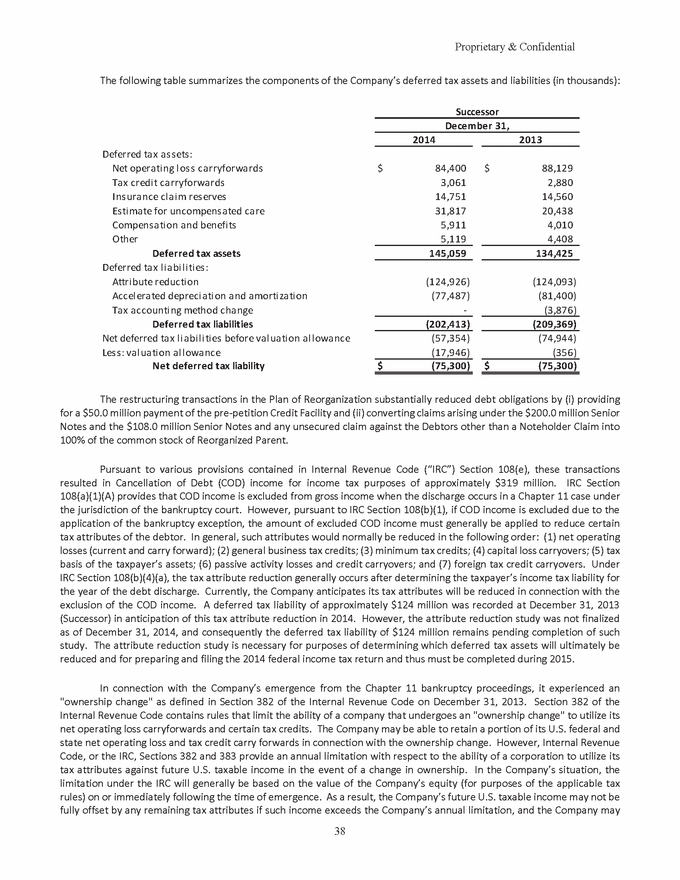
Proprietary & Confidential incur a tax liability with respect to such income. In addition, subsequent changes in ownership for purposes of the IRC could further diminish the Company’s ability to utilize tax attributes. An annual limitation related to the December 31, 2013 ownership change has not been calculated because the Company has not determined that there will be any tax attributes remaining subsequent to the required tax attribute reduction under IRC Section 108(b)(1) referenced above. The Company intends to prepare a formal Section 382 analysis covering the bankruptcy emergence during 2015 for purposes of preparing and filing the 2014 federal income tax return. The June 30, 2011 merger transaction with WP Rocket Holdings Inc. was also considered an ownership change for Section 382 purposes. The Company’s pre-change NOL’s are realizable subject to an annual limit based on the value of that transaction. The Company’s annual limitation is $9.4 million with a potential increase of the limitation to $25 million for any built-in gains recognized during the five-year period ending June 30, 2016. As of December 31, 2014, the Company had estimated gross net operating loss (“NOL”) carryforwards for federal income tax purposes of approximately $204 million, which expire in 2021-2033, and state NOL carryforwards of approximately $318.7 million, which expire in 2014-2033. The Company had Federal Minimum Tax credit carryforwards of $1.7 million. These credits can be carried forward indefinitely, but they may only be used to the extent that regular tax exceeds the federal alternative minimum tax in any given year. The Company also had Federal General Business Credit carryforwards of $1.2 million, which expire in 2023-2033. These NOL and credit carryforwards will be subject to tax attribute reduction due to the excluded COD income of $319 million as discussed above. Management regularly assesses the recoverability of the Company’s deferred tax assets and records a valuation allowance for any such assets where recoverability is determined to be unlikely. The Company’s evaluation of its valuation allowance against the current year increase in certain deferred tax assets and certain state deferred tax assets resulted in a valuation allowance at December 31, 2014 of $17.9 million. The Company determined that realization of these deferred tax assets is not more likely than not based on past results and projected future results. Valuation allowance adjustments resulted in a net tax expense of $17.6 million during 2014 (Successor). A summary of activity in the Company’s valuation allowance for deferred tax assets during 2014 (Successor) and 2013 (Predecessor) is as follows (in thousands): Successor Predecessor Year Ended December 31, 2014 2013 Balance at beginning of period Valuation allowance established Valuation allowance released Balance at end of period $ 356 17,590 $ 5,917 - - (5,561) $ 17,946 $ 356 As of December 31, 2014 (Successor), the Company had unrecognized tax benefits related to uncertain tax positions totaling approximately $24.7 million. As of December 31, 2014 (Successor), approximately $22.5 million of the total unrecognized tax benefits is presented on the balance sheet as a reduction of deferred tax assets related to net operating losses. The remaining amount of unrecognized tax benefits of approximately $2.2 million is included in other long-term liabilities on the balance sheet. 39
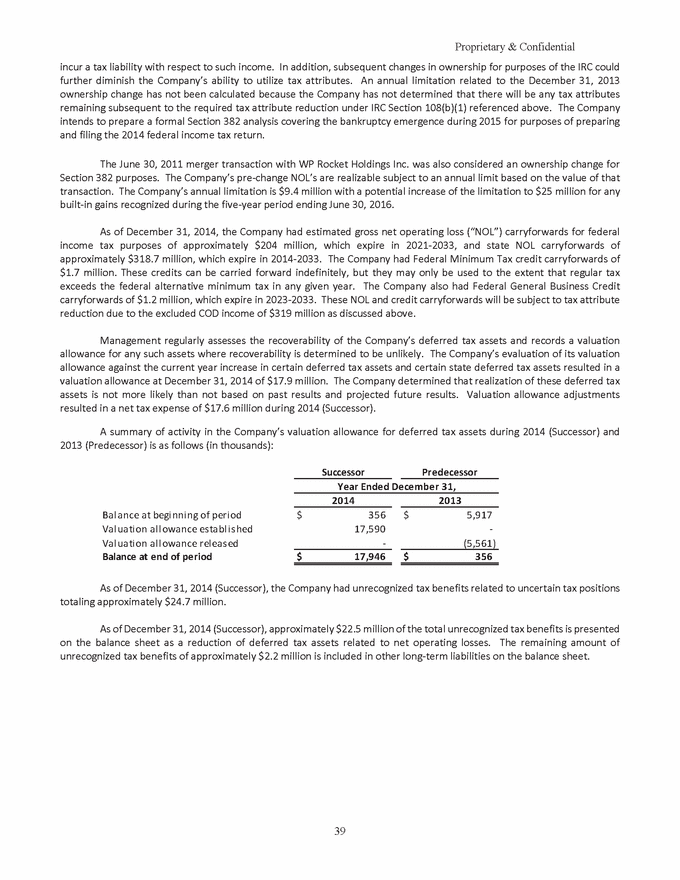
Proprietary & Confidential A reconciliation of the beginning and ending amount of unrecognized tax benefits is as follows (in thousands): Successor Predecessor Year Ended December 31, 2014 2013 Unrecognized tax benefits balance at beginning of period Additions for tax positions taken in current periods Additions for tax positions taken in prior periods Reductions for tax positions taken in prior periods Reductions for settlements with tax authorities Reductions for lapses of statute of limitations Unrecognized tax benefits balance at end of period $ 22,584 853 1,273 - - $ 30,025 - 48 (6,996) - (17) (493) $ 24,693 $ 22,584 In 2014, the Company reevaluated certain state filing methodologies, which resulted in a change to the combined filing approach on certain tax returns. This new method was applied on original returns for the tax years ended June 30, 2013 and December 31, 2013, respectively, as well as refund claims for open periods prior to June 30, 2013, which were filed separately. As this method could be disallowed and the Company is currently under audit by a state taxing jurisdiction, the Company recorded a new uncertain tax position in 2014 for the potential exposure related to the combined filings of $2.2 million, including potential accrued interest and penalties of $0.1 million, as of December 31, 2014. The Company and its subsidiaries have significant operations in the following jurisdictions: Arizona, California, Florida, Indiana, New York, Ohio and Tennessee. The Company generated tax Net Operating Losses (“NOLs”) in various years for federal and state income tax purposes. The statute of limitations period for a particular tax year for examination by the Internal Revenue Service is generally three years subsequent to the filing of the associated tax return. As a result, the 2010 through 2013 tax years remain open and subject to examination by the Internal Revenue Service. However, the Internal Revenue Service can adjust NOL carryovers up to three years subsequent to the last year in which the loss carryover is finally used. Accordingly, the losses generated or utilized in the closed tax years may be subject to adjustment. The statute of limitations period for state income tax purposes is generally three to four years for many of the states in which the Company operates. As a result, the 2009 through 2013 tax years generally remain open and subject to examination by the state taxing authorities. The Company is currently under examination by the state of New York related to the June 30, 2010 through December 31, 2013 income tax returns. The Company does not have any additional active income tax examinations in any tax jurisdictions. 14. PROCEEDS FROM REORGANIZED PARENT’S ISSUANCE OF PREFERRED STOCK On December 9, 2014, the Company received approximately $25.2 million in cash from Reorganized Parent as a result of Reorganized Parent’s issuance of 19.5% Class C Senior Redeemable Preferred Stock of Reorganized Parent (“Class C Senior Preferred Stock”) and common stock. The $25.2 million was net of approximately $1.4 million of fees related to the issuance deducted from the proceeds. In addition, approximately $0.2 million of additional professional fees were incurred by the Company related to the issuance of the new Reorganized Parent equity. The cash received by the Company, net of the fees related to the equity issuance incurred by the Company, was classified as an increase to additional paid-in capital in the Company’s Consolidated Balance Sheets during 2014 (Successor). 26,507,378 shares of Class C Senior Preferred Stock were issued. The liquidation preference of the Class C Senior Preferred Stock is $1.00 per share (the “Class C Liquidation Preference”). Pursuant to the Certificate of Designations, the Class C Senior Preferred Stock ranks senior to the Class A Senior Preferred Stock and the Class B Redeemable Preferred Stock (the “Class B Preferred Stock”). The Holders of the outstanding shares of Class C Senior Preferred Stock are entitled to receive, when, as and if declared by Reorganized Parent’s Board of Directors, cumulative preferential dividends on each share of Class C Senior Preferred Stock at a rate per annum equal to 19.5% of the Class C Liquidation Preference of the Class C Senior Preferred Stock, accruing and payable quarterly, in arrears. All dividends will be cumulative from the date of issuance, shall accumulate to the extent they are not paid on a dividend payment date for the quarterly period to which they relate and shall accumulate on a daily basis whether or not dividends are declared by Reorganized Parent’s Board of Directors. Dividends on the Class C Senior 40
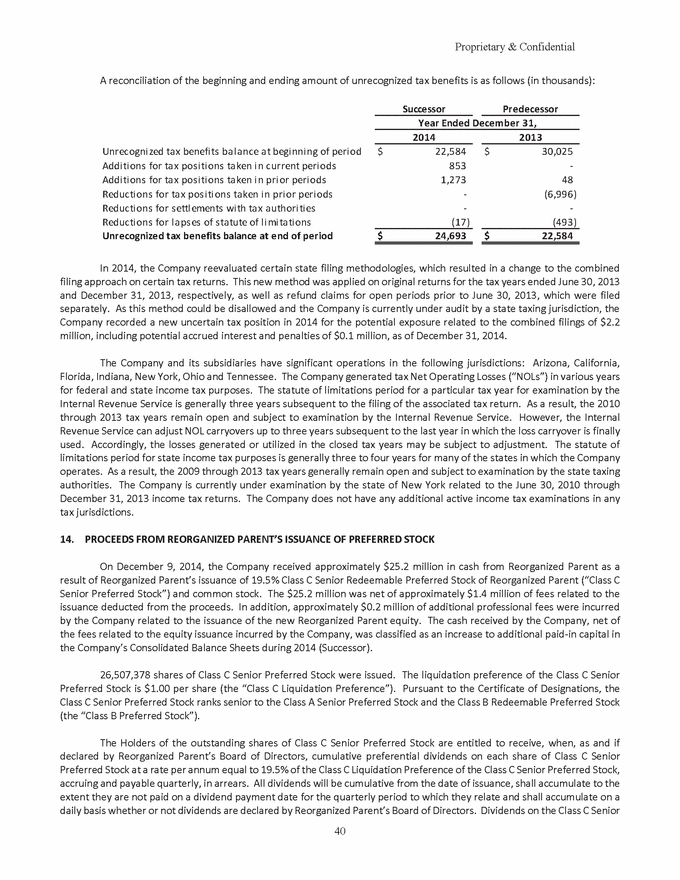
Proprietary & Confidential Preferred Stock, when, as and if declared by Reorganized Parent’s Board of Directors, shall be paid in additional fully-paid and non-assessable shares of Class C Senior Preferred Stock (“Class C Paid In-Kind Dividends”). The issuance of any such Class C Paid In-Kind Dividend shall constitute full payment of such dividend. The Class C Senior Preferred Stock contains two redemption features. A Conditional Mandatory Redemption shall occur no sooner than March 31, 2021, if the Company’s EBITDA, as defined in the Certificate of Designations of the Class C Senior Preferred Stock, for any 12-month period ending December 31, beginning in 2020, exceeds $100.0 million. The redemption price per share would be paid in cash in an amount equal to 100% of the Liquidation Preference, plus an amount in cash equal to all accrued and unpaid dividends per share. If any shares of outstanding Class C Senior Preferred Stock are not redeemed on March 31, 2021, then the Maturity Mandatory Redemption Price with respect to such shares shall increase by 1% per annum for the 180-day period following March 31, 2021 (unless extended) and by 2% per annum thereafter, until the Class C Senior Preferred Stock is redeemed in full. Separately, an Optional Redemption feature allows for Reorganized Parent, at its option, from time to time, redeem some or all of the outstanding Class C Senior Preferred Stock at a redemption price per share in cash equal to 100% of the Class C Liquidation Preference, plus an amount in cash equal to all accrued and unpaid dividends per share. As of December 31, 2014, Reorganized Parent had the following number of shares of issued and outstanding, in order of priority/rank: December 31, 2014 (unaudited) Class C Senior Preferred Stock Cl as s A Senior Preferred Stock Cl as s B Preferred Stock Common Stock 26,507,378 136,471,251 15,830,669 702,008,419 15. SHARE-BASED COMPENSATION Effective August 11, 2014, Reorganized Parent adopted the 2014 Equity Incentive Plan (the “2014 Plan”), which provided for the granting of incentive stock options, non-qualified stock options, restricted stock units, restricted stock and other stock-based awards. At the time of adoption, the maximum number of shares of preferred stock and common stock of Reorganized Parent issuable under the 2014 Plan was 16,374,000 and 25,000,000 shares, respectively. During 2014, Reorganized Parent issued restricted stock awards to members of the Board of Directors and certain officers and employees of the Company. The restricted stock awards granted were of shares of Class B Redeemable Preferred Stock (“Class B Preferred Stock”) of Reorganized Parent and shares of common stock of Reorganized Parent. The restricted stock awards vest either over a five-year period, at 20% on each anniversary date of the date of grant, or over a three-year period, in equal quarterly installments. Restricted stock awards are valued at fair value, and the total value of the award is expensed ratably over the service period of the recipients of the grants. As of December 31, 2014 (Successor), the total amount of unrecognized compensation cost related to nonvested restricted stock awards, to be recognized as expense subsequent to December 31, 2014, was approximately $2.5 million, and the related weighted-average period over which it is expected to be recognized is approximately 3.8 years. Fair value of the restricted stock awards was determined using the option pricing method, which utilizes the enterprise value of the company, equity value, time to liquidation, risk-free rate and volatility, with an additional discount for lack of marketability of the equity instruments. Time to liquidation was estimated to be three years, the risk-free rate used was 0.95%, the volatility used was 80.0% and the discount for lack of marketability used was 0% for the Class B Preferred Stock and 30.0% for the Common Stock. Share-based compensation expense recognized during 2014 (Successor) was $0.2 million. The share-based compensation expense was recorded as payroll and employee benefits expense in the Consolidated Statement of Operations. 41
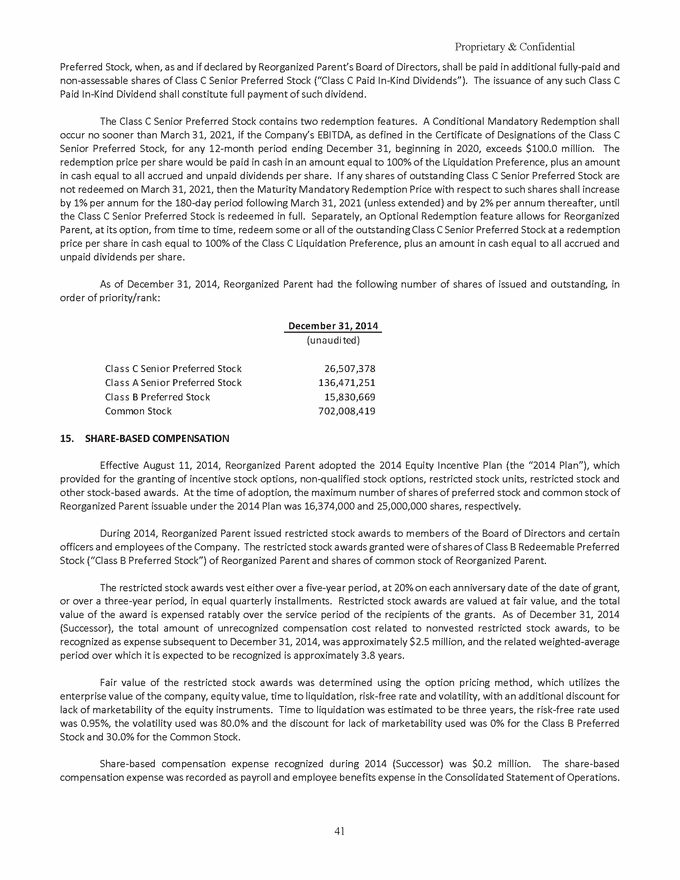
Proprietary & Confidential The following table summarizes restricted stock award activity in the 2014 Plan during 2014 (Successor): Class B Preferred Stock Common Stock Weighted-Average Grant-Date Fair Value Weighted-Average Grant-Date Fair Value Number of Shares Number of Shares Nonvested at Effective Date of Plan, August 11, 2014 - $ - - $ - Granted Vested Forfeited 15,830,669 - - $ $ $ 0.10 - - 22,900,443 - - $ $ $ 0.05 - - Nonvested at December 31, 2014 (Success or) 15,830,669 $ 0.10 22,900,443 $ 0.05 The liquidation preference of the Class B Preferred Stock is $0 per share at issuance, and shall increase by $0.0375 per share per quarter (the “Class B Liquidation Preference”). The Class B Preferred Stock ranks equally to the Class A Senior Preferred Stock after the Class A Senior Preferred Stock receives $1.00 per share of preference. The Holders of the outstanding shares of Class B Preferred Stock are not entitled to receive cumulative preferential dividends. The Class B Preferred Stock contains two redemption features. A Conditional Mandatory Redemption shall occur no sooner than March 31, 2021, if the Company’s EBITDA, as defined in the Certificate of Designations of the Class B Preferred Stock, for any 12-month period ending December 31, beginning in 2020, exceeds $100.0 million. The redemption price per share would be paid in cash in an amount equal to 100% of the Liquidation Preference. If any shares of outstanding Class B Preferred Stock are not redeemed on March 31, 2021, then the Maturity Mandatory Redemption Price with respect to such shares shall increase by 1% per annum for the 180-day period following March 31, 2021 (unless extended) and by 2% per annum thereafter, until the Class B Preferred Stock is redeemed in full. Separately, an Optional Redemption feature allows for Reorganized Parent, at its option, from time to time, redeem some or all of the outstanding Class B Preferred Stock at a redemption price per share in cash equal to 100% of the Class B Liquidation Preference. 16. EMPLOYEE BENEFIT PLANS 401(k) Plan The Company has a defined contribution plan (“401(k) Plan”) covering eligible employees. The 401(k) Plan allows employees to contribute a portion of their compensation on a pre-tax or post-tax basis in accordance with plan and statutory rules. The Company matches a percentage of the employee’s contributions according to the 401(k) Plan rules. Contributions for non-union employees are made at the Company’s discretion. The match may be made subject to the 401(k) Plan terms. The Company may also make discretionary profit sharing contributions subject to the 401(k) Plan terms. The Company did not make discretionary profit sharing contributions during 2014 (Successor) or 2013 (Predecessor). During 2014 (Successor) and 2013 (Predecessor), the Company recognized expense from continuing operations related to matching contributions under the 401(k) Plan of $1.8 million and $3.2 million, respectively. The contributions expense was recorded as payroll and employee benefits expense in the Consolidated Statement of Operations. The Company’s matching contribution liability was $2.2 million and $2.3 million as of December 31, 2014 (Successor) and December 31, 2013 (Successor), respectively. The employer 401(k) match for non-union employees is typically paid into the employees’ 401(k) plan after the end of the year that it is earned. The 401(k) match for 2013 was accrued for during 2013 and remained as a liability on the Company’s balance sheet as of and subsequent to December 31, 2013. As a result of the Bankruptcy that the Company entered into in August 2013, the Company determined in 2014 that the 2013 401(k) employer match amount would not be paid. Therefore the accrual for this employer match amount was reversed in 2014, as a reduction of payroll and employee benefits expense of approximately $1.7 million for continuing operations. 42
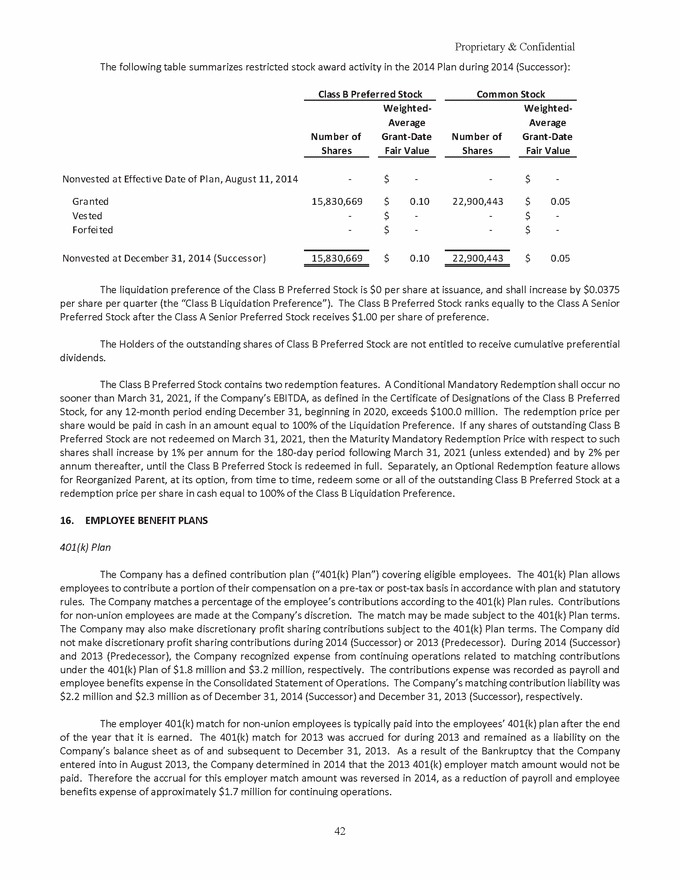
Proprietary & Confidential Defined Benefit Pension Plan The Company provides a defined benefit pension plan (the “Pension Plan”) covering eligible employees of one of its subsidiaries, primarily those covered by collective bargaining arrangements. Eligibility is achieved upon the completion of one year of service. Participants become fully vested in their accrued benefit after the completion of five years of service. The Company’s general funding policy is to make annual contributions to the Pension Plan as required by the Employee Retirement Income Security Act (“ERISA”). The Company did not make any contributions during 2014 (Successor) or 2013 (Predecessor). The following table shows a reconciliation of changes in the Pension Plan’s benefit obligation and plan assets for 2014 (Successor) and 2013 (Predecessor) (in thousands): Successor Predecessor Year Ended December 31, 2014 2013 Change in benefit obligation: Benefit obligation at beginning of period Service cost Interest cos t Plan participants ‘ contributions Benefits paid Actuarial loss (gain) Benefit obligation at end of period (Successor) Change in plan assets: Fai r value of plan as sets at beginning of period Actual return on plan as sets Employer contributions Benefits paid Pl an participants ‘ contributions Fair value of plan assets at end of period (Successor) Funded status at end of period (Successor) $ 20,213 2,208 1,081 21 (67) $ 21,906 2,226 933 - (51) 1,671 (4,801) 25,127 20,213 16,589 821 - (67) 21 14,355 2,285 - (51) - 17,364 16,589 $ (7,763) $ (3,624) Amounts recognized in the Consolidated Balance Sheet totaling $7.8 million and $3.6 million as of December 31, 2014 (Successor) and December 31, 2013 (Successor), respectively, were classified as noncurrent liabilities. Amounts in accumulated other comprehensive loss, before income taxes, that have not been recognized as net periodic benefit cost as of December 31, 2014 (Successor) consist of $2.1 million of accumulated net actuarial losses. Prior to the Company’s emergence from Chapter 11 bankruptcy protection, the amount in accumulated other comprehensive income, before income taxes, that had not been recognized as net periodic benefit cost as of December 31, 2013 (Predecessor) consisted of $3.5 million in accumulated net actuarial gains. As part of fresh start accounting, accumulated other comprehensive income was eliminated. Accordingly, as of December 31, 2013 (Successor), accumulated other comprehensive (loss) income is $0. The accumulated benefit obligation for the Pension Plan was $21.6 million and $14.5 million as of December 31, 2014 (Successor) and December 31, 2013 (Successor), respectively. 43
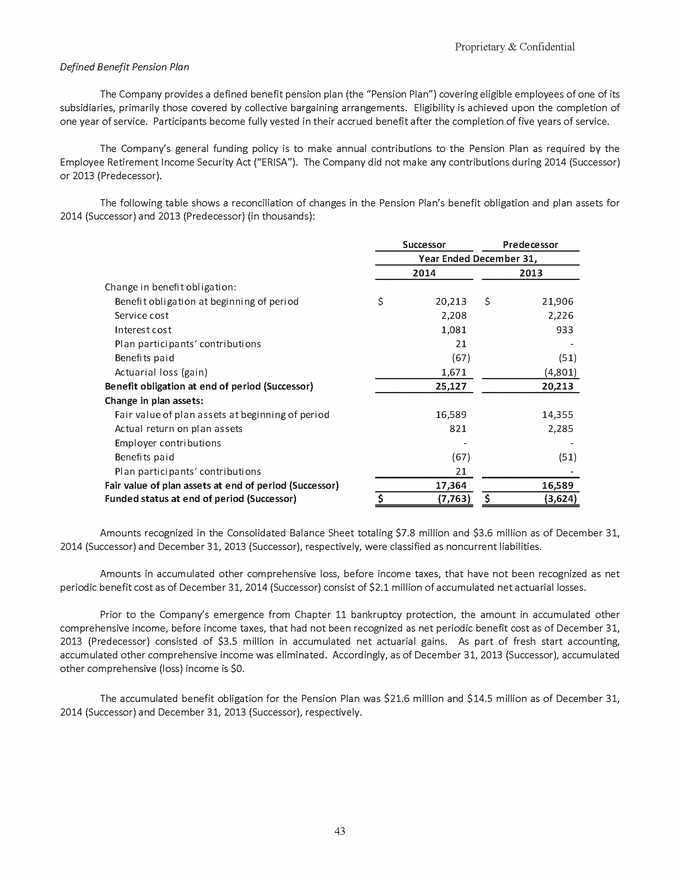
Proprietary & Confidential The components of net periodic benefit cost and other amounts recognized as comprehensive loss (income) are as follows (in thousands): Successor Predecessor Year Ended December 31, 2014 2013 Net periodic benefit cost Service cos t Interest cost Expected return on plan as sets Net periodic benefit cost (a) Other changes in plan assets and benefit obligations recognized as other comprehensive loss (income) Net loss (gain) Net gain recognized during the period Total recognized in other comprehensive loss (income) (b) Total recognized as net periodic benefit cost and other comprehensive loss (income) $ 2,208 1,081 $ 2,226 933 (1,241) (1,072) $ 2,048 $ 2,087 $ 2,091 $ (6,011) - 21 $ 2,091 $ (5,990) $ 4,139 $ (3,903) (a) Net periodic benefit cost for 2013 (Predecessor) does not include the $21,000 of net gain recognized through other comprehensive income. (b) In the Consolidated Statement of Changes in Stockholder’s Equity, the adjustment to accumulated other comprehensive loss in 2014 (Successor) was net of an income tax benefit of $0 and the adjustment to accumulated other comprehensive gain in 2013 (Predecessor) was net of an income tax provision of $2.3 million related to the net gain. The assumptions used to determine the Company’s benefit obligation as of December 31, 2014 and December 31, 2013 were: December 31, 2014 2013 Di s count rate Rate of increase in compensation levels 4.35% 2.00% 5.36% 4.00% The new mortality tables (RP-2014) and mortality improvement scale (MP-2014) issued during October 2014 by the Society of Actuaries were utilized in determining the Company’s benefit obligation as of December 31, 2014. 44
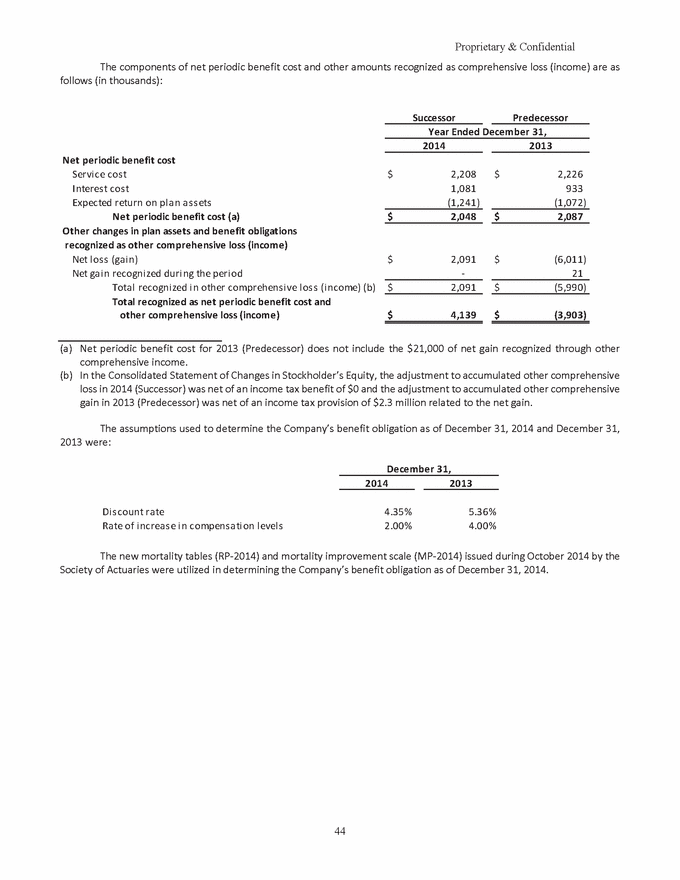
Proprietary & Confidential The assumptions used to determine the Company’s net periodic benefit cost for 2014 (Successor) and 2013 (Predecessor) were: Successor Predecessor Year Ended December 31, 2014 2013 Di s count rate Rate of increase in compensation level s Expected long-term rate of return on assets 5.36% 4.00% 7.50% 5.21% 4.00% 7.50% In 2013 (Predecessor), the Company changed its model to determine the discount rate from using the spot rate of a theoretical corporate bond portfolio to using a rate link yield curve, as it provides a more reasonable estimate of the present value of the required cash flow. The resulting discount rate is reflective of both the current interest rate environment and the Plan’s distinct liability characteristics. In developing the expected long-term rate of return assumption, management evaluated the outputs of financial models designed to simulate results under multiple investment scenarios and to estimate long-term investment returns based on the Pension Plan’s asset allocation. The Company’s Pension Plan target and actual asset allocation as of December 31, 2014 (Successor) and December 31, 2013 (Successor) by asset category are shown below: Actual December 31, 2014 (Successor) Allocation Actual December 31, 2013 (Successor) Allocation Target Allocation Asset allocation: Equity securities Debt securities Real estate Total 60% – 70% 25% – 40% 5% – 15% 57.7% 34.0% 8.3% 58.0% 33.9% 8.1% 100.0% 100.0% 100.0% The Company invests in a diversified portfolio to ensure that adverse or unexpected results from a security class will not have a detrimental impact on the entire portfolio. The portfolio is diversified by asset type, performance and risk characteristics, and number of investments. Asset classes and ranges considered appropriate for investment of the Pension Plan’s assets are determined by the Pension Plan’s investment committee. The asset classes include domestic and foreign equities, emerging market equities, domestic and foreign investment grade and high-yield bonds and domestic real estate. Plan Assets The Company has adopted the fair value provisions (as described in Note 5) for the plan assets of its defined benefit pension plan. The Company categorizes plan assets within a three level fair value hierarchy. Plan assets consist of Separate Accounts that invest in multiple underlying securities. In some cases, the inputs used to measure fair value might fall in different levels of the fair value hierarchy. The level in the fair value hierarchy within which the fair value measurement in its entirety falls is determined based on the lowest level input that is significant to the fair value measurement in its entirety. The following is a description of the valuation methodologies used for assets measured at fair value: Level 1 investments are stated at fair value as determined by quoted market prices on the last business day of the fiscal year. 45
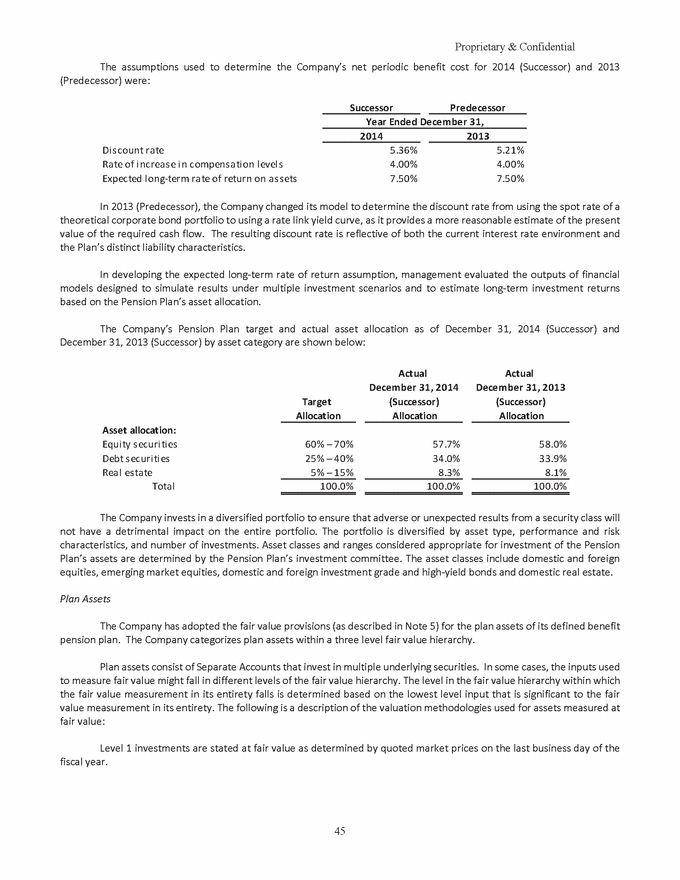
Proprietary & Confidential Investments stated at estimated fair value using significant observable inputs (Level 2) include: - Domestic equity securities: initial purchase price for newly issued securities not yet actively trading, share price of underlying security, terms (rights and warrants) represent observable input which is used in calculation of estimated fair value; - International equity securities: multi-factor regression model is used to adjust quoted market prices; and - U.S. government and U.S. corporate debt securities: multi-dimensional relational model, plus: 1) option adjusted spread model (if redemption option), 2) floating rate model (if floating/variable) or 3) sensitivity analysis to how traded compared to how equities trade (if convertible), or other proprietary pricing models using observable inputs. Investments stated at estimated fair value using significant unobservable inputs (Level 3) include: - Real estate: discounted models utilizing information from brokers on market rents and sales comparables for similar assets, as well as applicable cash flows generated by the property. The fair values of the Pension Plan assets as of December 31, 2014 (Successor) by asset class are as follows (in thousands): December 31, 2014 (Successor) Quoted Prices in Active Markets for Identical Assets (Level 1) Significant Other Observable Inputs (Level 2) Significant Unobservable Inputs (Level 3) Total Measured at Fair Value Equity securities: Domestic large-cap Domestic s mal l - and mi d-cap International Total equity securities Debt securities: U.S. government U.S. corporate Total debt securities Realestate Total plan assets $ 6,018 1,558 $ 6,018 1,558 $ - - $ - - 2,448 2,193 255 - 10,024 9,769 255 - 887 5,009 887 592 - 4,417 - - 5,896 1,444 1,479 373 4,417 - - 1,071 $ 17,364 $ 11,621 $ 4,672 $ 1,071 The following table presents the changes in Level 3 Pension Plan assets for 2014 (Successor) (in thousands): Successor Net Transfers Into/(Out of) Level 3 Fair Value at December 31, 2013 Gain on Plan Assets (a ) Net Purchases/Sales Fair Value at December 31, 2014 Realestate Total $ 991 $ 119 $ (39) $ - $ 1,071 $ 991 $ 119 $ (39) $ - $ 1,071 (a) Unrealized gain on Level 3 Pension Plan assets was approximately $119,000 for 2014 (Successor). 46

Proprietary & Confidential The fair values of the Pension Plan assets as of December 31, 2013 (Successor) by asset class are as follows (in thousands): As of December 31, 2013 (Successor) Quoted Prices in Active Markets for Identical Assets (Level 1) Significant Other Observable Inputs (Level 2) Significant Unobservable Inputs (Level 3) Total Measured at Fair Value Equity securities: Domestic large-cap Domestic small - and mid-cap International Total equity securities Debt securities: U.S. government U.S. corporate Total debt securities Realestate Total plan assets $ 5,743 1,460 $ 4,580 1,460 $ 1,163 - $ - - 2,424 2,175 249 - 9,627 8,215 1,412 - 5,063 562 2,946 562 2,117 - - - 5,625 1,337 3,508 346 2,117 - - 991 $ 16,589 $ 12,069 $ 3,529 $ 991 The following table presents the changes in Level 3 Pension Plan assets for 2013 (Predecessor) (in thousands): Predecessor Net Transfers Into/(Out of) Level 3 Successor Fair Value at December 31, 2012 Gain on Plan Assets (a ) Net Purchases/Sales Fair Value at December 31, 2013 Realestate Total $ 944 $ 118 $ (71) $ - $ 991 $ 944 $ 118 $ (71) $ - $ 991 (a)Unrealized gain on Level 3 Pension Plan assets was approximately $118,000 for 2013 (Predecessor). The Company does not expect to contribute to the Pension Plan during 2015. Future benefit payments expected to be made from Plan assets are summarized below by year (in thousands): Expected benefit payments: 2015 2016 2017 2018 2019 2020–2024 $ 101 150 204 280 356 3,545 17. COMMITMENTS AND CONTINGENCIES Performance Bonds Certain counties, municipalities and fire districts require the Company to provide a performance bond or other assurance of financial or performance responsibility. The Company may also be required by law to post a performance bond as a prerequisite to obtaining and maintaining a license to operate. As a result, the Company has performance bonds that are renewable annually. The Company had $23.5 million of performance bonds outstanding as of December 31, 2014 (Successor). 47
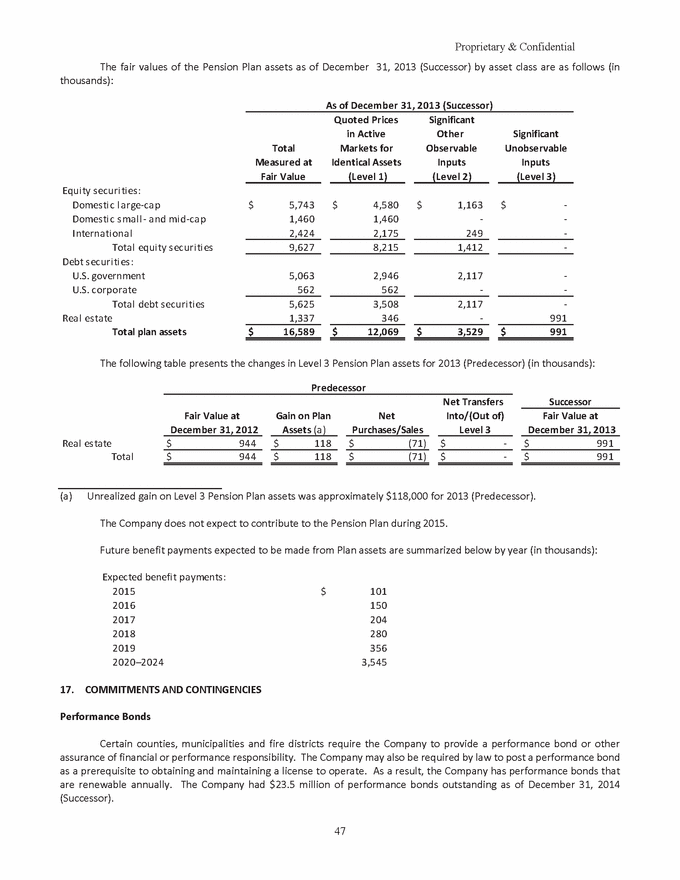
Proprietary & Confidential Operating Leases The Company leases various facilities and equipment under operating lease agreements. Rental expense charged to continuing operations under these leases (including leases with terms of less than one year) was $18.6 million and $21.1 million in 2014 (Successor) and 2013 (Predecessor), respectively. Minimum rental commitments under non-cancelable operating leases for each of the years ending December 31 are as follows (in thousands): 2015 2016 2017 2018 2019 Thereafter $ 12,046 10,330 8,615 7,513 6,462 22,275 $ 67,241 Indemnifications The Company is a party to certain customer agreements entered into in the ordinary course of business pursuant to which it may be obligated to indemnify other parties for certain liabilities that arise out of or relate to the subject matter of the agreements. Some of the agreements entered into by the Company require it to indemnify other parties against losses due to property damage including environmental contamination, personal injury, failure to comply with applicable laws and regulations, the Company’s negligence or reckless or willful misconduct, or breach of representations, warranties and covenants. Additionally, some of the Company’s customer agreements require the Company to provide certain assurances related to the performance of its services. Such assurances may obligate the Company to (i) pay penalties for failure to meet response times or other requirements, (ii) lease, sell or assign equipment or facilities (either temporarily or permanently, and in compliance with the Anti-Kickback Statute) in the event of uncured defaults or other certain circumstances, or (iii) provide performance bonds or letters of credit issued in favor of the customer to cover damages resulting, under certain circumstances, from the Company’s default. With respect to such performance bonds, the Company also is required to indemnify the surety company for losses paid as a result of any claims made against such bonds. The Company and its subsidiaries provide for indemnification of directors, officers and other persons in accordance with limited liability agreements, certificates of incorporation, by-laws, articles of association or similar organizational documents, as the case may be. In addition, the Company has entered into indemnification agreements with certain members of management of the Company. The Company maintains directors’ and officers’ insurance, which may enable it to recover a portion of any future amounts paid, although there can be no assurance that the coverage provided by such policies would be applicable to particular claims made against the Company or that amounts available under such policies would be sufficient to satisfy fully the Company’s payment obligations. In addition to the above, from time to time the Company provides standard representations, warranties and covenants to counterparties in contracts in connection with various commercial matters including sales of its securities and the engagement of financial advisors, and also provides indemnities that protect the counterparties to these contracts in the event they suffer damages as a result of a breach of such representations, warranties and covenants, or in certain other circumstances. While the Company’s future obligations under certain agreements may contain limitations on liability for indemnification, other agreements do not contain such limitations, and under such agreements it is not possible to predict the maximum potential amount of future payments due to the conditional nature of the Company’s obligations and the unique facts and circumstances involved in each particular agreement. Historically, payments made by the Company under any of these indemnities have not had a material effect on the Company’s business, financial condition, results of operations or cash flows. Additionally, based on facts and circumstances currently known to the Company, other than the matters 48
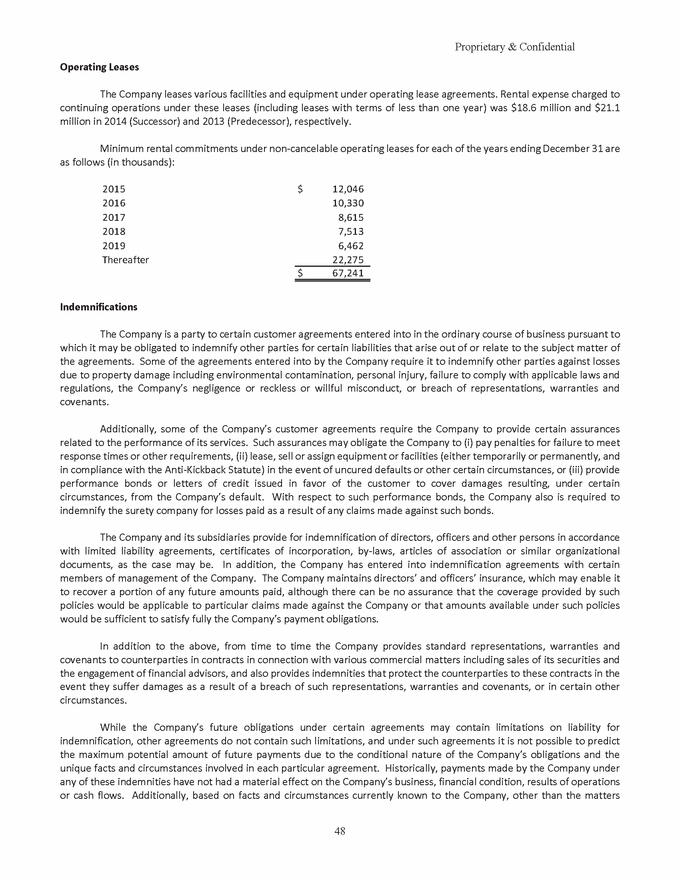
Proprietary & Confidential described in the Legal Proceedings below, it does not believe that any amounts that it may be required to pay under these indemnities in the future will be material to the its business, financial condition, results of operations or cash flows. Legal Proceedings From time to time, the Company is a party to, or otherwise involved in, lawsuits, claims, proceedings, investigations and other legal matters (collectively referred to as “legal matters”) that have arisen in the ordinary course of conducting its business. The Company is unable to reasonably estimate the outcome of any of these legal matters to which it is a party, or in which it is otherwise involved, due to, among other things, the inherent uncertainties of legal proceedings in general. The Company is also subject to requests and subpoenas for information in independent investigations. An unfavorable outcome in any of the legal matters pending against the Company could result in substantial potential liabilities and may have a material adverse effect on the Company’s business, financial condition, results of operations and cash flows. Further, these legal matters, and the Company’s actions in response to them, could result in substantial potential liabilities, additional defense and other costs, increase the Company’s indemnification obligations, divert management’s attention, and/or adversely affect the Company’s ability to execute its business and financial strategies. Other than the matters described below, the Company does not believe the outcome of any of these investigations or audits would have a probable material adverse effect on the Company’s financial position, results of operations or cash flows. Southwest Ambulance Pension Plan Grievance On April 14, 2014, an Arbitrator issued a ruling over a grievance filed by the union representing employees covered by the collective bargaining arrangement. The issue presented to the Arbitrator at the hearing on April 25-26, 2013, was whether or not the Company violated the collective bargaining agreement by providing benefits under the Company’s Southwest Ambulance Pension Plan that were less than those benefits required to be provided under the agreement. The Arbitrator ruled that the Company violated the collective bargaining agreement by providing a lesser benefit than required, but disagreed with the Union’s interpretation of the level of benefits. The collective bargaining agreement with the Union expired in 2012. The parties have been negotiating a successor agreement, and part of this negotiation involves addressing the arbitration decision. The current proposal by the Company is to implement the arbitration decision and freeze both participants and benefits going forward. The negotiations are ongoing, and the Company is currently unable to predict the ultimate outcome of the negotiations. Santa Clara County Employee Termination Grievance The Company is currently in arbitration with the union that represents the Company’s employees in Santa Clara County in California related to a class grievance filed by the union. The grievance involves the termination of certain employees and final written warnings to certain other employees related to conduct violations. A hearing on the merits of the grievance is scheduled for June 2015. If the Arbitrator were to rule that the employees were not discharged for just cause, potential backpay payable to the employees could be up to $2.0 million. At this time it is not possible to predict the ultimate outcome of this matter. Regulatory Compliance The Company is subject to numerous laws and regulations of federal, state and local governments. These laws and regulations include, but are not limited to, matters such as licensure, accreditation, government healthcare program participation requirements, reimbursement for patient services and Medicare and Medicaid fraud and abuse. Within the healthcare industry, government investigations and allegations concerning possible violations of fraud and abuse statutes and regulations by healthcare providers is ongoing. From time to time, the Company is subject to investigations relating to Medicare and Medicaid laws pertaining to its industry. The Company cooperates fully with the government agencies that conduct these investigations. Violations of these laws and regulations could result in exclusion from government healthcare programs together with the imposition of significant fines and penalties, as well as significant repayment obligations for patient services previously billed. Additionally, the Company initiates its own investigations and conducts audits to examine compliance with various policies and regulations, including periodic reviews of the levels of service and corresponding rates the Company bills to various payers. Internal investigations or audits may result in significant repayment obligations for patient services previously billed or the modification of estimates relating to reimbursements. The Company believes that it is substantially in compliance with the anti-fraud and abuse statutes, and their applicable governmental interpretation. Other 49
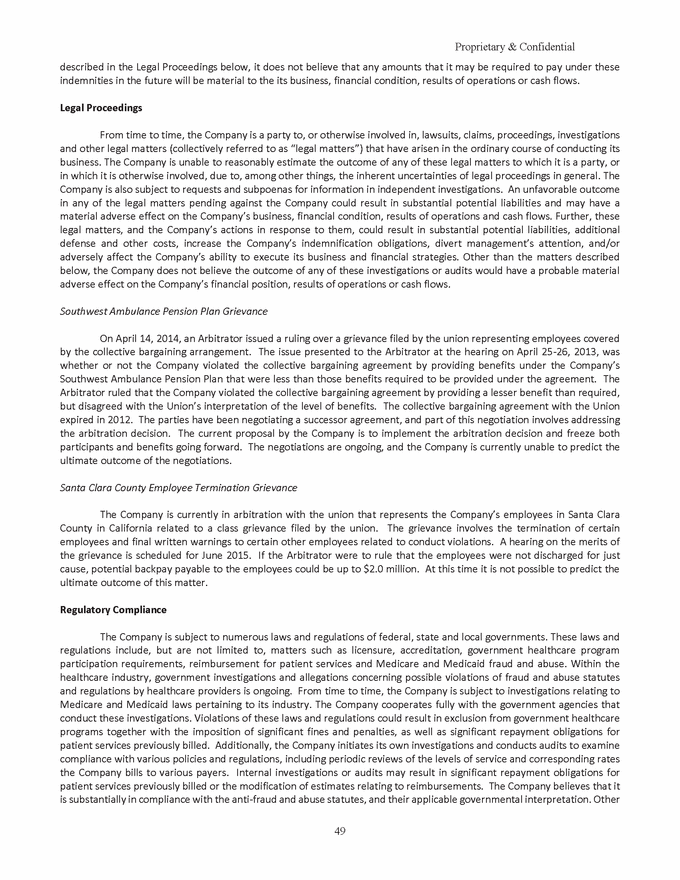
Proprietary & Confidential than the matters described below, the Company believes the outcome of any of these investigations or audits would not have a material adverse effect on the Company’s financial position, results of operations or cash flows. OIG Investigation – Buffalo An Office of Inspector General (“OIG”) records request dated December 10, 2012, was sent to Mercy Hospital in Buffalo, New York pertaining to interfacility specialty care transports provided by the Company. The Company provided the requested documentation. Subsequently, on April 14, 2014, the Company received a subpoena from the U.S. Department of Justice Western District of New York, requesting additional information, and in March of 2015 the investigation was expanded to include the Company’s Ohio and Kentucky markets. The Company is in the process of providing the additional documents in response to the subpoena and will continue to cooperate with the investigation. The Company is not aware of any specific action or claims. U.S. Attorney’s Office Subpoena – Tennessee The U.S. Attorney’s Office issued a criminal subpoena on July 9, 2013. The subpoena requested patient care reports for transports provided in Germantown, Tennessee. The Company produced documents on August 30, 2013, in response to the subpoena. The Company is not aware of any specific action or claims. DEA Diversion Investigation - Louisville, Kentucky On March 17, 2014, the Louisville, Kentucky operations discovered that there were several vials of a controlled substance missing. The operations management and medical director submitted a timely notice to the DEA reporting the suspected diversion of a controlled substance. Subsequently, on March 25, 2014, the DEA conducted a site investigation and the matter has been settled with the U.S. Attorney’s Office in Kentucky. There were no financial penalties or exclusion actions taken in settling this matter. U.S. Attorney’s Office Civil Investigative Demand – Arizona and Rural/Metro of San Diego On January 8, 2015, the U.S. Attorney’s Office for the District of Arizona issued a Civil Investigative Demand (“CID”) for records pertaining to ambulance transports provided by the Company’s San Diego and Arizona markets. The CID does not provide any information regarding specific allegations or claims being made. The Company is working with outside counsel to respond to the CID, but at this time is unaware of any potential liability. Department of Health and Human Services Office of the Inspector General – Colorado On March 27, 2015, the Department of Health and Human Services issued a Request for Information or Assistance to the Company’s Arvada, Colorado location. The request does not indicate any specific allegation against the Company. The Company is working with outside counsel to respond to the request and is not aware of any potential liability at this time. 18. CONCENTRATION OF CREDIT RISK Financial instruments, which potentially subject the Company to concentrations of credit risk, consist principally of cash and cash equivalents, restricted cash, accounts receivable and letters of credit. The Company places its cash with, and obtains its letters of credit from, federally insured institutions and monitors the amount of credit exposure with any one institution. Concentrations of credit risk with respect to accounts receivable is limited by the large number of customers and their geographical dispersion. 19. DISCONTINUED OPERATIONS In August 2014, the Company made the decision to exit the Indiana market (except for the New Albany market in southern Indiana). Notices were given to the various municipalities in accordance with the respective contracts. Because the operations in this market are considered a separate component of the Company, their results of operations are reported as discontinued operations in the Consolidated Statement of Operations for 2014 (Successor) and the comparable 2013 (Predecessor) period. 50
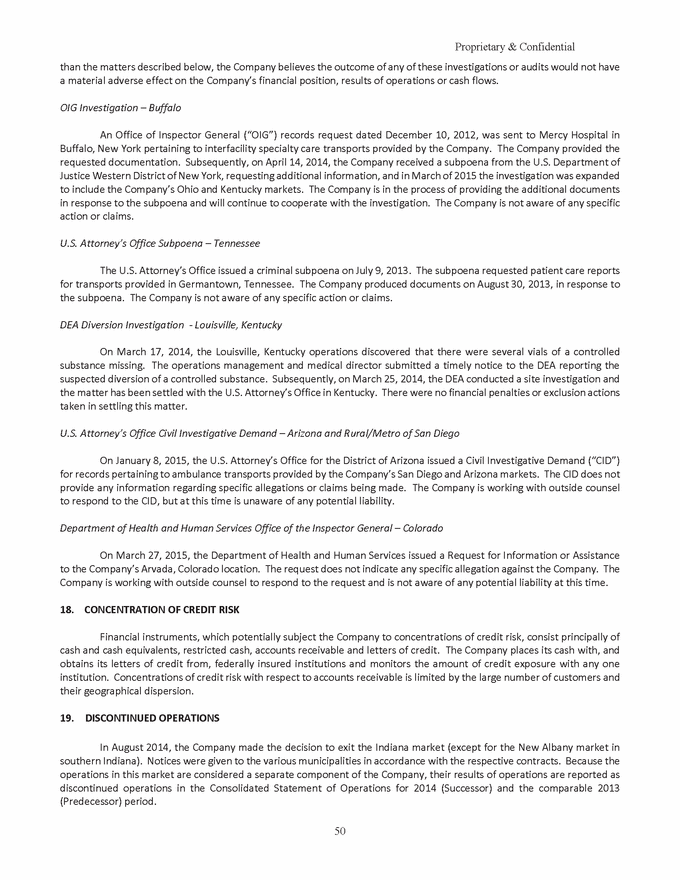
Proprietary & Confidential Revenue and loss from discontinued operations for 2014 (Successor) and 2013 (Predecessor) were as follows (in thousands): Successor Predecessor Year Ended December 31, 2014 2013 Net revenue from di s continued operations Los s from di s continued operations $ 6,442 (4,178) $ 10,687 (2,325) Loss from discontinued operations is presented net of income tax benefit of $0 and approximately $1.5 million for 2014 (Successor) and 2013 (Predecessor), respectively. 20. SUBSEQUENT EVENTS The Company has evaluated new information and events through April 30, 2015, which is the date these consolidated financial statements were available to be issued, to determine the need to either update these consolidated financial statements or to provide additional disclosures about those events. Except for the information and events disclosed herein, no additional disclosures were deemed necessary by the Company. On February 26, 2015 and March 12, 2015, the Company received $5.0 million and $5.0 million, respectively, in cash from Reorganized Parent as a result of Reorganized Parent’s issuance of 25.0% Class D Senior Redeemable Preferred Stock of Reorganized Parent (“Class D Senior Preferred Stock”). 10,000,000 shares, in aggregate, of Class D Senior Preferred Stock were issued. The liquidation preference of the Class D Senior Preferred Stock is $1.00 per share (the “Class D Liquidation Preference”). The Class D Senior Preferred Stock ranks senior to the Class A Senior Preferred Stock, the Class B Preferred Stock and the Class C Senior Preferred Stock. The $10.0 million of cash received by the Company will be classified as an increase to additional paid-in capital in the Company’s Consolidated Balance Sheets during 2015. As of April 30, 2015, $15.0 million of Class D Senior Preferred Stock had been authorized, and $10.0 million had been issued. The Holders of the outstanding shares of Class D Senior Preferred Stock are entitled to receive, when, as and if declared by Reorganized Parent’s Board of Directors, cumulative preferential dividends on each share of Class D Senior Preferred Stock at a rate per annum equal to 25.0% of the Class D Liquidation Preference of the Class D Senior Preferred Stock, accruing and payable quarterly, in arrears. All dividends will be cumulative from the date of issuance, shall accumulate to the extent they are not paid on a dividend payment date for the quarterly period to which they relate and shall accumulate on a daily basis whether or not dividends are declared by Reorganized Parent’s Board of Directors. Dividends on the Class D Senior Preferred Stock, when, as and if declared by Reorganized Parent’s Board of Directors, shall be paid in additional fully-paid and non-assessable shares of Class D Senior Preferred Stock (“Class D Paid In-Kind Dividends”). The issuance of any such Class D Paid In-Kind Dividend shall constitute full payment of such dividend. The Class D Senior Preferred Stock contains two redemption features. A Conditional Mandatory Redemption shall occur no sooner than March 31, 2021, if the Company’s EBITDA, as defined in the Certificate of Designations of the Class D Senior Preferred Stock, for any 12-month period ending December 31, beginning in 2020, exceeds $100.0 million. The redemption price per share would be paid in cash in an amount equal to 100% of the Liquidation Preference, plus an amount in cash equal to all accrued and unpaid dividends per share. If any shares of outstanding Class D Senior Preferred Stock are not redeemed on March 31, 2021, then the Maturity Mandatory Redemption Price with respect to such shares shall increase by 1% per annum for the 180-day period following March 31, 2021 (unless extended) and by 2% per annum thereafter, until the Class D Senior Preferred Stock is redeemed in full. Separately, an Optional Redemption feature allows for Reorganized Parent, at its option, from time to time, redeem some or all of the outstanding Class D Senior Preferred Stock at a redemption price per share in cash equal to 100% of the Class D Liquidation Preference, plus an amount in cash equal to all accrued and unpaid dividends per share. 51
